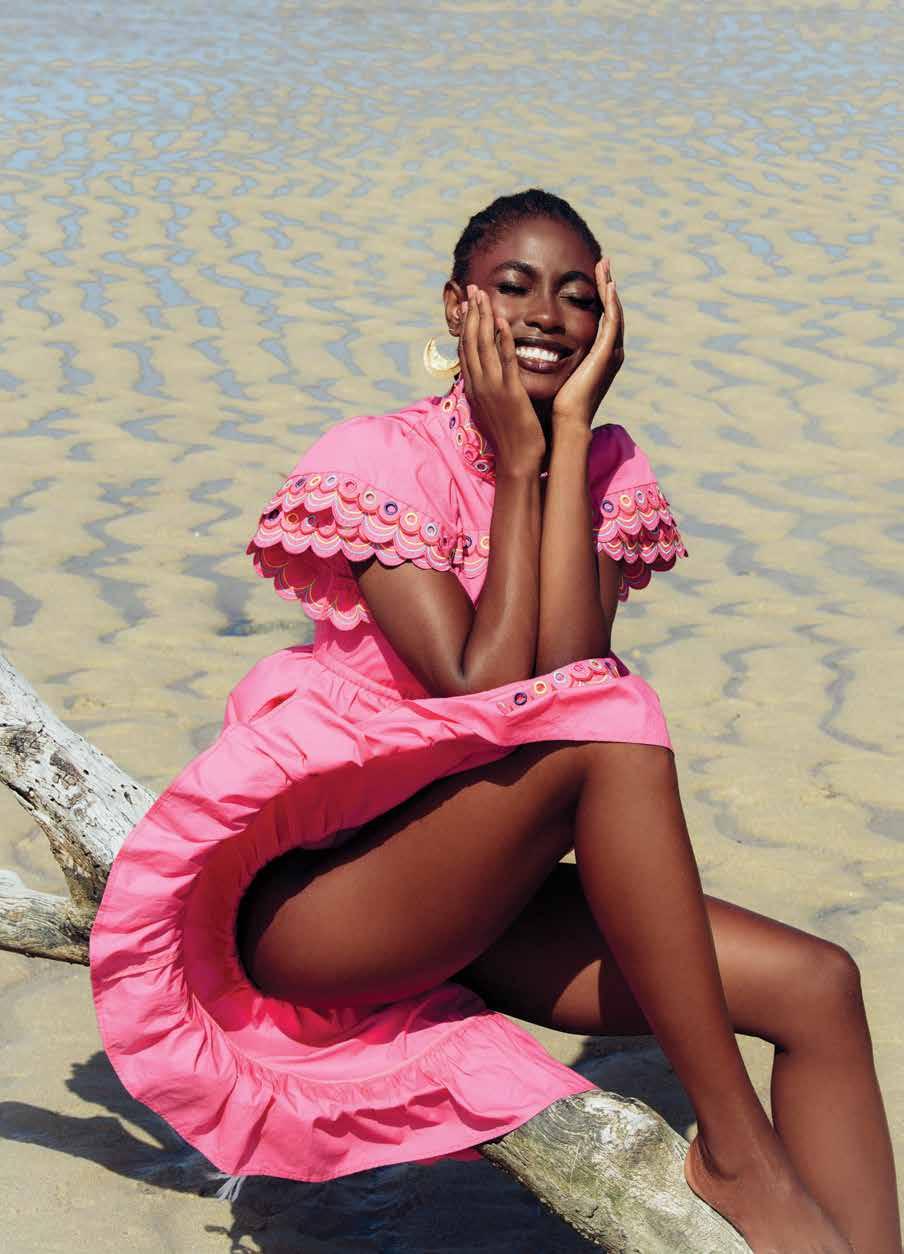
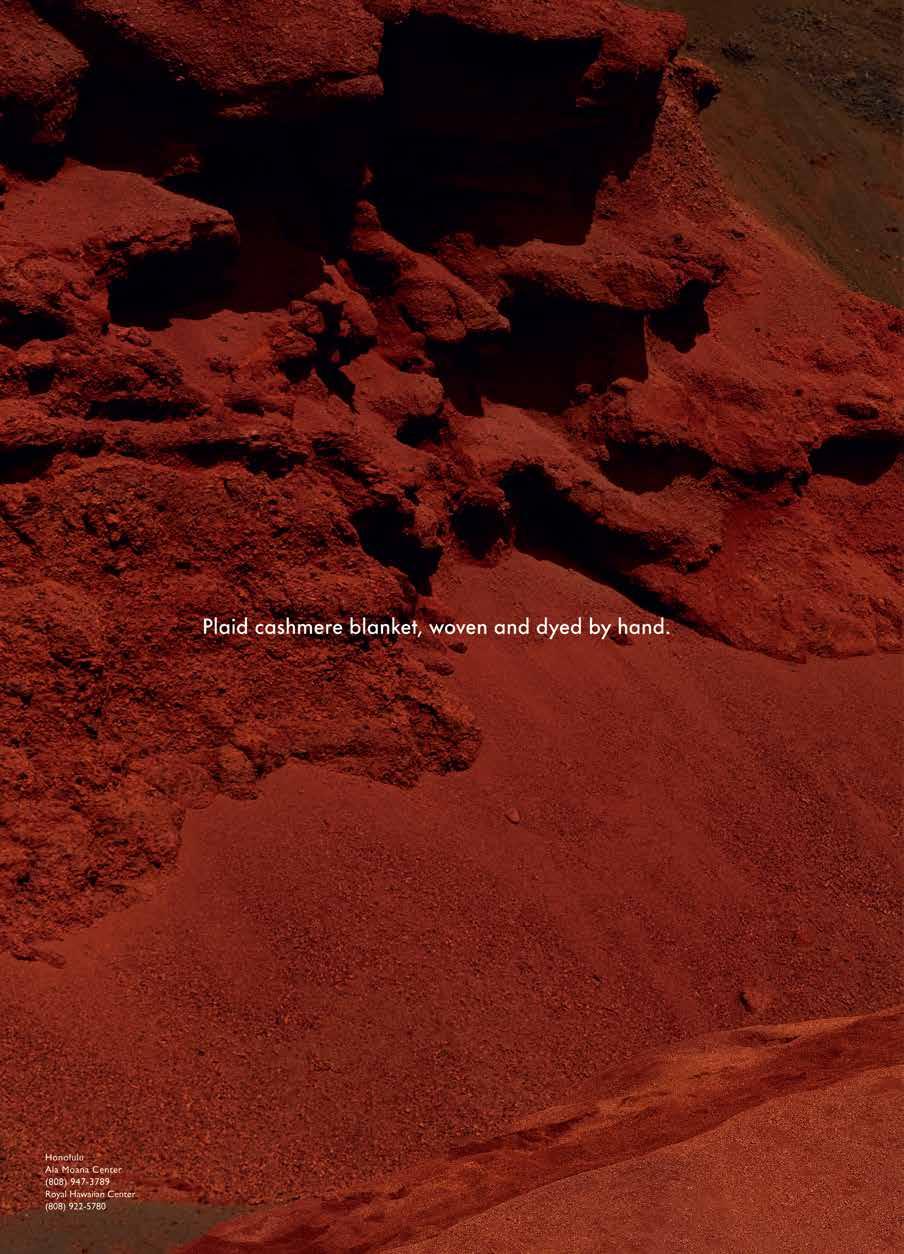

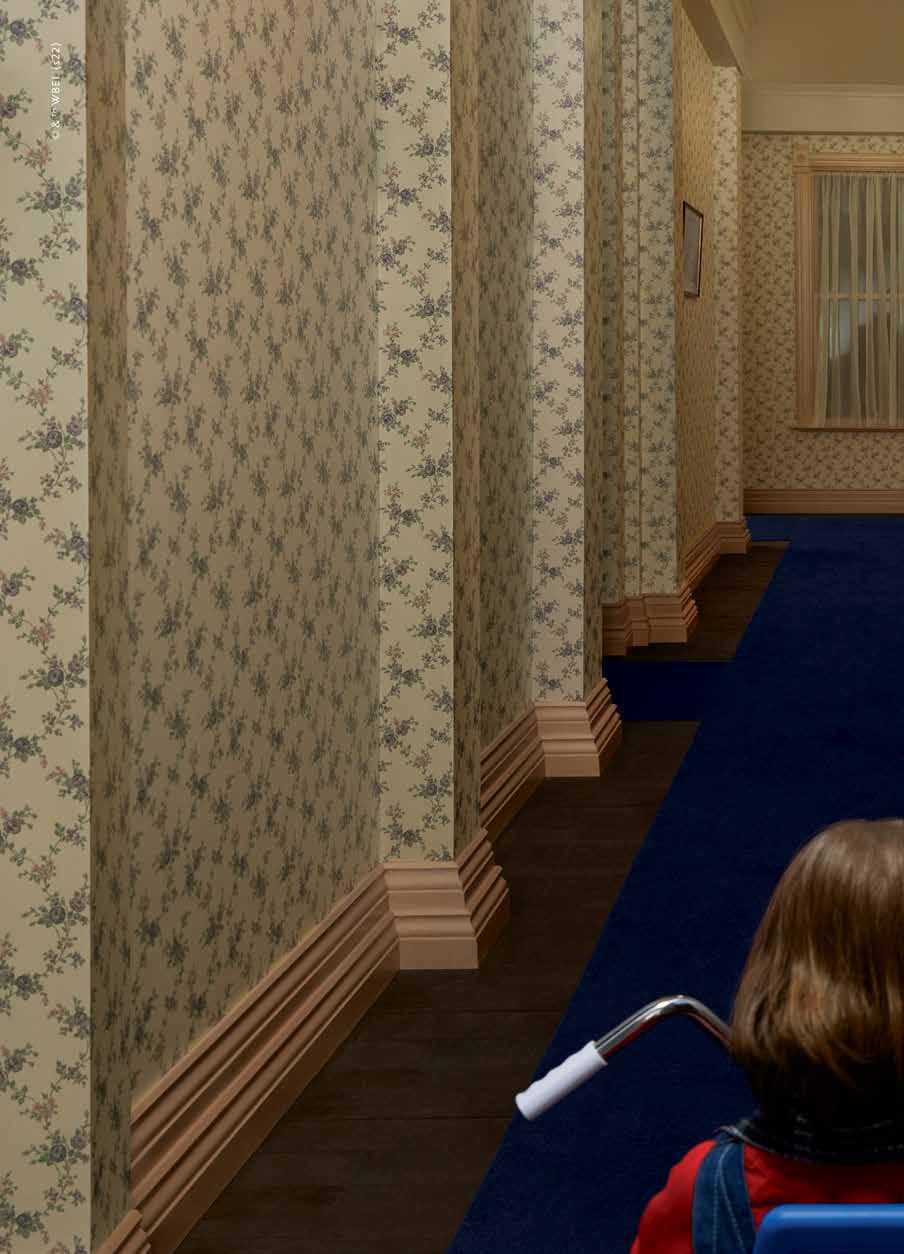


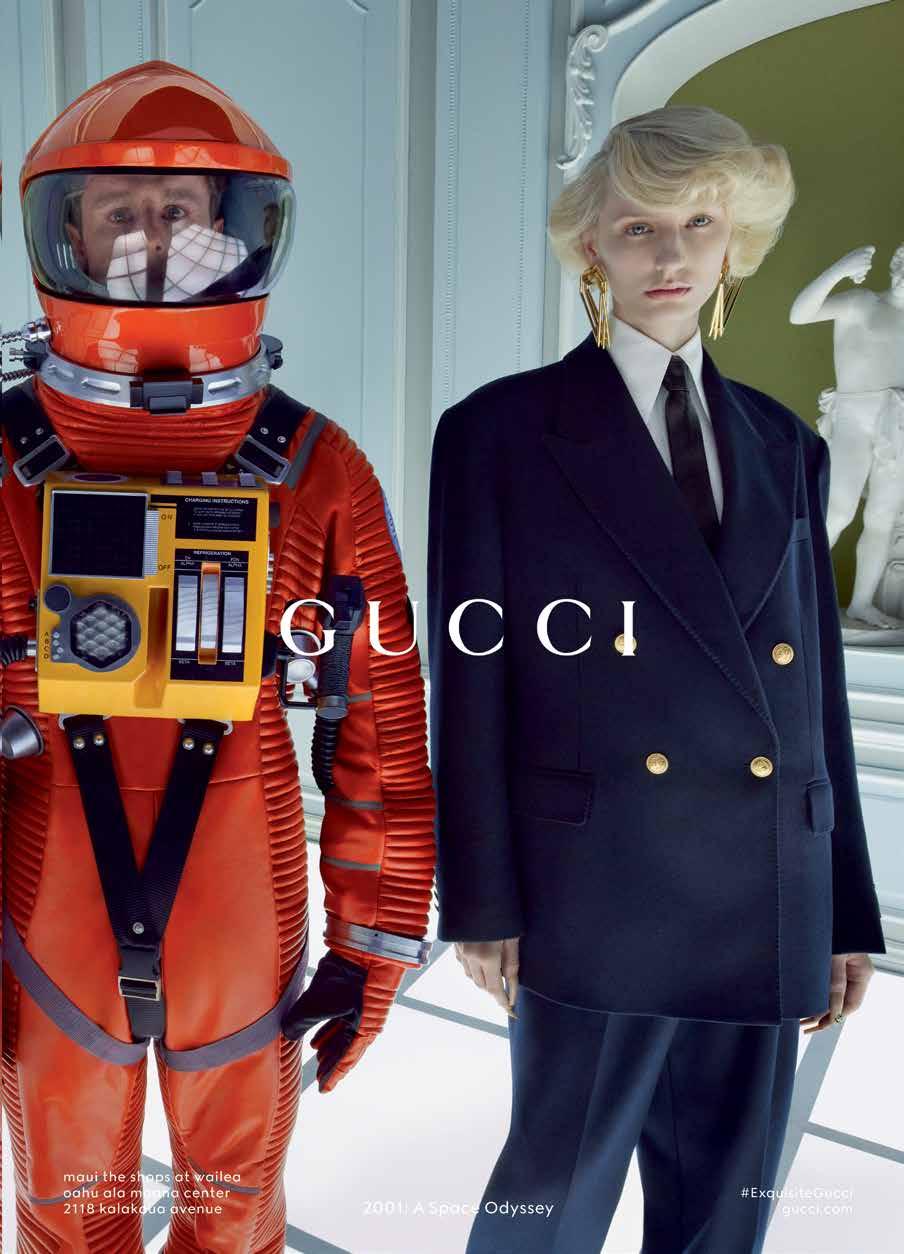

TBD
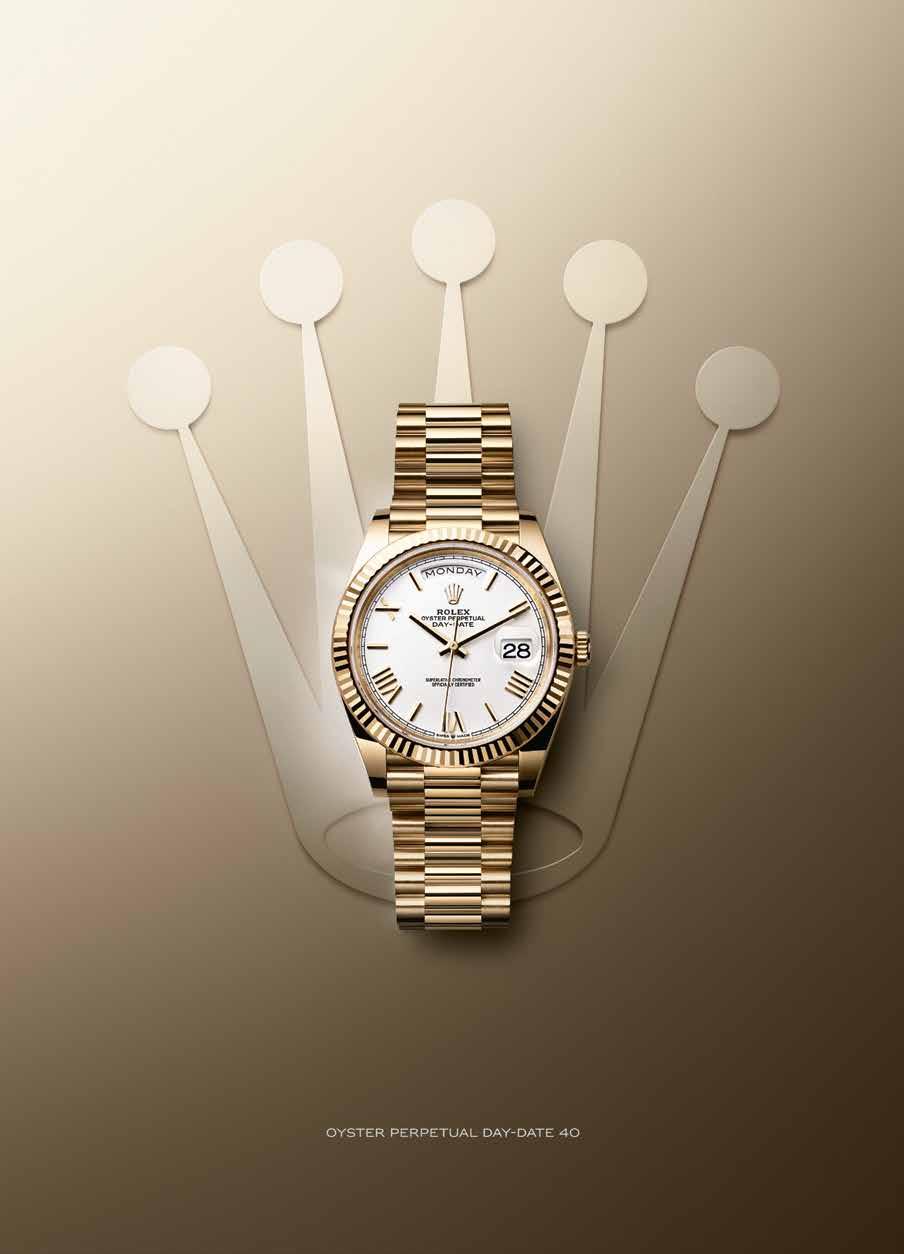
TBD

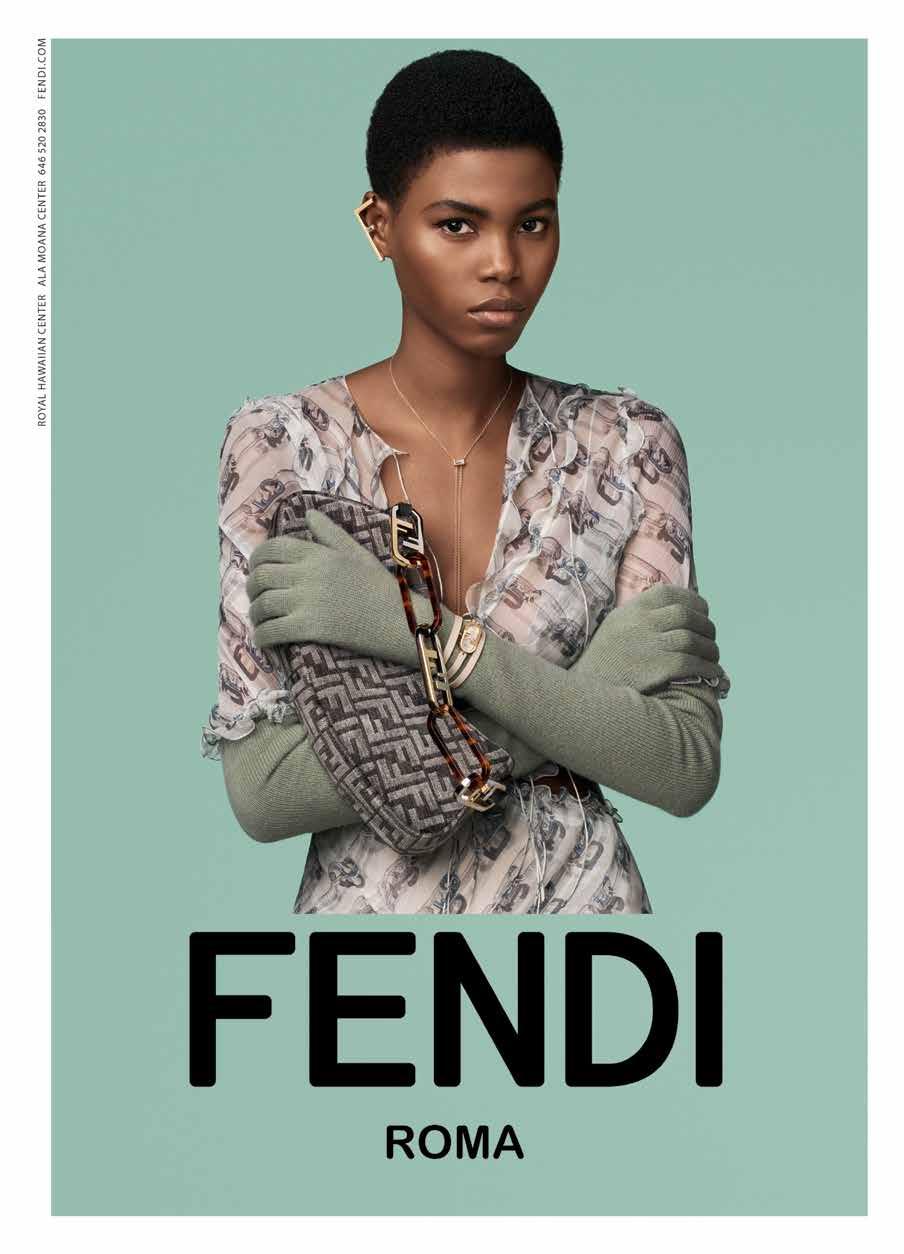


After the profound isolation of the last few years, this issue calls for rediscovering the world around us and examining the invisible tethers that connect us to a place.
Join us as we recall a little-known chapter in the life of Jean-Michel Basquiat, who sought refuge during trying times near the end of his life in the lush and remote corners of Hana, Maui. We also get a glimpse into the inner life of another artist, Kamran Samimi, whose sense of identity and belonging comes from excavating the mysteries of his natural surroundings. Then we travel to a small island in Ke‘ehi Lagoon off the southern shore of O‘ahu, where generations of fishing families have endured persecution to maintain a traditional way of life in the land of their kūpuna (elders).
Also in the pages ahead, a writer recounts the ancient history and modern marvel of Peru’s northern coast, a destination for surfers and the birthplace of some the world’s first surfing vessels, and a young mother reflects on parenthood as she explores equally new frontier on Hawai‘i Island, where a recent volcanic eruption birthed new land in the island’s fertile Puna district. As we contemplate the many ways our world enriches, enthralls, and sustains us, we’re inspired to cherish the places in our own lives that remind us of who we are, where we’re going, and how far we’ve come—and hope that you’re moved to do the same.
深刻な孤立状態が2年以上続いたあとで、今号はわたしたちをとり まく世界の再発見、そして、その土地とわたしたちをつなぐ、目に見 えない絆を検証すべきだと考えました。ジャン=ミシェル・バスキア の人生の、あまり知られていない一幕をともに訪ねましょう。迷い多 い日々のなかで、緑におおわれた、人影のないマウイ島ハナの片隅に つかの間の休息を求めた晩年のバスキア。さらに別のアーティスト、 自分を取り巻く自然の神秘を掘り起こすことで、自分の居場所とアイ デンティティを感じるというカムラン・サミミの内面ものぞいてみま した。オアフ島サウスショアにあるケエヒ・ラグーンに浮かぶ小さな 島にも旅をしました。何世代もそこに暮らす漁師たちが、迫害を乗り 越え、クプナ(年配者)から受け継いだ島独自のライフスタイルを守 ってきた島です。
続いてご紹介するのは、古代の歴史とモダンな驚きに満ちた ペルー北海岸。サーファーたちに人気のこの地は、世界で初めて波 に乗る船が生まれた地でもあります。若い母親は、ハワイ島の新しい 海岸線をたどりながら、子を産み、育てる意味を考えました。近年の 火山の噴火により、新たな大地が出現した肥沃なプナ地区の物語で す。この地球がわたしたちをいかに魅了し、豊かにし、育み続けてくれ ているかを理解すると、自分が生きる場所を慈しむ気持ちが強くな ります。わたしたちは何者なのか。どこに向かっているのか。そして、 今はどの地点にいるのか。わたしたちが生きる場所からのそんな問 いかけに思いを馳せながら、読者の皆さんが同じように考えるきっ かけになることを願っています。
14 LETTER From the Developer

CEO & PUBLISHER
Jason Cutinella
VP BRAND DEVELOPMENT
Ara Laylo
GLOBAL EDITORIAL DIRECTOR
Brian McManus
EDITORIAL DIRECTOR
Lauren McNally
EDITOR-AT-LARGE
Matthew Dekneef
DIGITAL EDITOR
Eunica Escalante
SENIOR EDITOR
Rae Sojot
SENIOR PHOTOGRAPHER
John Hook
DESIGNER
Taylor Niimoto
TRANSLATIONS
Japanese
Eri Toyama Lau
Akiko Shima
Korean AT Marketing
CREATIVE SERVICES
Marc Graser
VP Global Brand Storytelling
Gerard Elmore
VP Film
Sheri Salmon
Creative Services Manager
Kaitlyn Ledzian
Brand Production Manager
Taylor Kondo
Brand Production Coordinator
Blake Abes
Romeo Lapitan
Filmmakers
Jhante Iga
Erick Melanson
Video Editors
Brigid Pittman
Digital Content &
Social Media Manager
ADVERTISING
Mike Wiley
VP Sales
mike@nmgnetwork.com
Courtney Asato
Marketing & Advertising Executive
Nick Lui-Kwan
Account Executive
OPERATIONS
Joe V. Bock
Partner / General Manager - Hawai‘i
Francine Naoko Beppu
VP Integrated Marketing
Gary Payne
VP Accounting
Sabrine Rivera Operations Manager
PUBLISHED BY: NMG Network
36 N. Hotel St. Ste. A Honolulu, HI 96817
PALM is published exclusively for: MACNAUGHTON & KOBAYASHI GROUP © 2022 by Nella Media Group, LLC. All rights reserved. No part of this publication may be reprinted without the written consent of the publisher. Opinions are solely those of the contributors and are not necessarily endorsed by NMG Network.
16
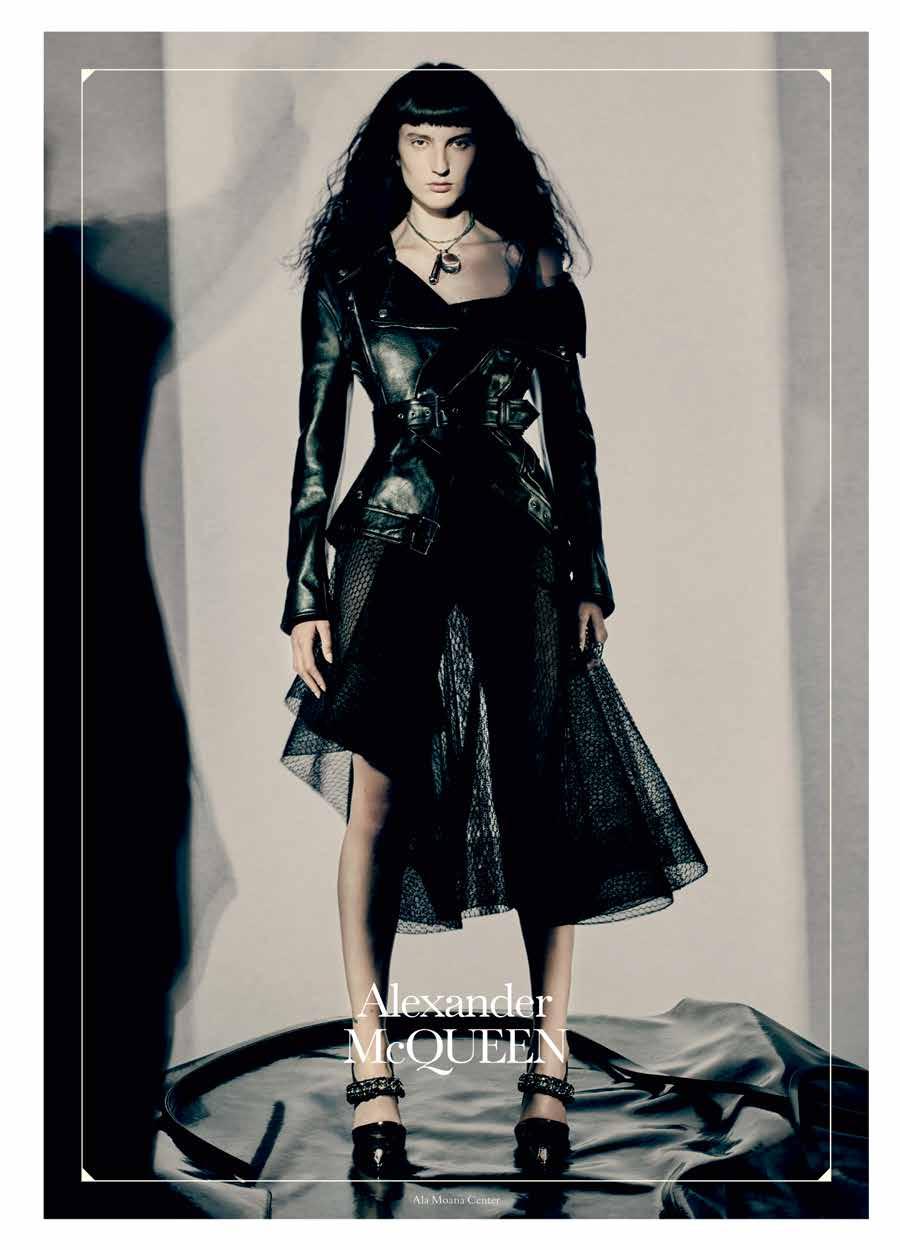

Photographer IJfke Ridgley photographs model Channel Noah at Kuli‘ou‘ou Beach.

102 92 18 TABLE OF CONTENTS ARTS 24 Man Behind the Myth 36 Seeking the Source CULTURE 50 To Build After Fire DESIGN 66 Star of the Sea ESCAPES 80 A Peruvian Provenance 92 Mother Nature FARE 110 Drink It In 114 Shave Vice 120 Thicker Than Water 122 Serenity in Spades 66 ON THE COVER
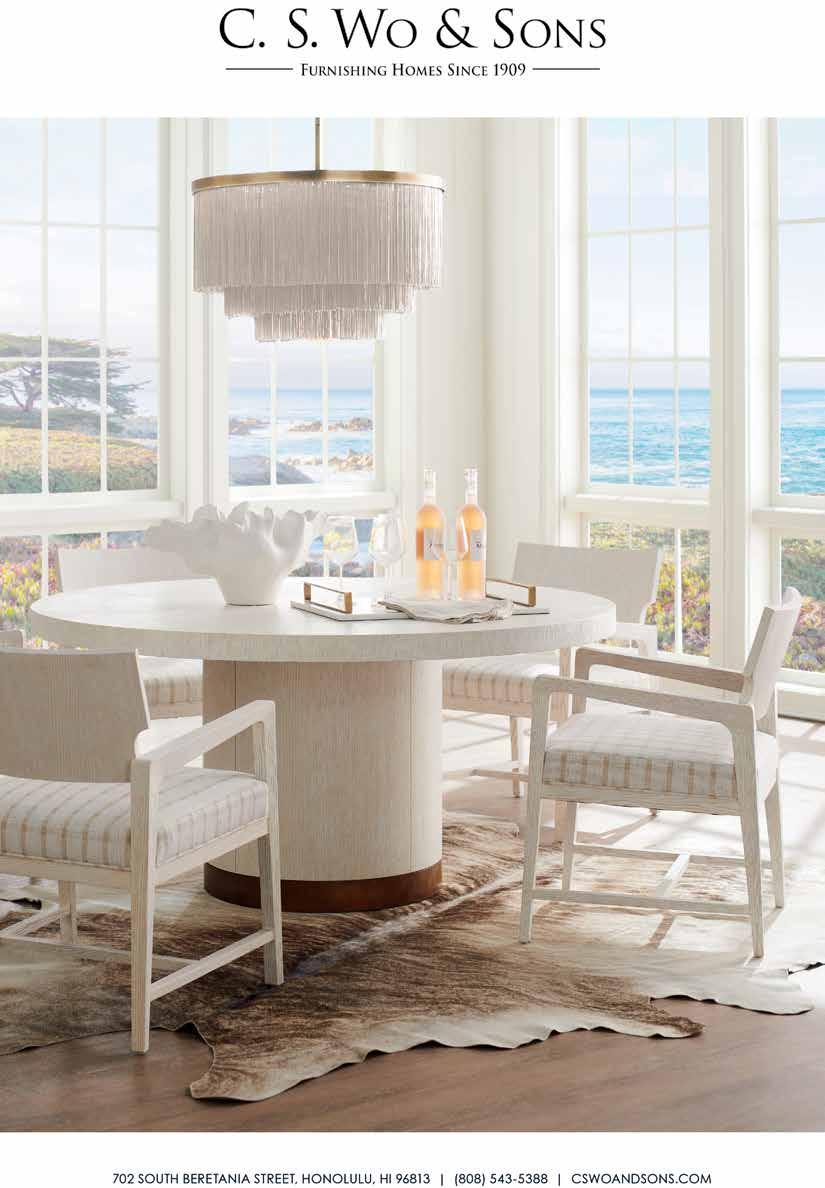
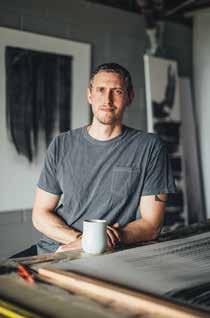
表紙
写真:アイフカ·リッジリー
モデル:シャネル·ノア
撮影場所:クリオウオウ·ビーチ
アート 24
神話の向こうのバスキア 36
原点の追求 文化 50
炎のあとで デザイン 66
海辺のスター
エスケープ 80
ペルー発 波乗りの起源 92
創造する母たち 食 110 やすらぎの一杯 114
削る媚薬 120
水よりも濃いもの 122 これぞ心地よさ
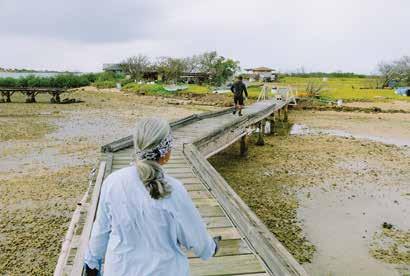
20 36 50 目次

Visual that amplify
notions
AR TS
A PALM アート
the soul
of the city
23
A
PALM PALM
Man Behind the Myth
神話の向こうのバスキア
Text by Mitchell Kuga
文 = ミッチェル·クガ
Images by Jana Dillon, Lee Jaffe, Ivane Katamashvili, Christopher Makos, and courtesy of the Estate of Jean-Michel Basquiat and The Metropolitan Museum of Art/James Van der Zee Archive
写真 = ジャナ・ディロン、リー・ジャッフィー、アイヴァン・カタ マシュヴィリ、クリストファー・メイコス およびエステイト・オ ブ・ジャン=ミシェル・バスキア、メトロポリタン美術館/ジェー ムス・ヴァン・ダー・ジー・アーカイブの提供
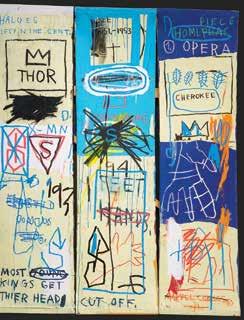
An homage to the jazz musician Charlie Parker, Charles the First (1982), left, was painted during a breakout period in Jean-Michel Basquiat’s career.

24 A PALM
ARTS Jean-Michel

For a few sun-soaked summers on Maui, a rising star of the New York art world found refuge from his life in the public eye.
ニューヨークのアートシーンの新星と呼ばれたジャン=ミシェル・ バスキア。人々の視線にさらされる日常から逃れて、太陽の光あふ れるマウイ島でいくつかの夏を過ごしました。
Translation by Eri Toyama Lau 翻訳 = ラウ外山恵理
햇빛에 젖은 마우이의 여름안에, 뉴욕 예술
계의 떠오르는 스타는 대중의 눈에서 떠나 그의 삶으로부터 피난처를 찾았다.
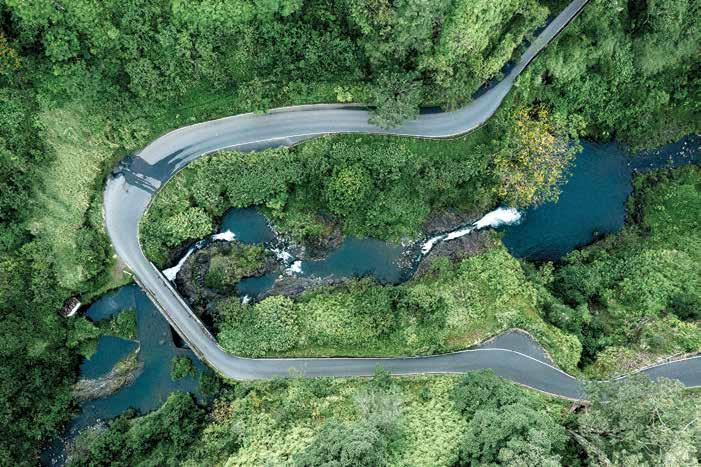
You’d be hard pressed to find an artist more emblematic of New York City’s countercultural spirit in the ’80s than Jean-Michel Basquiat. His paintings, which poetically juxtapose elements of street art, Neo Expressionism, and hip-hop, both reflected and fueled the chaos of New York at the time, helping legitimize graffiti as an art form. But the artist, who died of a heroin overdose in 1988 at the age of 27, found a home in a very different place toward the end of his life: Hana, Maui. Basquiat made visits to the small, remote town on the eastern edge of Maui during the summers between 1984 and 1988—a seeming refuge from the pressures of
’80年代ニューヨークを席巻したカウンターカルチャーの精神を誰よりも象徴 するアーティストがジャン=ミシェル・バスキアだ。ストリートアートのエレメン ツと新表現主義、ヒップホップを詩的に並べた彼の作品は、当時のニューヨー クのカオスに満ちたムードを反映すると同時に加速させ、落描きが芸術として 認められるのに一役買った。1988年、ヘロインの過剰摂取により27歳の若さ で他界したバスキアだが、その晩年にはニューヨークとは似ても似つかない場 所、マウイ島ハナで心のやすらぎを見出していた。 1984年から1988年にかけて、夏が来るたびに彼はマウイ島の東端に ある、人影まばらなこの小さな町を訪れた。ニューヨークのアートシーンの中心
PALM 26
A ARTS Jean-Michel

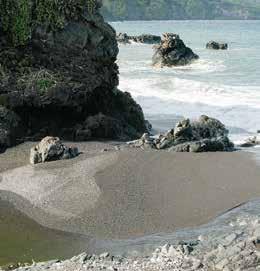
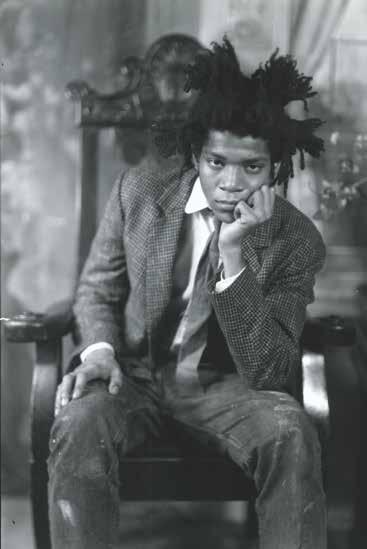
repeat visits to
between 1984 and 1988,
Jean-Michel Basquiat made
Maui
finding a seeming refuge from the pressures of having catapulted to the red-hot center of the New York City art scene.

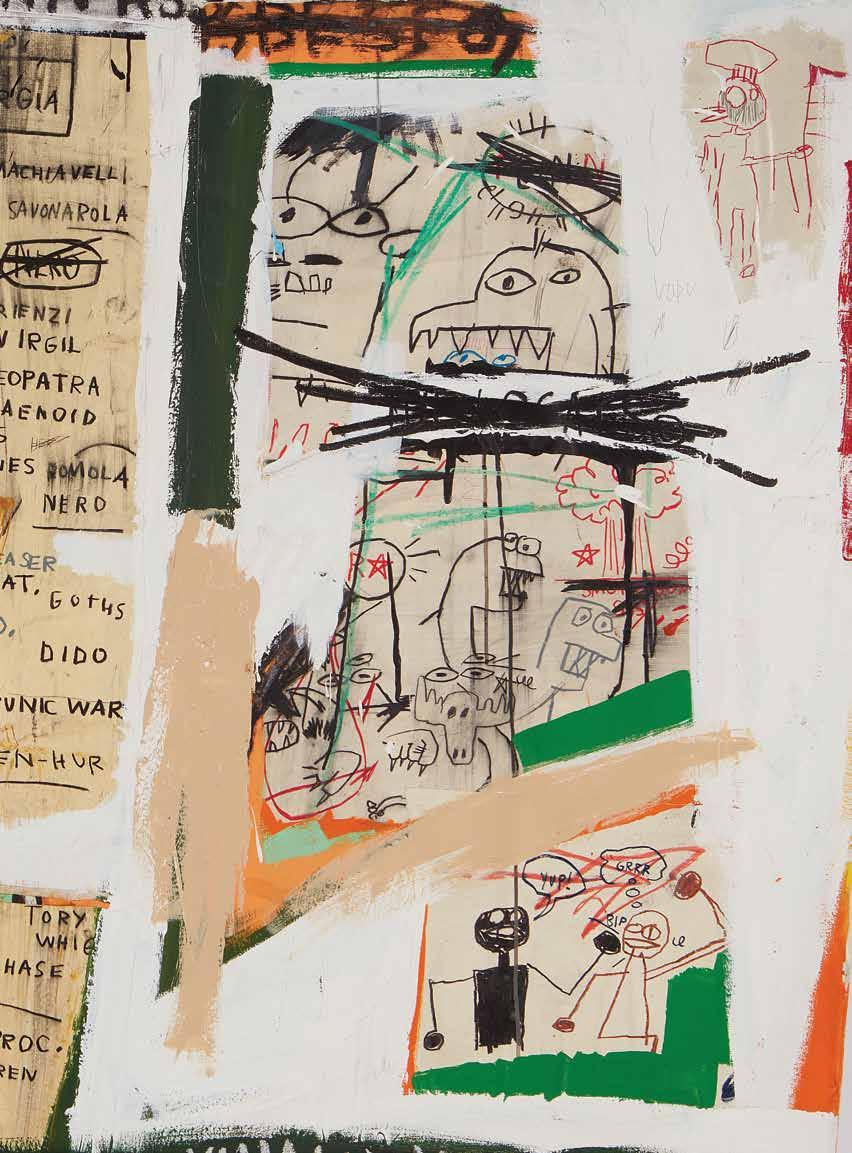
having catapulted to the red-hot center of the New York art world, which coincided with an increasingly dangerous drug habit. Myke-Embe Cappadona didn’t know any of this when he encountered Basquiat sometime in the early ’80s on Hana Highway, the beautifully twisting and often terrifying road that separates Hana from the rest of Maui.
As he recounts in an essay titled “Jean-Michel & Basquiat,” Cappadona was walking along the highway selling pot, flashing baggies at anyone driving by with long hair; Basquiat, who remembered buying pot from Cappadonna on a previous visit, was cruising by with friends. They pulled over, bought some weed, and shared a joint on the side of the road, talking story about New York, where Cappadona lived shortly after serving in the Marine Corps. “I don’t recall much of the details of our conversation,” Cappadona writes, “but I do remember that they were a bunch of happy guys having a goof in a beautiful place, enjoying their life, just like I was.”
Born one month apart on opposite sides of the Hudson River—Cappadona in New Jersey, Basquiat in Brooklyn—the two became fast and easy friends. “Each and every visit we had together would revolve around smoking cannabis,” he writes. “I would take him to some gorgeous place which we referred to as ‘joint points,’ either a place to swim in one of the many streams around Kipahulu, or somewhere with a breathtaking view.”
Throughout their friendship, Cappadona had no idea that Basquiat was an internationally renowned artist; for a while his lodging, a foam pad in a mutual friend’s fruit shack, suggested otherwise. But there were clues. He noticed the “prankster” constantly writing or scribbling on things: scraps of paper lying around Cappadona’s car; Cappadona’s window, in crayon; an antique cabinet that had belonged to Cappadona’s weaving mentor. “Often these writings said some peculiar things,” Cappadona writes, noting that most of Basquiat’s “doodles” ended up in the trash.
Cappadona did eventually ask Basquiat what he did in New York, and he responded without hesitating: “I am a painter.”
“I paint houses too sometimes,” Capadonna replied. “But I don’t like it. It’s a shitty job.” Basquiat smiled, happy to be just another guy in Hana.
Basquiat did create at least two formal paintings while in Maui: Rusting Red Car in Kuau, and Cash Crop Both were painted during his first trip to Hana, in 1984, and reveal the artist at the height of his transition into Neo Expressionism; prior to that, in the late ’70s, Basquiat
で時代の寵児と呼ばれるプレッシャーから逃れたかったのだろうか。それは、 薬物使用の習慣がますます悪化していく時期とも重なっていた。’80年代前 半、美しいカーブを描きながらマウイ島のほかの地域とハナの町を切り離す、 スリルに満ちたハイウェイ沿いで彼に初めて出会ったマイク=エンベ・カパドナ さん。当時の彼は、バスキアのそんな事情を何も知らなかった。 “ジャン=ミシェルとバスキア”と題する回想録に描かれているとおり、カ パドナさんはそのときハナ・ハイウェイ沿いを歩いて大麻を売っていた。長髪を なびかせたドライバーが通りすぎるたび、大麻の入った小袋をちらつかせてい たわけだ。仲間とのんびりドライブしていたバスキアは、以前カパドナさんから 大麻を買ったのを覚えていた。一行は車をとめて大麻を買い求め、道端で一服 分かち合いながら、カパドナさんがかつて海兵隊の除隊後につかの間暮らした ニューヨークのことなど、たわいもない会話を交わした。“どんな話をしたか、ほ とんど覚えていない”カパドナさんは書いている。“彼らはただ美しい景色のな かで陽気にはしゃぎ、人生を謳歌している愉快な連中というだけで、わたしもま たそのひとりだった”
カパドナさんはニュージャージー州、バスキアはニューヨーク州のブルッ クリン。ハドソン川を隔てた場所にひと月違いで生を受けたふたりは、ごく自然 に、あっという間に親しくなった。“(バスキアが)マウイを訪れるたびに、一緒に 大麻を吸った。キパフル近辺の、泳ぐのに適した川辺だったり、息をのむような 絶景が見渡せる場所だったり、われわれが“ジョイント・ポイント”と名づけたご きげんな場所に彼を案内した” 親しくつきあいながら、カパドナさんはバスキ アが国際的なアーティストであることなど露ほども知らずにいた。仲間の家の 果物小屋で、簡易マットレスに寝泊まりするバスキアの姿からはとても想像で きなかったのだ。だが、ヒントというべきものはあった。“悪ガキ仲間”のバスキ アは、つねに何かにものを書いたり描いたりしていたそうだ。カパドナさんの車 に散らかっている紙きれに何か書きつけたり、カパドナさんの家の窓にクレヨ ンで落描きしたり。カパドナさんのやしの葉編みの師匠の家の、古いキャビネッ トのガラス扉にも何か描いていたそうだ。“たいていわけのわからない言葉の羅 列だった”こうした“落描き”の多くは、ごみとして捨ててしまった、とカパドナさ んは書いている。
そのうちにカパドナさんも彼がニューヨークでどんな仕事をしているの かと尋ねたが、バスキアは躊躇なく答えたそうだ。“ペインターだよ” 英語でペインターといえば“絵描き”を指すこともあれば”ペンキ職人” を指すこともある。てっきり“ペンキ職人”だと思ったカパドナさんはこう返し た。“住宅のペンキならオレもときどき塗るけど、ぱっとしないな。つまらない 仕事だよ”
30 PALM
A ARTS Jean-Michel
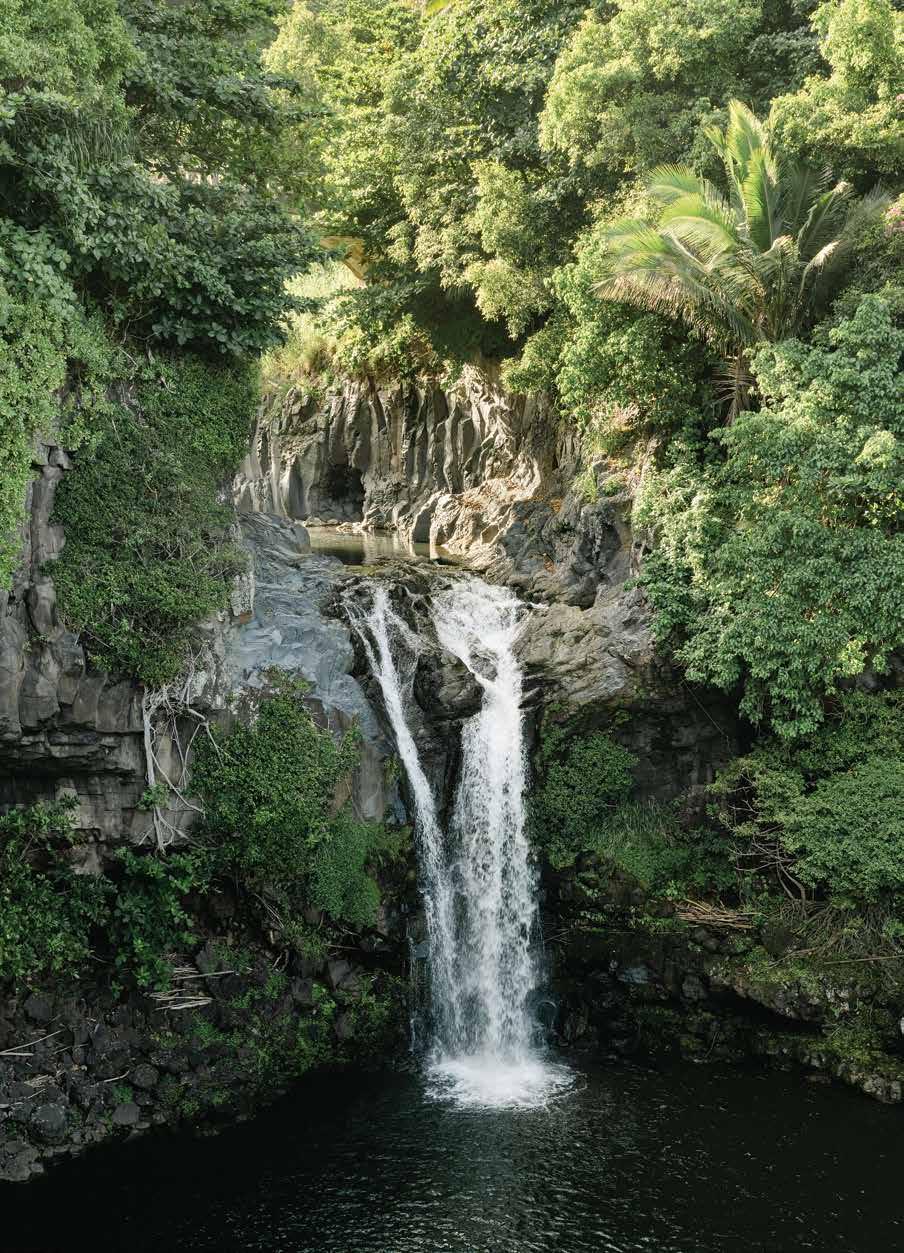
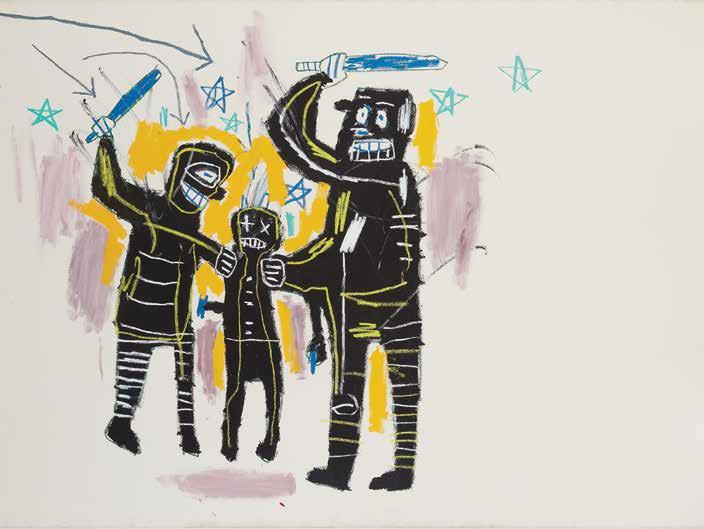
Juxtaposing elements of street art, Neo Expressionism, and hip-hop, Basquiat’s work offers scathing commentary on racism, police brutality, and other social issues of his time.
was best known as half of the graffiti duo SAMO, an abbreviation of “same old shit.” Rusting Red Car in Kuau builds upon a motif that appears frequently throughout Basquiat’s work: an automobile. Critics have suggested that this recurring image is an allusion to the trauma Basquiat endured when he was hit by a car as child, which resulted in a month-long stay at the hospital. The motif has also been interpreted as an image in conversation with his close friend Andy Warhol’s car-crash series from the ’60s.
Cash Crop feels like more of a departure for Basquiat, spacious
バスキアはにこにこ笑っていたそうだ。ただのハ ナの住人のままでいられることがうれしかったの だろう。
マウイ滞在中、バスキアは少なくともふた つの作品を仕上げている。〈クアウの錆びた赤い車 (Rusting Red Car in Kuau)〉と〈金になる作物 (Cash Crop)〉だ。どちらも1984年、バスキアが 初めてハナに滞在した時期に描かれたもので、バス キアはちょうど新表現主義への転向をはかってい るさなかだった。それ以前、1970年代後期までの バスキアは、むしろグラフィティデュオ、Same old shitの略で”SMAO(セイモー。よくあるつまらない もの)”のひとりとして知られていた。〈クアウの錆び
32 PALM A ARTS Jean-Michel
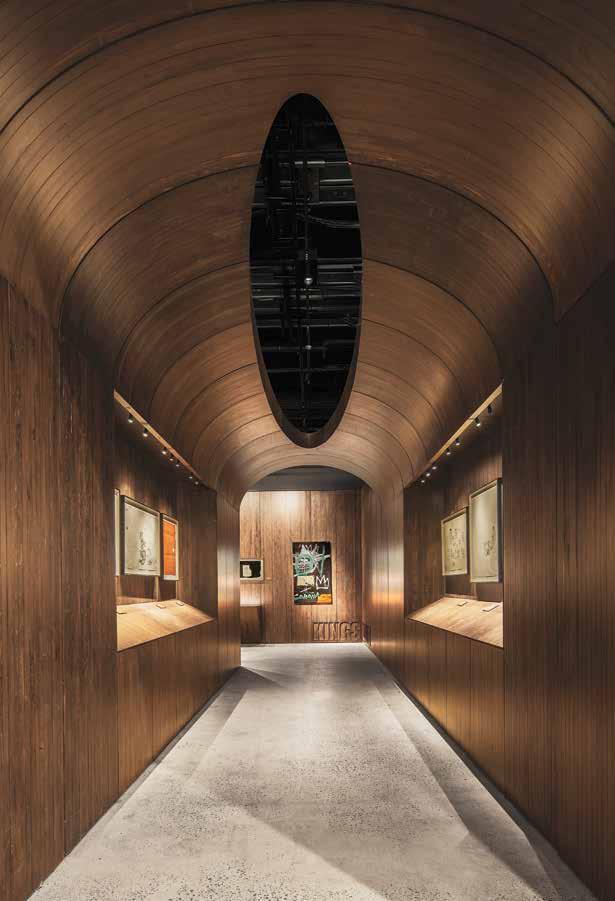
Featuring mostly unseen works and artifacts from
the Basquiat family’s personal collection, the ongoing exhibition Jean-Michel Basquiat: King Pleasure revealed a lesser known side of the artist when it opened in New York City in spring 2022.
in ways that contradict his sensibilities as a maximalist. Its rich, reddish browns are unusually earthy, backed by a baby blue sky and the shaggy green stalks of a sugar cane plant. In the foreground floats a black box labeled “sugar”—a critique of colonialism via the sugar cane plantations that connected places like Haiti, where Basquiat’s father was from, and Hawai‘i.
Basquiat spoke to Cappadona about the racism he experienced in New York as someone perceived as an “urban threat,” and though he initially saw Maui as an escape from that prejudice, it was a fantasy that couldn’t hold. Cappadona recalls a couple of incidents in Hana when Basquiat was called racial slurs, eventually dampening his relationship to Maui.
Cappadona did eventually learn about Basquiat’s career, but it wasn’t until 2000 or 2001, more than 12 years after the artist had died. He was at the library, flipping through an old issue of Art in America when he came across a full-page ad featuring Basquiat and Warhol. Astonished, he went down a rabbit hole of books and movies about the artist’s life, the content of which confused Cappadona. So little about Basquiat’s persona as a rebellious and debauched genius didn’t square with the Jean-Michel that Cappadona knew in Hana—his friend, the “kind-hearted goofball.”
“I now tell people that I never knew Basquiat,” Cappadona writes. “I knew Jean-Michel. There is a big difference.”
た赤い車〉はバスキアの作品に頻繁に登場するモチーフ、車が主題だ。美術評 論家によれば、くりかえし登場する車は、バスキアが子供のときに自動車事故 に遭い、ひと月近く入院したトラウマの現れだとされる。また、親しかった友人、 アンディ・ウォーホールの’60年代の作品、車の事故シリーズの影響を受けて いるとも考えられている。
〈金になる作物〉のほうは、バスキアにとっては旅立ちといった意味が大 きかったのかもしれない。マキシマリストである彼のいつもの作風に反してキャ ンバスは閑散としている。淡い青の空と生い茂る砂糖きびの緑を背景に、いつ になく自然を感じさせる赤みの強い深い茶色。手前に浮かんでいるのは”砂糖” と書かれた黒い箱。バスキアの父親の故郷であるハイチとハワイに共通する、 砂糖きびの大農園が象徴する植民地主義への批判がこめられた作品だ。 バスキアはカパドナさんに、ニューヨークで体験した人種差別の話をし たそうだ。それを”都会の副産物”と考える人もいるし、マウイはそうした偏見と は無縁の地に思えたのかもしれないが、おとぎ話は長くは続かなかった。カパ ドナさんは、ハナ滞在中のバスキアが何度か差別的な中傷を受けていたのを 覚えている。そんなこともあって、バスキアの足は次第にマウイから遠のいてい った。
カパドナさんもやがてバスキアの本当の職業を知るが、それはバスキア がこの世を去って12年以上の歳月が流れた2000年か2001年のことだった。
図書館でなにげなく古い『アート・イン・アメリカ』誌をめくっていたカパドナさ んは、バスキアとウォーホールのページ全面広告に目をとめた。仰天してバス キアに関する本や映画を見あさったカパドナさんは困惑した。反体制的で自堕 落な天才アーティストであるバスキアのイメージは、”心優しくて、いつもふざけ てばかりの”カパドナさんの友達、ハナで出会ったジャン=ミシェルとはかけ離 れていたからだ。
“今は、バスキアのことは知らないと言うことにしている”カパドナさんは書 いた。“ジャン=ミシェルのことなら知っている。ふたりはまったくの別人だった”
34 A PALM
ARTS Jean-Michel
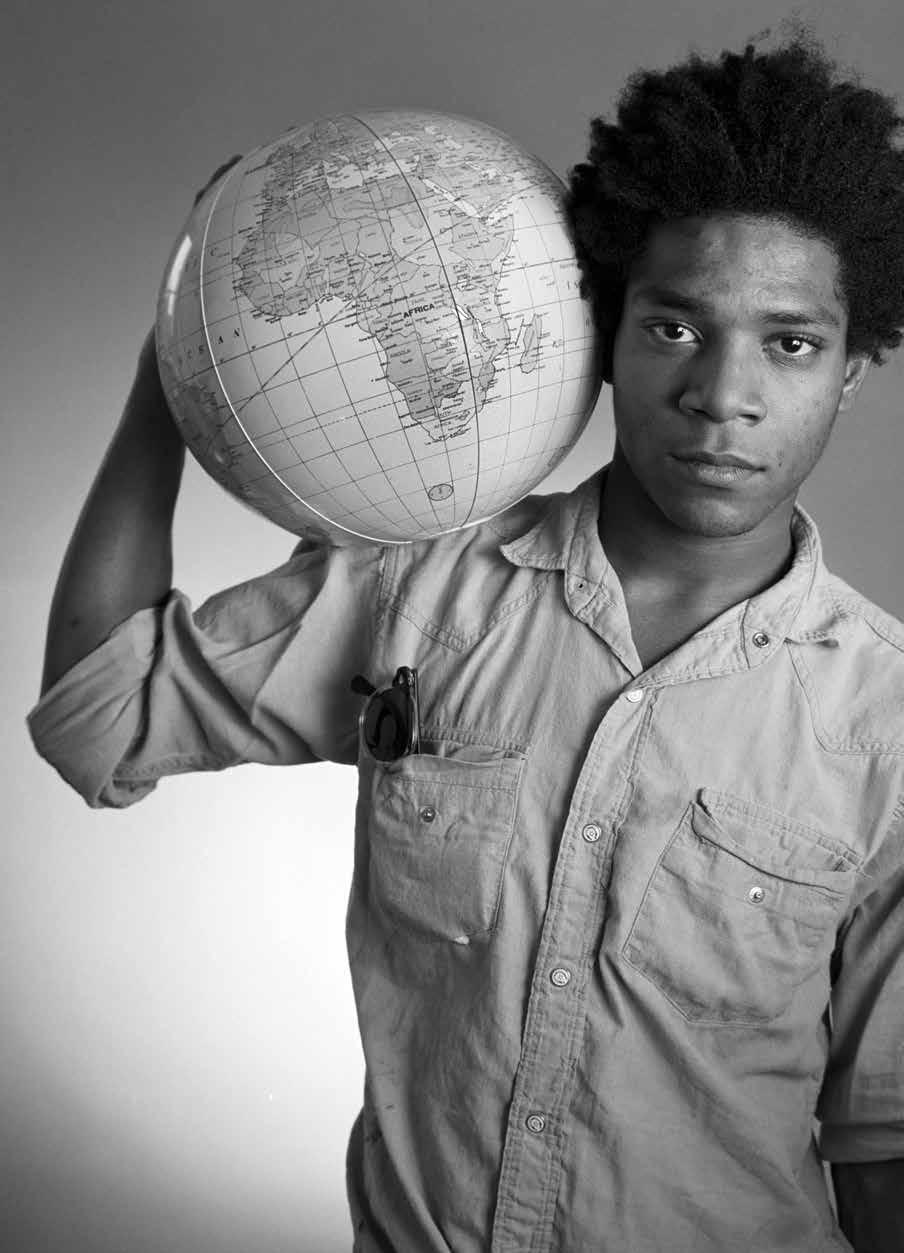
Seeking the Source
36 PALM ARTS Kamran Samimi A
文=スペンサー・ケアラマキア 写真 = マーク·クシミ および一部提供 カムラン·サミミ
原点の追求
Text by Spencer Kealamakia
Images by Mark Kushimi and courtesy of Kamran Samimi
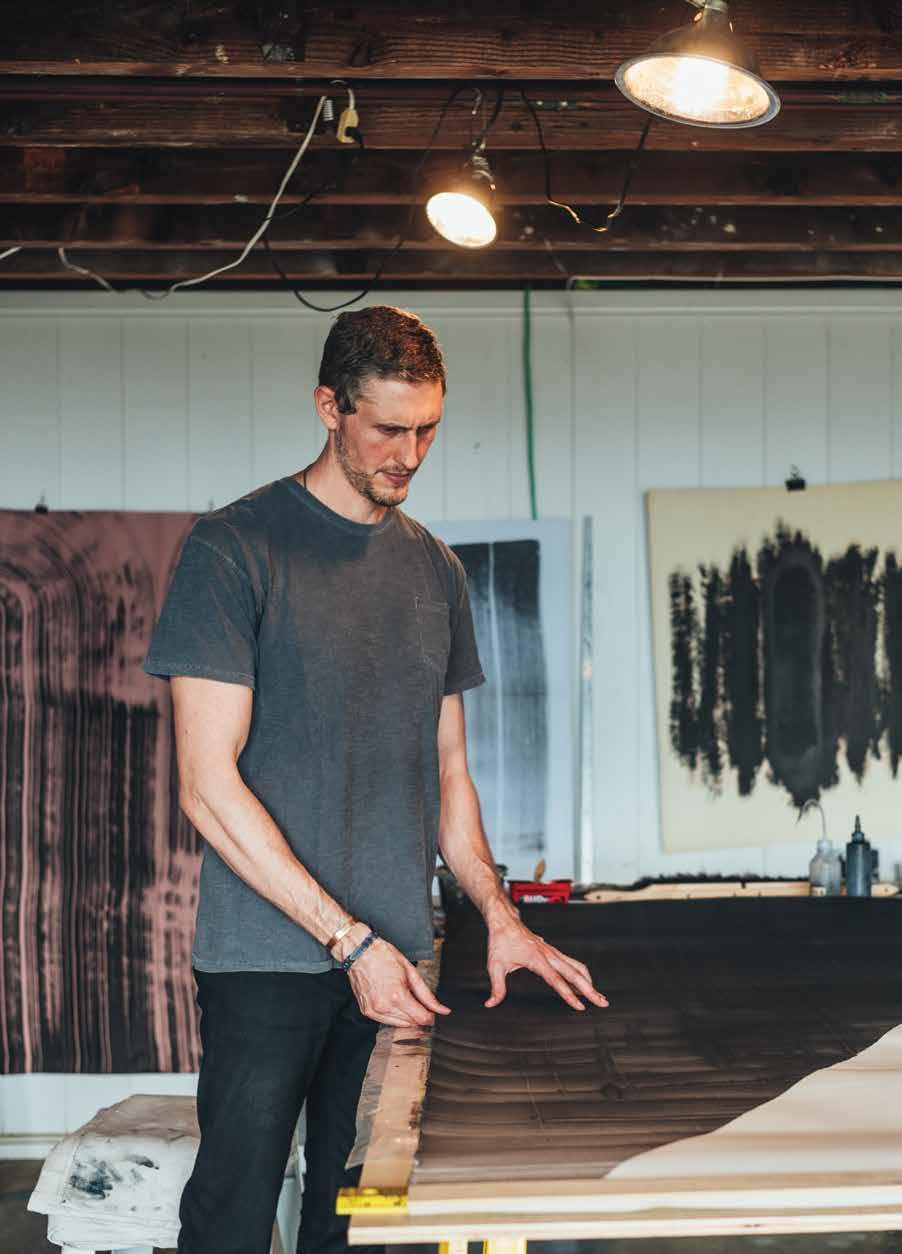
With his elemental artworks, Kamran Samimi explores time, form, and metaphysical truths.
自然を生かした芸術を通じて時間とフォルム、存在の本質を探求 するカムラン・サミミ氏 。

In his series Void Stones (2019), artist Kamran Samimi asks the question: What can be gained when something is removed?
Kamran Samimi’s sculptures remind me of the song “Pōhakuloa.” The song, written and performed by falsetto singer Gary Haleamau, honors Hawai‘i Island’s saddle region, the high plateau between Maunakea and Mauna Loa. Haleamau’s voice pitches higher and higher as he captures the unearthly experience of being 7,000 feet above the sea on ancient lava flows—“pōhaku pele”—and in plaintive Hawaiian he sings the refrain, “Pōhakuloa, nahenahe mai,” meaning “gentle, sweet Pōhakuloa.” It seems an odd way to describe the region’s frigid climate and arid landscape, yet there couldn’t be a more perfect description. The song is a hymn—as mele (songs) and oli (chants) often are—not in praise of Pōhakuloa’s appearance but its essence.
I have the song in mind when I visit Samimi at his workspace on the ground floor of a plantationstyle house in Mānoa. It’s dimly lit, and the still, cool air makes it feel subterranean. Laid out along the wall and on the ground are stones varying in size, shape, and texture, most of them found or salvaged basalt: chunks of sharp a‘ā, knotty pāhoehoe, river stones worn smooth, cinder bits airy like popcorn.
Beyond its geologic connection to the islands, basalt is one of Samimi’s favorite materials to work with because of its endless variations. This is especially true in his sculptural work, a process he describes as a collaboration with nature. “I look at
Translation by Akiko Shima 翻訳 = 島有希子
는 그의 기본적인 예술작품으로 시간, 형 태, 그리고 형이상학적 진실을 탐구한다.
カムラン・サミミ氏の彫刻は、「ポハクロア」という 歌を思い出させる。ファルセットシンガーのゲイリ ー・ハレアマウ氏が作曲演奏したこの曲は、ハワイ 島のマウナケアとマウナロアの間に位置する高原 について歌っている。標高2,133mにある古代溶 岩流「ポハク・ペレ」の上に立ったときの超自然的 な体験を歌うハレアマウ氏の声は徐々に音程が高 くなり、ハワイ語で「ポハクロア、ナヘナヘマイ(穏 やかで麗しいポハクロア)」と悲しげなリフレイン が心に響く。極寒な不毛地帯にふさわしくない形 容のようであり、これほどまでに完璧な描写はな い。なぜならポハクロアの外観ではなくその本質 を称賛しているこの歌は、メレとオリのような賛美 歌なのだ。
マノアにあるプランテーションスタイルのサ ミミ氏の自宅の1階にあるワークスペースを訪れた 際、私の頭の中にはこの歌が流れていた。薄暗く静 かで冷んやりとした空間は地下のようだ。壁に沿っ て地面に並ぶ石にはさまざまな大きさと形と質感 があり、それらのほとんどが拾ったり、リサイクルさ れた玄武岩で、尖った石の塊のアア、丸みを帯びた パホエホエ、滑らかな川の石、ポップコーンのよう に穴だらけの噴石といった種類がある。 ハワイ諸島と地質学的につながりがあるだ けでなく、その種類が限りなく多様な玄武岩は、サ ミミ氏が好んで作品に用いる素材だ。得に彫刻の 材料としては一番気に入っていて、彼の作品は自然 とのコラボレーションによって生まれるという。サ ミミ氏は「まず石を見て、耳を傾ける。それから観察 して、感じ取るんだ」と説明してくれた。よく耳を澄 ませると、石はその整合性を保つにはどのように切 り、どう作業するべきか教えてくれるのだという。
PALM 38 A ARTS Kamran Samimi
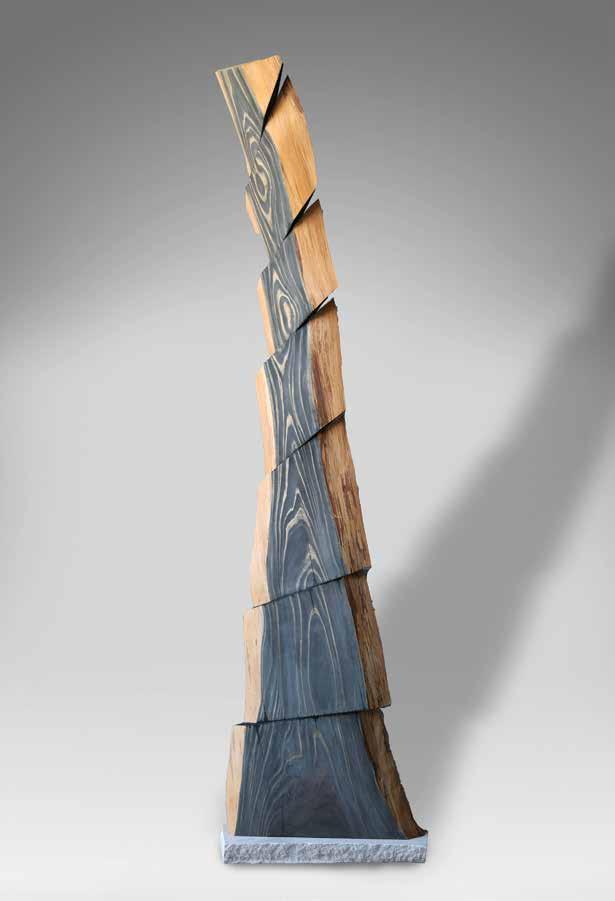
Each sculpture in Samimi’s series Personal Monuments
was inspired by memories and feelings about a specific person, place, or moment in the artist’s life.
(2020)
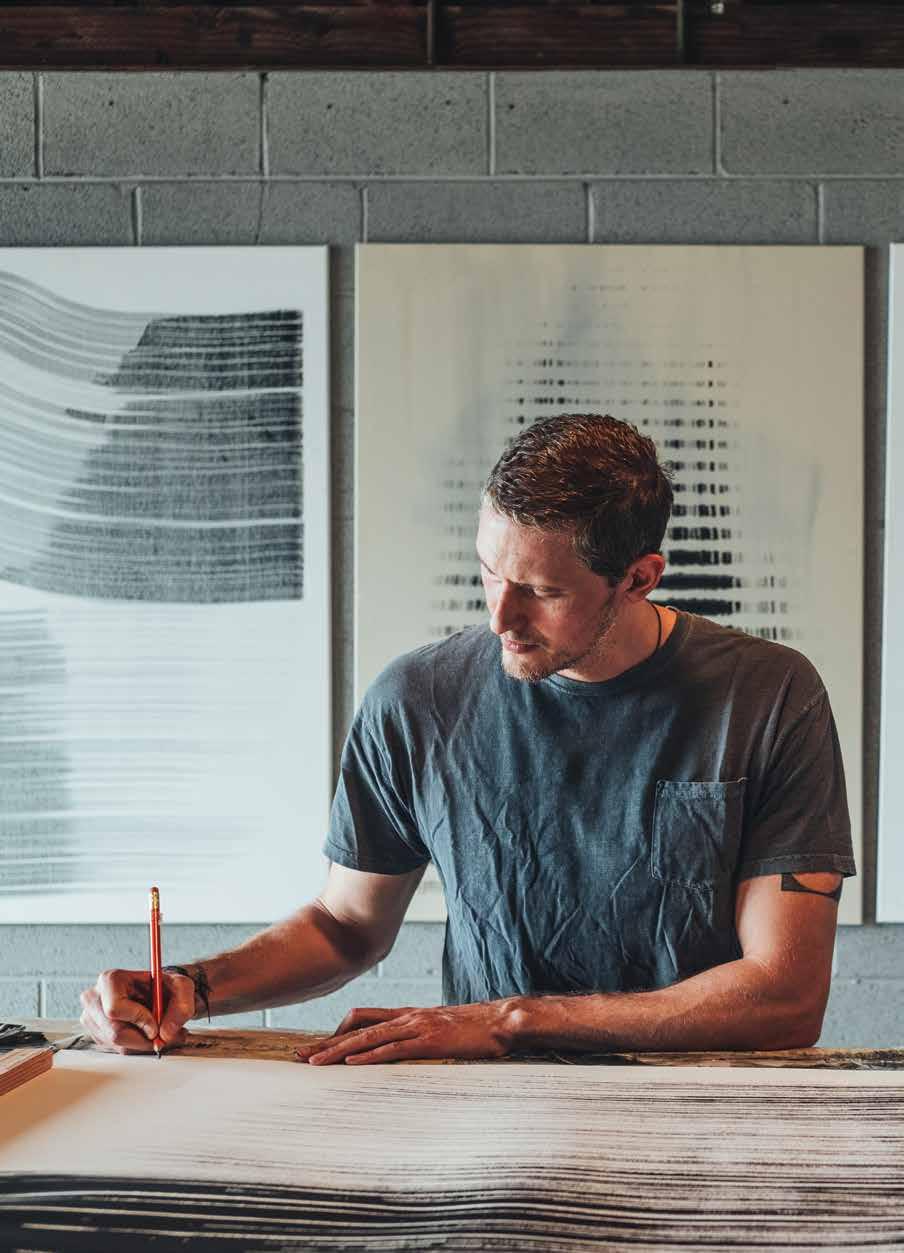
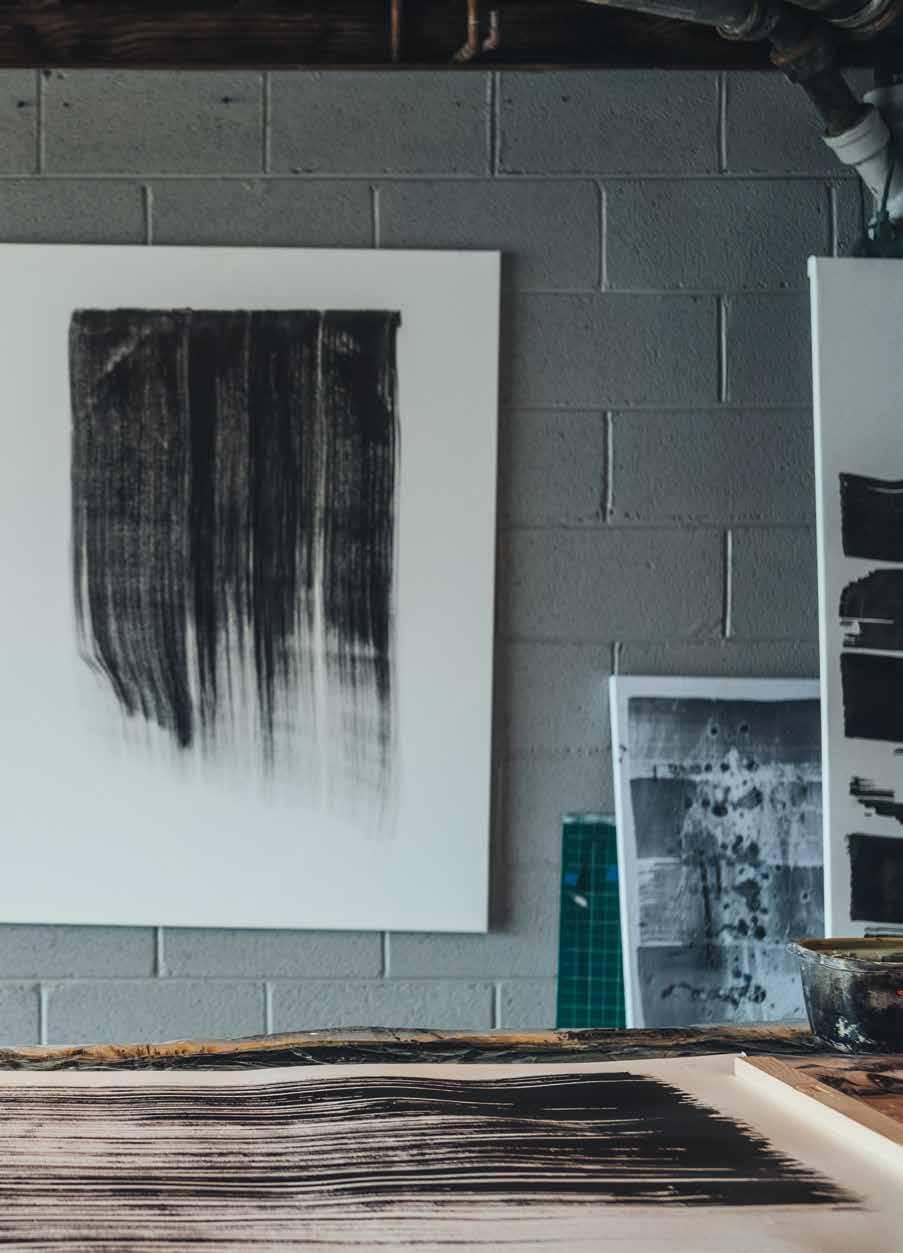
and listen to the stone,” Samimi says. “I observe it, feel it.” If he listens well enough, the stone will show him how to work with it, where it wants to be cut, in a way that preserves its integrity. “The form and life of it,” he says. “Then, I cut.”
The results are rhythmic, as seen in his series, Season Stones. The cutting and positioning of each segment implies willed movement, a measure we often use to determine what is and isn’t living. The results are also a paradox. Each stone’s interior is revealed and shown in contrast to its exterior, a geologic vivisection that compels us to look closely at an object we might have otherwise cast aside. In Void Stones, we consider the inner and outer lives of stones—their beginnings, middles, ends—and, perhaps, measure them against our own.
The Honolulu-based artist draws from his experiences growing up on Hawai‘i Island in the town of Laupāhoehoe, one of a handful of tiny former sugar towns scattered along the coastal cliffs between Hilo and Honoka‘a. It’s the sort of place where time crawls, where space stretches across the sea to the horizon, and where an intricate Japanese rock garden is a fine, even preferable, substitute for a lawn. Samimi recalls scavenging the Laupāhoehoe Point shore with his brother and collector father, searching for unique stones, driftwood, and other curiosities brought in by the sea.
Though he grew up on Hawai‘i Island, a sense of home has eluded Samimi for much of his life. “I grew up here, but I have this Persian name. My dad is from Iran, but I don’t look Persian and I don’t speak the language,” Samimi says. “My mom is from Minnesota. Her Scandinavian heritage is interesting to me, but I know hardly anything about the culture. So, if I’m not any of these things, what am I? Where’s my place in this world?”
Samimi used to feel as if he was from nowhere, but now he knows he’s from all of these places. What he once perceived to be a lack of identity, of a home, he now understands to be an abundance. Art making pushed him to see all of the inner resources he has at his disposal and to draw upon them.
All of these facets find their way into his work.
「形と命を生かすために、僕はその通りに石を切るんだ」。 それは彼の『シーズン・ストーンズ』シリーズの彫刻作品のリズミカルな 動きに現れている。それぞれのパーツの切り方と配置から、生きものを定義す る “意志”を感じ取ることができる。そこにはまた矛盾もある。それぞれの石の 外面とは対照的な内面を露呈する地質学的な解剖は、普段気にとめることの ない物をあえて注意深く観察することの楽しさを教えてくれるものだ。『ボイド・ ストーンズ』は、始まりと中間と終わりのある石の内面と外面に宿る命について 考えさせる。そしてそれは私たち自身の一生と照らし合わせることもできる。 ホノルルを拠点に活動する芸術家のサミミ氏は、ハワイ島のヒロとホノ カアの間の海岸沿いの崖に点在するかつてのシュガータウンの一つ、ラウパホ エホエという町で育った。その経験が作品に生かされている。ゆったりと時間 が流れ、どこまでも広がる海と地平線、繊細な石の日本庭園が芝生よりも好ま れるような場所だ。サミミ氏は兄弟とコレクターの父親とともに、ラウパホエホ エポイントの海岸で珍しい石や流木、沖から流れ着いたものを拾ったことを今 も思い出す。
ハワイ島で育ったものの、生涯を通して故郷という感覚が持てなかった というサミミ氏。「ここで育ったけど、ペルシャ人の名前だからね。父はイラン出 身だけど、僕はペルシャ人に見えないし、ペルシャ語も話さない。母はミネソタ 州出身でスカンジナビアに先祖がいるんだ。興味はあってもその文化について はほとんど何も知らない。故郷と呼べる国や文化のない僕は一体何者なんだ ろう?僕の居場所は世界のどこにあるんだろう?と考えていたんだ」。 やがてそれまでよりどころなく感じていた自分にとってのルーツはそれら すべての場所にあり、アイデンティティーや故郷がないのではなく、むしろ豊富 にあることに気づいたという。芸術を生むことでさらに自らの内面に秘められ た多くの資質に気づかされ、それを生かすことができるようになったのだ。
彼の作品には、そういった彼の全てが現れている。「僕は普遍的なアイデ アや素材、形、テーマを用いたアートを作るのが好きなんだ。僕たちを隔てるの ではなく、つなぐものを常に探求している。それが僕にとっての美であり、芸術 の面白さでもあるんだ」とサミミ氏は語っている。
サミミ氏は2020年、アーティストを招いて滞在中の制作活動を支援す るイスラム芸術文化デザイン博物館シャングリラ美術館のアーティスト・イン・
42 A PALM
ARTS
Kamran Samimi
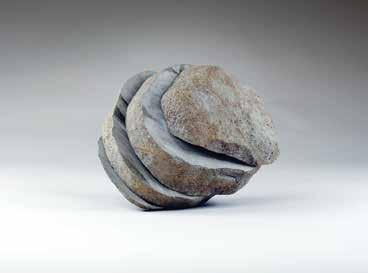

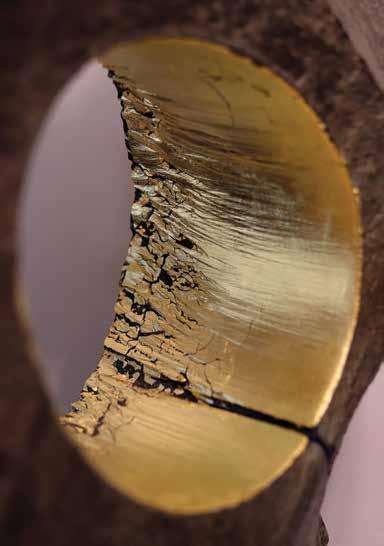 Clockwise from top right, individual works from the series Suiseki (2016), Void Stones (2019), and Islands (2019).
Clockwise from top right, individual works from the series Suiseki (2016), Void Stones (2019), and Islands (2019).
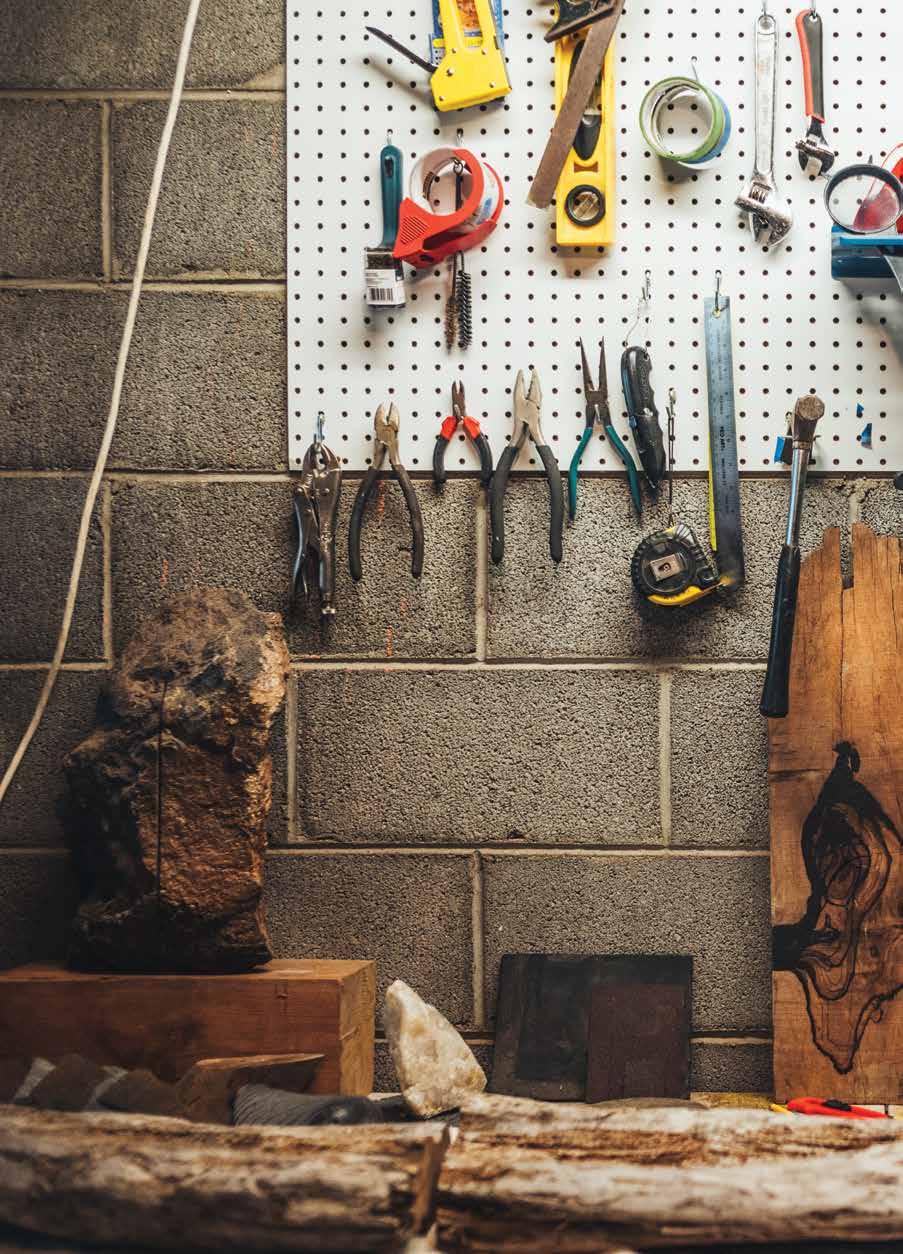
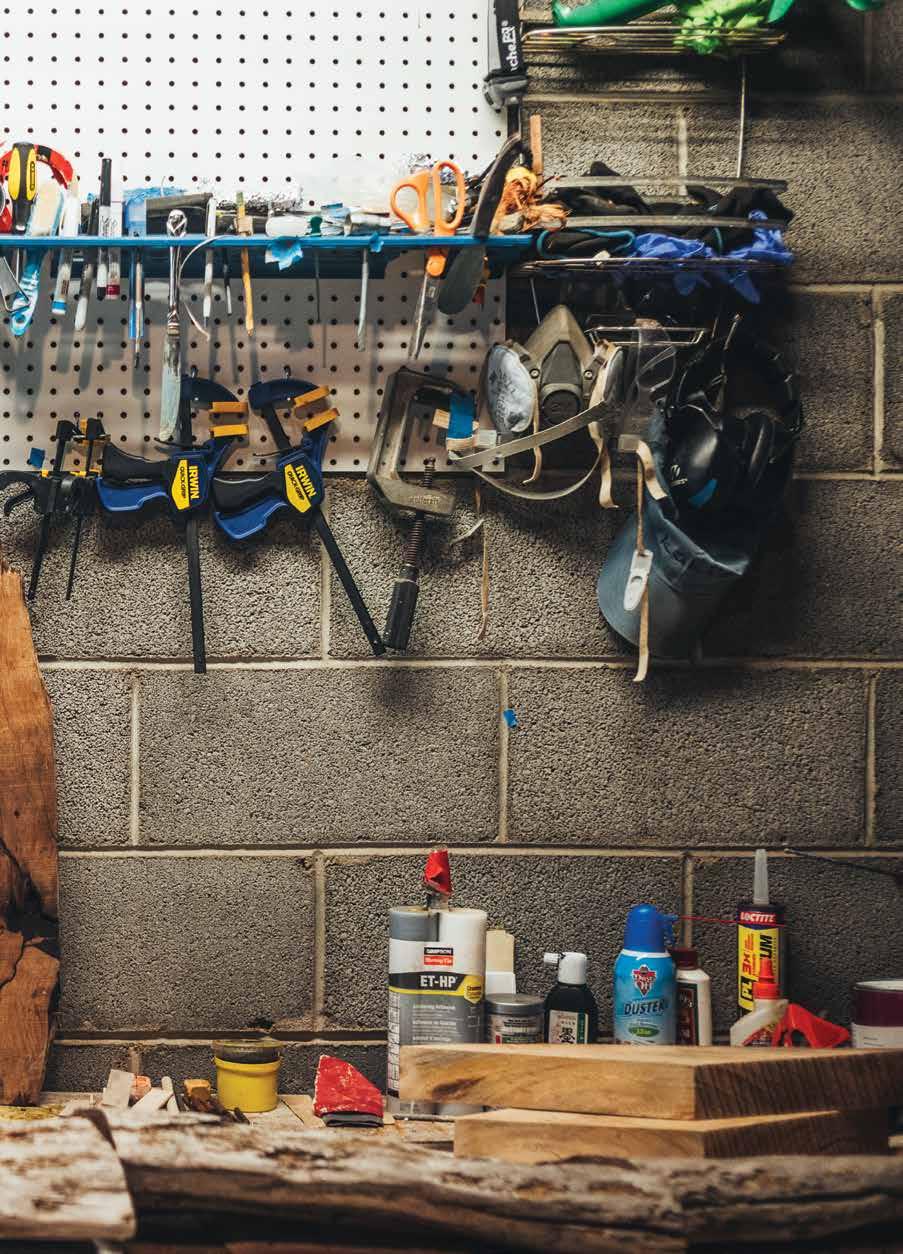

“I’m interested in making art that speaks to universal ideas, universal materials, universal forms, themes,”
Samimi says. “I want to explore what connects us, not what separates us. That’s beautiful and interesting to me.”
In 2020, the Shangri La Museum of Islamic Art, Culture & Design selected Samimi as its artist in residence, the first artist from Hawai‘i to receive the honor. The opportunity came at a time when Samimi was interrogating his reasons for making art. With new resources at hand, he returned to exploring geometric sculpture. Painting, meanwhile, gave him an immediacy of expression that’s impossible with sculpture. His ink-on-canvas series Presence and Absence expounds upon Samimi’s concerns with time, channeling them inward to include meditations on our own impermanence rather than encompassing wide spans of Earth’s history.
Before I leave Samimi’s workspace, I take a look at his showroom. His Suiseki series sits on shelves, and a combination of tables and pedestals showcase his larger pieces and prints. Adjoining the showroom is his living area, where the kitchenette is practically within reach of the bed. It’s all so devotional: modest living in the midst of icons and totems. “That universal source is what I’m really interested in,” Samimi says. “It’s something that’s important to me, and it always has been. I’m searching, and with each piece I get a little closer.”
レジデンス・プログラムに選ばれた。それは彼がアート制作に対する動機に ついて自問自答を重ねている最中にやってきた機会だった。新しい素材を 手にした彼は、ふたたび幾何学的デザインの彫刻の探究を始める。一方、 絵画は彼にとって彫刻では得られない即時性のある表現方法となった。キ ャンバスにインクで描かれた最新作のシリーズ『プレセンス・アンド・アブセ ンス』は、時間という概念を彼なりに解釈した作品だ。地球人類の歴史を振 り返るのではなく、瞑想を通して私たち自身の内面に目を向け、その無常で はかない存在について考えを深めている。
サミミ氏の作業場を離れる前に、彼のショールームをのぞいた。棚に はいくつもの水石が並び、テーブルと台座に大きな作品と版画が飾られて いる。ショールームの隣が彼のリビングルームになっていて、簡易キッチン から手の届くとことにベッドがある。石像や彫刻に囲まれた控えめな住ま いからはこのアーティストのひたむきな性格が窺える。「万物の原点に強い 関心があってね。僕にとっては、これまでずっと大切にしてきたものなんだ。
それが何なのかを常に模索していて、作品ごとに少しずつ近づいているよ うな気がするよ」とサミミ氏は熱く語る。
46 A PALM
ARTS Kamran Samimi
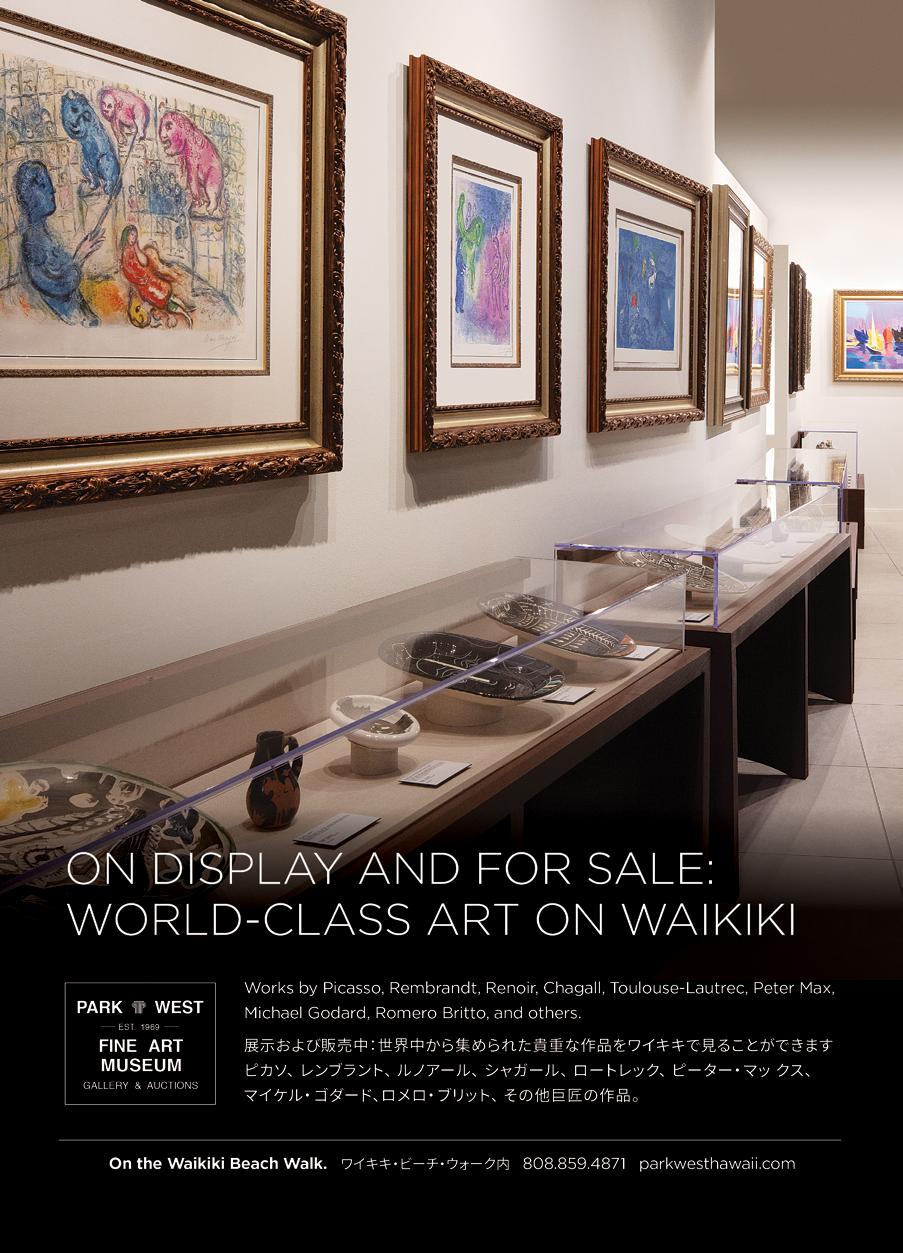
A sense
CUL TU RE of place
that
文化 PALM C 48
fosters the human spirit
49 C PALM
To Build After Fire
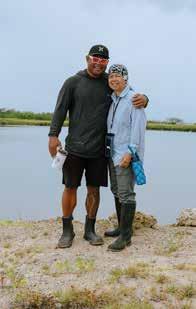
BJ Bagood and his mother, Joni Bagood, represent two of the many generations that have lived on Mokauea.

50 PALM 炎のあとで 文
サニー・ガナデン 写真
=
= ジョサイア・パターソン
Text by Sonny Ganaden
CULTURE Mokauea Island C
Images by Josiah Patterson

On Mokauea Island, the site of O‘ahu’s last native fishing village, families have fought for decades to preserve their traditional way of life.
オアフ島最後の伝統的な漁村とされるモカウエア島。伝統的なライ フスタイルを守るために村人たちは何十年も苦労を重ねてきました。
Translation by Eri Toyama Lau 翻訳 = ラウ外山恵理
오아후의 마지막 남은 어촌 마을인 모카우에아
섬에서 살고 있던 가족들이 그들의 삶의 방식을
보존하기 위해 수십 년 동안 애써 지켜낸 전통.
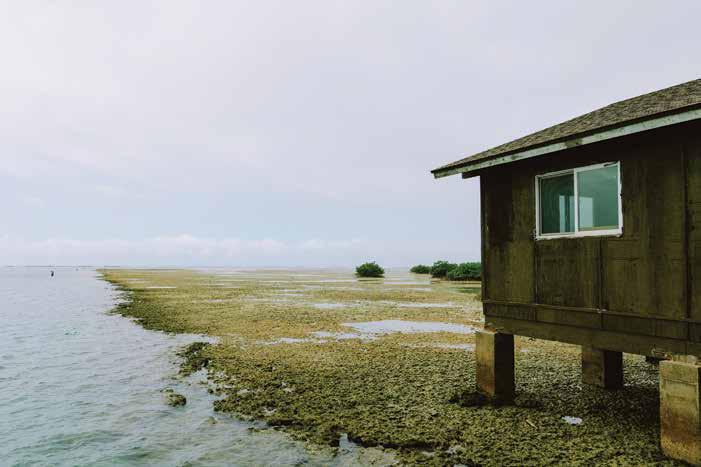
Alight summer rain falls on O‘ahu an hour after daybreak as BJ Bagood drives his boat the short distance from Ke‘ehi Harbor to his childhood home on Mokauea. As Mokauea is in the rain shadow of O‘ahu, the weather clears a few hundred yards out from his destination. Mauliola, the traditional name for Sand Island, is in plain sight across the channel. Commercial jets and military aircraft occasionally roar overhead as they travel to and from neighboring Daniel K. Inouye International Airport and Hickam Air Force Base.
“The lease says Mokauea Island is 13.75 acres in diameter, but we aren’t real sure of the exact dimensions,”
夜明けから一時間ほどたったころ、夏の小雨がぱらつくなか、ビージェイ・バグ ードさんはケエヒ港からボートに乗り込み、子供時代を過ごした家があるモカ ウエア島までの短い距離をわたった。オアフ島の雨雲が影を落とす島からほん の2、300メートル離れたところでは太陽が顔を出している。かつてマウリオラ と呼ばれていたサンド・アイランドは目と鼻の先だ。すぐ近くのダニエル・K・イ ノウエ国際空港やヒッカム空軍基地に行き来する輸送ジェット機や軍用飛行 機が、轟音をあげて頭上を通り過ぎる。
「借地契約書には島の面積は13.75エーカー(約17000坪。東京ドー ムより少し広い)と書いてありますが、実際の大きさはよくわかりません」と話
PALM 52
CULTURE Mokauea Island C



Over the years, numerous volunteers have lent their time to preserving Mokauea. Most of the work on the island is done by hand.
says BJ’s mother, Joni Bagood, who, along with her husband, Benjamin, is one of the last remaining full-time residents of the island. The salt air is unkind to structures here. BJ, a carpenter by trade, returns often to work on the family home, which sits on stilts overlooking the busy Kalihi Channel. That proximity to the sea—a life full of daily observations on the tides and weather and natural habitat—has made Joni protective of her home, and of the ecosystem that once provided thousands across O‘ahu’s south shore with an abundance of wild seafood.
The southern shore of Mokauea offers a glimpse of how the O‘ahu coastline once appeared: White sand gives way to a shallow, fringing reef that gently slopes nearly a kilometer out to sea before dropping off into deep blue water, teeming with life. But circumnavigate the island and you’ll find that the shallow reef is now populated by mangrove, which have become invasive across the archipelago. You might also notice the reef itself is displaced—it’s easy to distinguish signs of the dredging that gouged the seascape into odd angles.
It’s also easy to see why fishermen have always found their way here. Small fish dart between pools in the low tide and become trapped a few hours a day; ula (spiny lobster) and ula pāpapa (slipper lobster) hide in the crevices, waiting until evening to venture out; limu (seaweed) of both endemic and invasive varieties populate the crumbly reef. Pedestals which overlook the shallow waters, both natural and built by fishermen, offer excellent vantage for a throw net. At night, with a small torch, lobsters can be grabbed by hand. The reef muffles even the largest of swells, allowing for the berthing of canoes for deep-water fishing.
A century ago, there were several small, populated islands like Mokauea scattered along the south shore of O‘ahu near the mouth of Pu‘uloa, now known as Pearl Harbor. Over the years, the islands were dredged to create the naval base at Pearl Harbor, to construct a 12,000foot offshore airport runway, and to establish harbors and seawalls along the coast from Pu‘uloa to famous Leahi (Diamond Head). The ribbon of reef that connected Mokauea Island to nearby Kahaka‘aulana and Mokuoeao islands was removed to create the Kalihi Channel, along which wind and current now push refuse from O‘ahu to Mokauea. On a journey around the island, I see the remains of a mattress, an electric guitar, and all forms of fishing gear. Though a short swim away from O‘ahu, Mokauea somehow feels a world away from what Joni calls “the mainland,” and the rubbish that accumulates
すのは、ビージェイさんの母ジョニ・バグードさん。彼女と夫のベンジャミンさん は、今もこの島で暮らすひと握りの人々に含まれている。潮風は、島の建物に過 酷だ。大工のビージェイさんは頻繁に島を訪れ、実家の修繕にあたる。家屋は、 船が頻繁に行き交うカリヒ用水を見渡す支柱の上に建っている。これだけ海に 近いと、潮の満ち引きや気候の変化、生き物たちの生態を日々、間近に観察し ながら生活することになる。そんな毎日を送るジョニさんが、自分の家だけでな く、かつてオアフ島南の海辺で暮らす何千もの人々に豊かな海の幸をもたらし ていた生態系を守ろうと思う気持ちはとても大きい。
モカウエア島の南岸は、オアフ島のかつての海辺の景色を彷彿とさせ る。白砂の浜辺はやがて浜辺を縁どる浅い珊瑚礁にかわり、1キロ近くかけて 少しずつ深さを増した珊瑚礁の浅瀬の先は生命があふれる真っ青な深海だ。 だが、島をひとまわりしてみると、かつての珊瑚礁の浅瀬がマングローブの木で 覆われていることに気づく。マングローブの侵略は、ハワイ諸島全域で問題とな っている。同時に、珊瑚そのものが失われていることにも気づかされる。不自然 な角度でえぐれた海岸の景色を見れば、砂が流出しているのは一目瞭然だ。 この島が漁師たちを惹きつけてきたのも無理はない。引き潮の潮だまり を行き来する小さな魚たちは、1日数時間、そこに閉じ込められている。棘のあ るロブスター“ウラ”や“ウラ・パパパ(ゾウリエビ)”は夜になるまで岩の隙間に 身を潜めている。繊細な珊瑚には、固有種も外来種も入り混じりリム(海藻)が 繁殖している。自然にできたもの、人工的につくったもの。浅瀬を見渡せる投網 に適したスポットもたくさんある。夜は、小さな灯りで照らせば手づかみでロブ スターが採れる。大きなうねりが押し寄せても珊瑚礁で緩和され、沖合いの漁 用のカヌーも停泊しておける。
1世紀前まで、現在パールハーバーとして知られる“プウロア”の入り口に は、モカウエアのように人々が暮らす島が点在していた。だが、パールハーバー の海軍基地や約3.6キロにおよぶ海上滑走路、さらに、プウロアからダイアモン ドヘッドとして名高い“レアヒ”へと続く海岸沿いの港や防波堤の建設などのた め、こうした島々は少しずつ姿を消していく。モカウエア島と近くのカハカアウ ラナ島、モクオエアオ島をつなげていた珊瑚礁は、カリヒ用水を築くときに取り 除かれた。用水路に沿って、風と潮の流れに運ばれたゴミがオアフ島からモカ ウエア島に流れ着く。島にはマットレスやエレキギター、そしてさまざまな釣り 道具が落ちていた。オアフ島からちょっと泳げばたどり着けるが、モカウエア島 はジョニさんの言う“本土”とはまったく別世界だ。浜辺に積もるゴミは、オアフ 島の工業化がいかに進んでいるかをつねに思い出させる。
モカウエア島とマウリオラ、そして今も島を故郷と呼ぶ人たちの物語は、 アメリカの発展としてポジティブに語られてきた物語とは一致していない。アメ
54 PALM
CULTURE Mokauea Island C

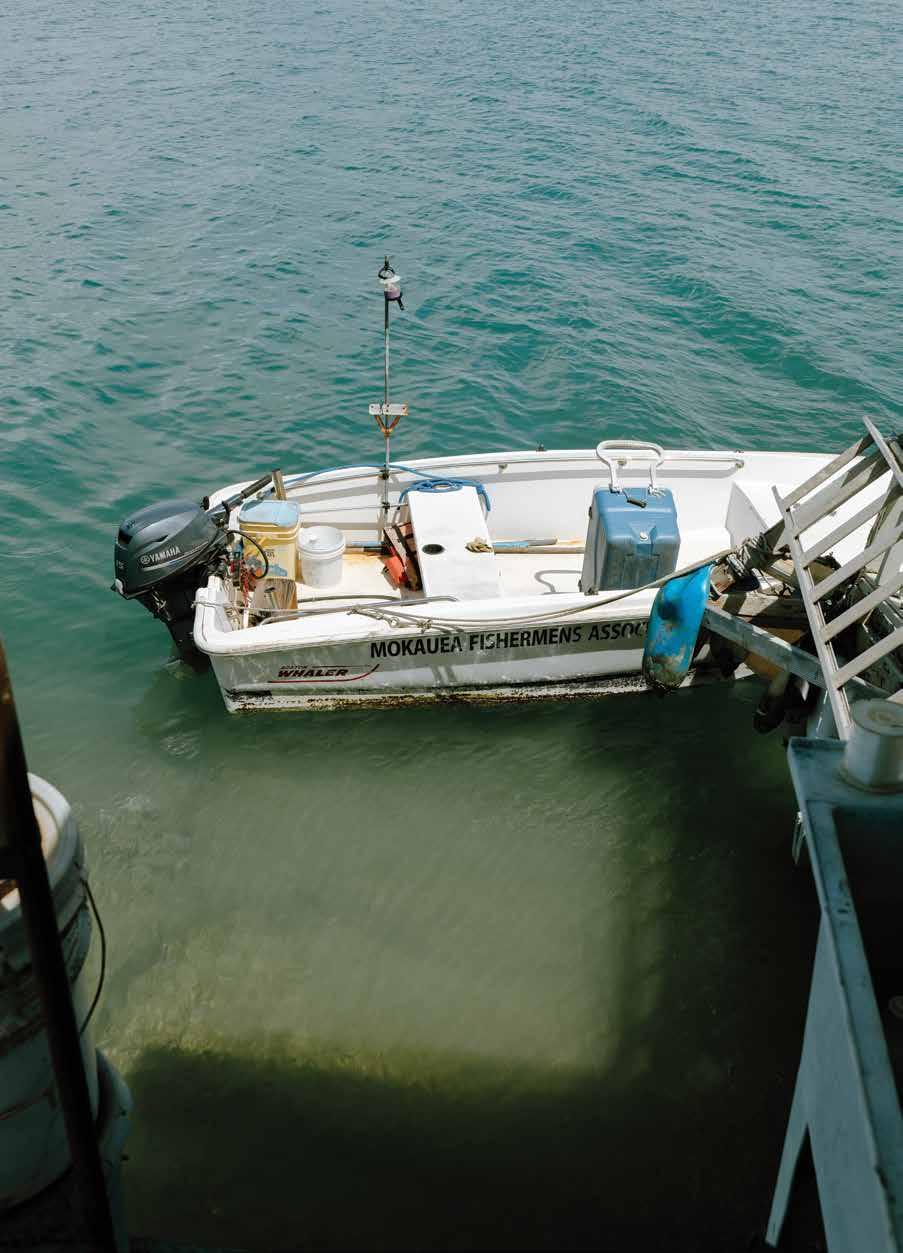
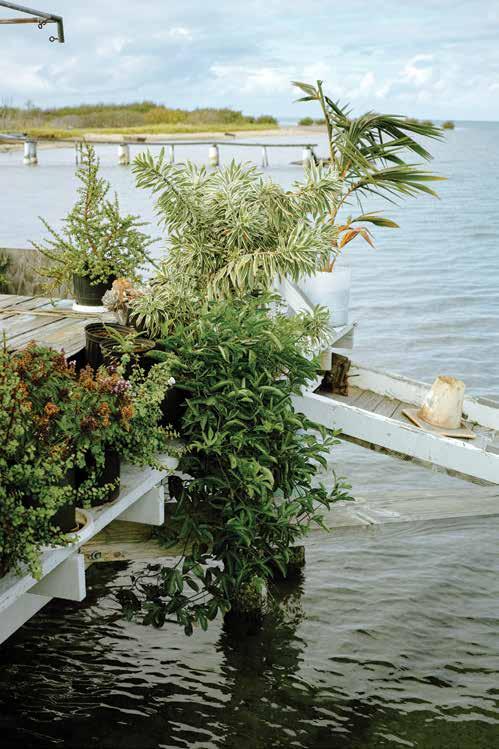
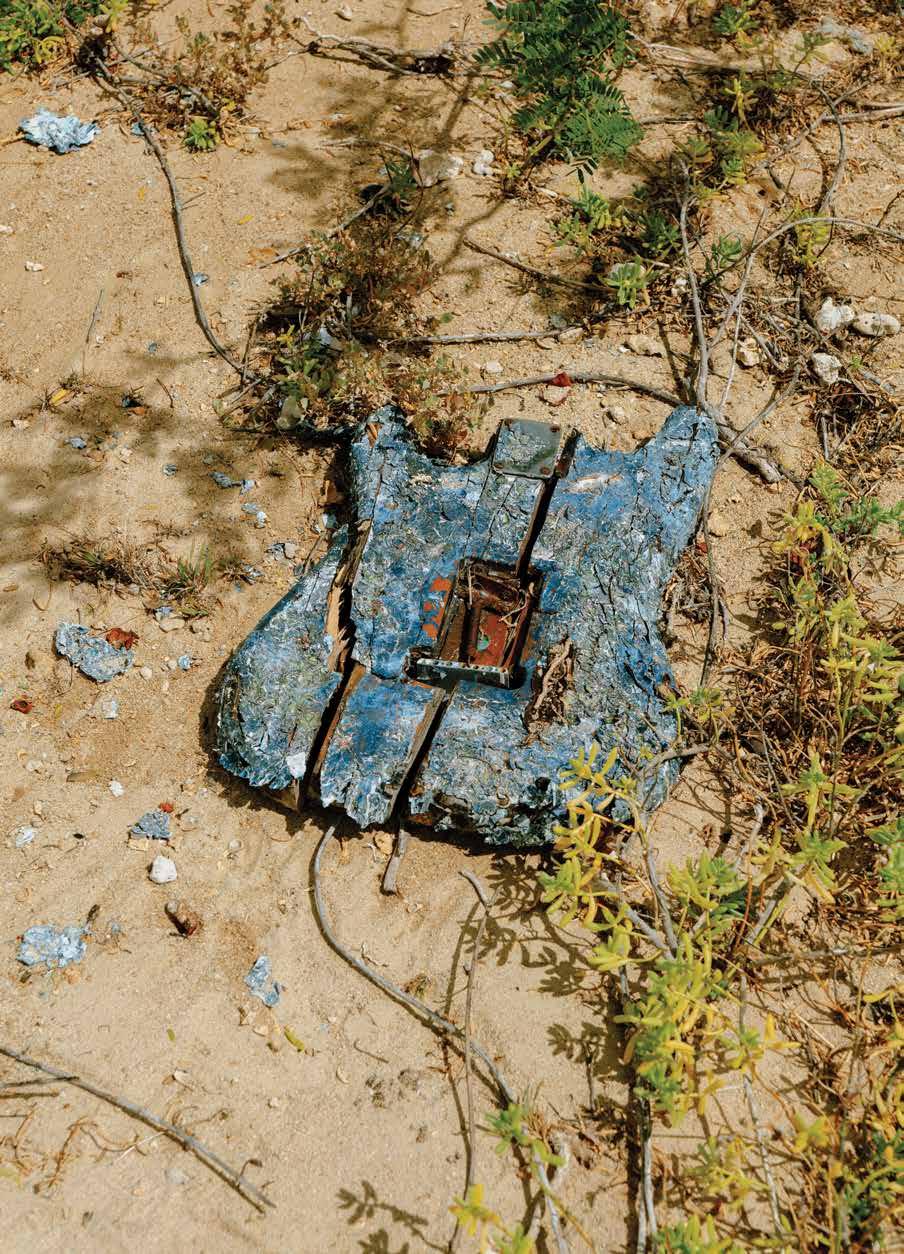
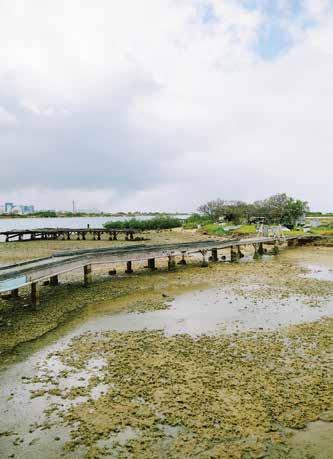
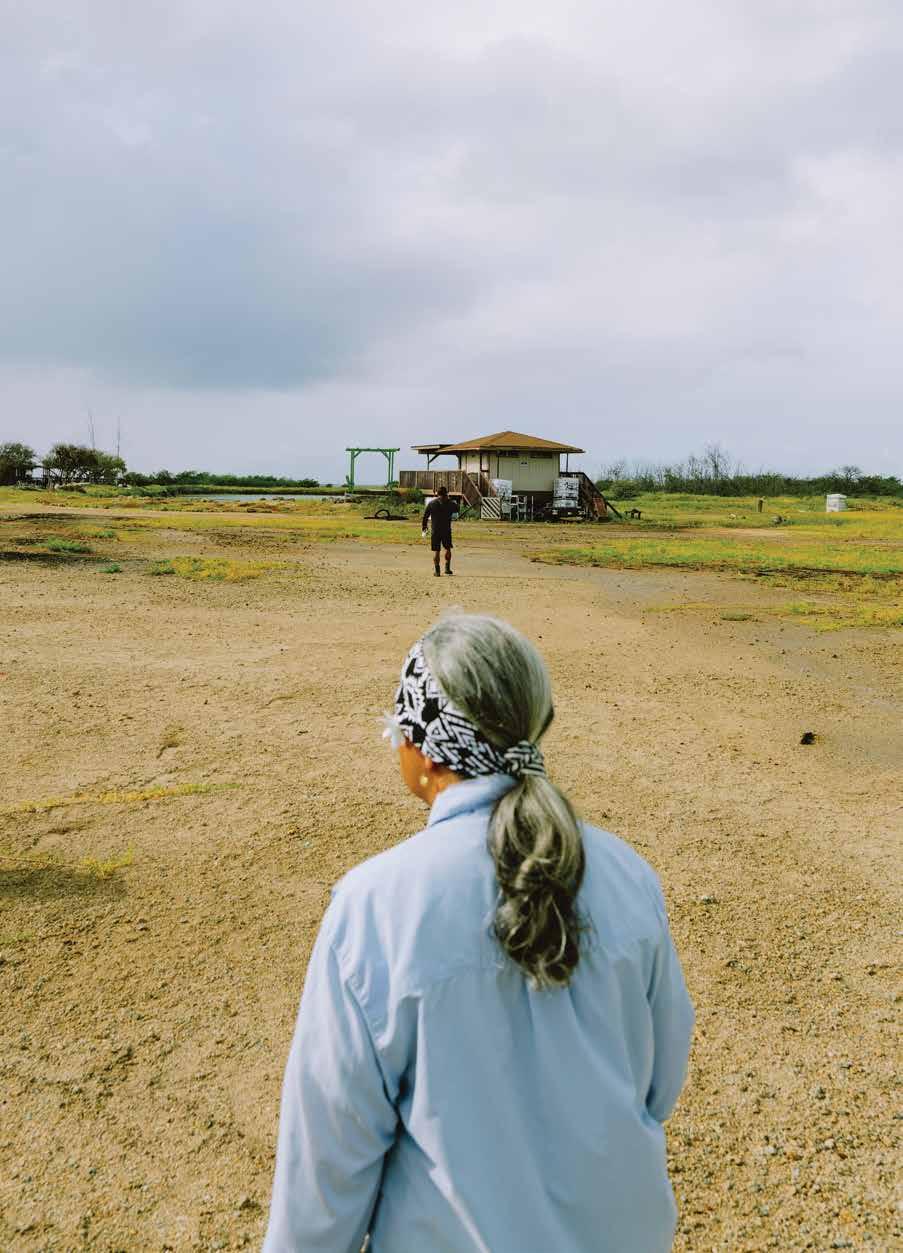


on its shores is a constant reminder of O‘ahu’s ongoing industrialization.
The story of Mokauea and Mauliola, and of the community that still calls Mokauea home, offers a counter-narrative to what has been sold as American progress. In the first part of the 20th century, Honolulu became the political and economic capital of first an American territory, then later an American state and the hub of American military in the Pacific. Throughout World War II, families were evicted from Mauliola and its neighboring islands to allow for the dredging of a seaplane runway; after statehood in 1959, the new state government was determined to continue developing the area and set out to evict the few families who resettled on the islands after the war.
The state made another attempt in 1972 to evict those still living on the islands—this time, to build an airport extension—and burned down five homes in 1975.
“There was another fisherman, a friend of ours who lived at Mokuoeao, the island across the channel,” Joni remembers. “He said, ‘I built this house with my two hands. I can’t let them burn it down. I have to do it myself.’”
That night, news broke about the destruction on Mokauea and the arrests of protesters and fishermen who refused to leave. “My husband is the last of that generation of fisherman,” Joni says, “but he doesn’t like to talk about it, unlike me.”
The state-sponsored arson triggered a public outcry, and John Kelly Jr., an activist and leader of the grassroots environmental group Save Our Surf, petitioned the governor to cease the evictions. Kelly noted that the U.S. Army Corps of Engineers dredged far deeper than they were supposed to, and that the state had violated the 1970 Environmental Protection Act and new state law that protected Hawai‘i’s environment and culture.
“Fishing and agriculture were the primary occupations in pre-contact Hawai‘i, and all life depended on them,” reported a 1976 historical study produced by the state. “The fishing community lifestyle is nearly extinct today, with the exception of Mokauea Island off O‘ahu and Milolii on the island of Hawai‘i … Because of the importance of fishing to Hawaiians, and due to the paucity of existing fishing communities, Mokauea Island is an area of important historic concern.” Two years later, the state Department of Land and Natural Resources granted leases to 14 families who lived in the village and established the Mokauea Fishermen’s Association to preserve the traditional way of life on the island. Later, an education
リカ最初の領土であり、やがて州となったハワイ。20世紀初頭から、ホノルル はそのハワイの政治経済の中心であり、太平洋におけるアメリカの軍事活動の 拠点だった。第2次世界大戦中、マウリオラおよび周辺の島々に住む人々は立 ち退きを強いられた。海底の砂をさらい、水上飛行機用の滑走路がつくるため だ。1959年、ハワイが州となってからも州政府による周辺の開発は強行され、 大戦後に島に戻ってきていた人々はふたたび立ち退きを迫られた。
さらに1972年、今度は空港の拡張のため、まだ島に残っていた人々に 州政府は再度立ち退きを迫った。そして1975年、5軒の住宅が焼き払われた。
「当時、カリヒ用水をはさんだモクオエアオ島に、やはり漁師の友人が暮らし てました」ジョニさんは振り返る。「“この手で建てた家だ。他人に焼かれるわけ にはいかない。自分でやるしかない” 彼はそう言っていました」 その夜、モカウエア島の火災と、立ち退きを拒む抗議の人々や漁師たち が逮捕されたというニュースが流れた。「夫は何代も続いた漁師の最後の世 代です」ジョニさんは言った。「でも、わたしと違って、夫はその話をしたがりま せん」
州政府がサポートした放火という事態に市民は猛反発し、草の根の環 境保護グループ〈セイブ・アワ・サーフ(わたしたちの波を守ろう)〉を率いる活 動家ジョン・ケリー・ジュニアさんは、州知事に立ち退き中止を求めて嘆願し
た。米国陸軍工兵隊が必要以上に深く海底を浚渫していること、州が1970年 に制定された全国環境政策法令やハワイの環境と文化を保護するための新し い州法に違反していることも指摘した。
“西洋文化が流入する以前、大多数のハワイ人は漁業と農業で暮らしを 立てていた” 1976年、州が編纂した歴史研究報告にはそう書かれている。
“オアフ島沿岸のモカウエア島とハワイ島沿岸のミロリイ島をのぞき、漁村の 生活様式はほぼ消え去ろうとしている……ハワイ人にとっての漁業の重要性、 ならびに現存する漁村の希少性を考えれば、モカウエア島一帯は歴史学的な 観点からも非常に重要な場所である” 2年後、ハワイ州土地と自然資源局は 村に残る14家族に土地借用権を与え、島に残る伝統的な生活様式を守るた めにモカウエア漁業協会を設立した。やがて学習センターもつくられ、陸軍工 兵隊とハワイ大学、ならびにさまざまな非営利団体が、モカウエア島の文化と 生態系を守るための活動をはじめた。
「悪いこともありましたが、おかげでいいこともはじまりました」ビージェ イさんはアルバムを開き、バグード家のモノクロ写真を見せてくれた。魚釣りに 出かける村の人々。珊瑚礁で犬とたわむれる子供たち。第50州フェアがまだカ リヒ用水をはさんだマウリオラで催されていた当時の、乗り物のシルエットが映 るスナップショット。「僕はこの島で暮らした4世代の3代目です」ビージェイさ
60 PALM
C CULTURE Mokauea Island
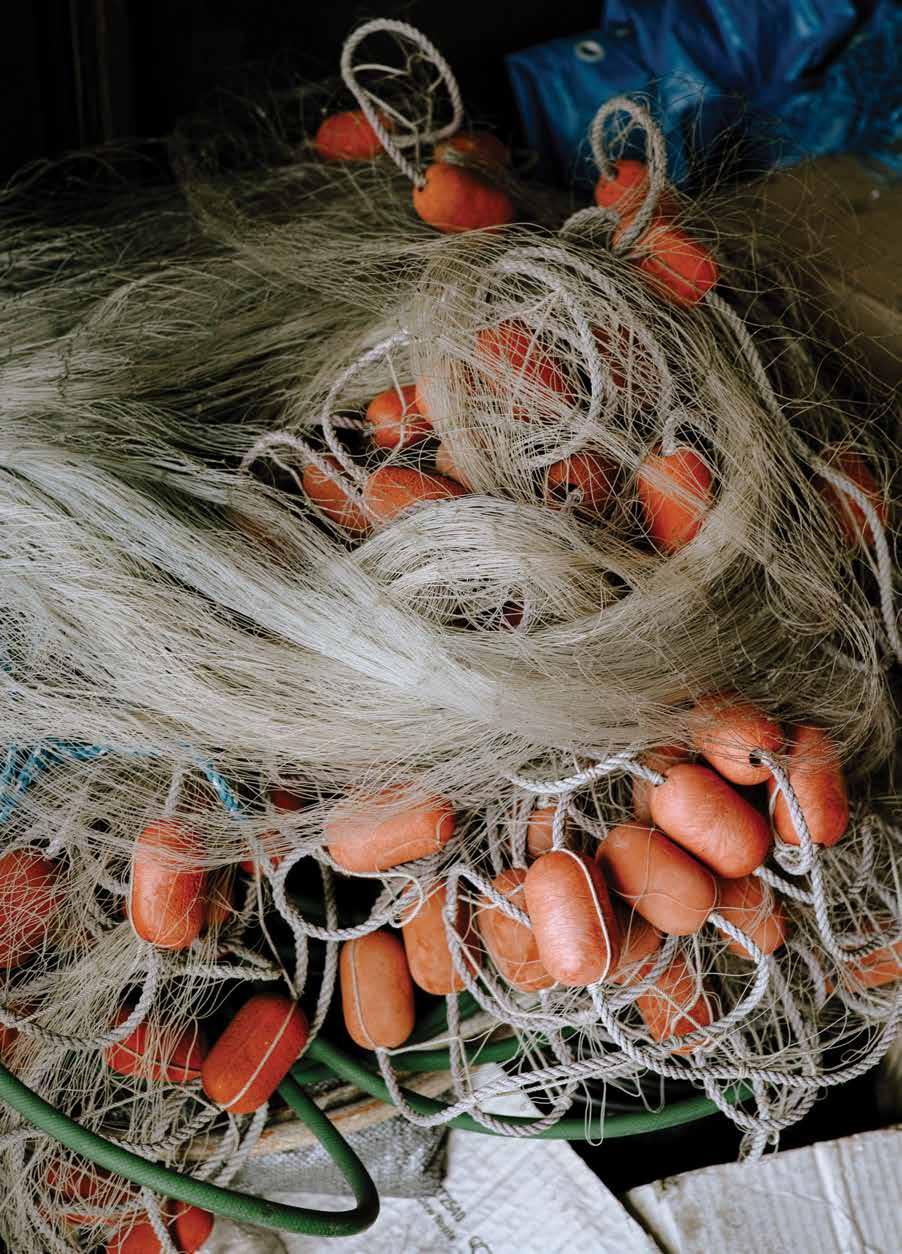
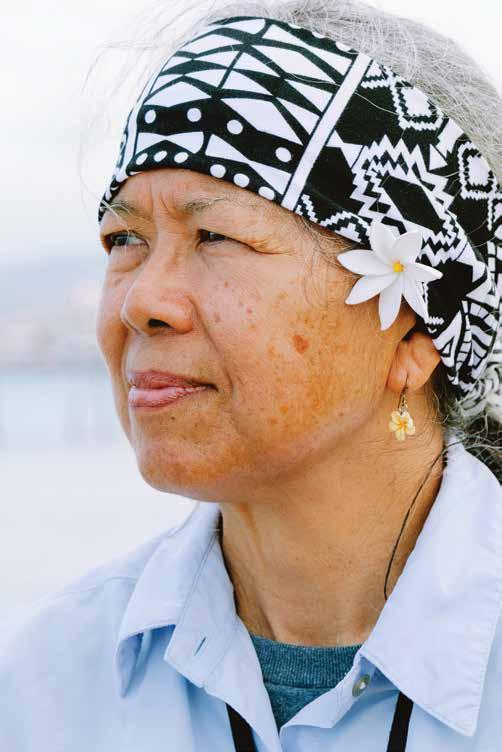
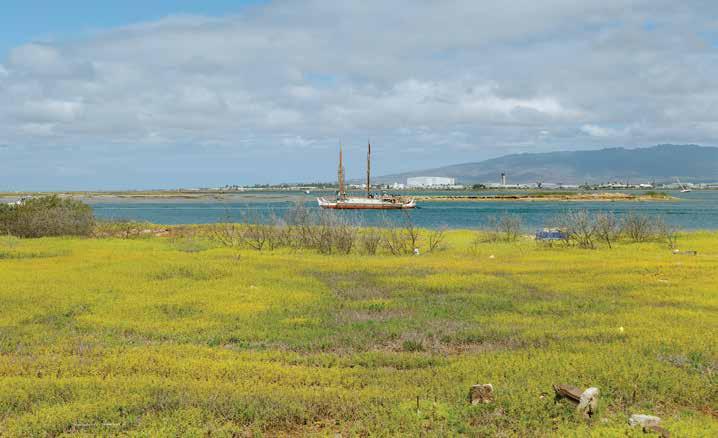
A century ago, there were several small, populated islands like Mokauea scattered along the south shore of O‘ahu near the mouth of Pu‘uloa, now known as Pearl Harbor.
center was built, and the Army Corps of Engineers, the University of Hawai‘i, and various nonprofit organizations have launched continuing efforts to preserve the culture and ecology of Mokauea.
“With the bad comes the good I guess,” BJ says, opening a photo album to reveal a series of monochrome photographs of the Bagood family. He and Joni reminisce over pictures of the village’s residents out fishing, children playing on the reef with the dog, and snapshots showing the silhouettes of carnival rides at the 50th State Fair, seen from across the channel when the fair was held on Mauliola. “I’m generation three of four that’s lived here,” BJ says. “I try to come once a week with my kids. Eventually, the plan is to move back.”
In 2043, the 65-year lease granted to the Bagoods and other families on Mokauea by the state will expire. “We want to continue this, our way of life,” Joni says. “We want people to know about this place, to be educated about it, to see what should be preserved.”
んは語った。「週に一度は子供たちを連れて島を訪れるようにしています。 いずれはここに戻ってくるつもりでいますよ」 2043年、バグードさんをはじめとする漁師たちが州から受けた65 年の借地権が切れる。「今までどおりの生活を続けたいです。多くの人たち に、この島のことを知ってほしい。歴史的な意味を知り、守るべきだと考え てほしいです」ジョニさんはそう語った。
62 PALM
CULTURE Mokauea Island C

DE SI GN
The flourishing of
PALM デザイン D
facilities creative
65 PALM D
Star of the Sea
Vibrant hues and textured details dazzle against the dappled sands and waters of Kuli‘ou‘ou.
Styling by Jade Alexis
Hair & makeup by Kecia Littman
Modeled by Channel Noah from The Honolulu City Club
Photo assistance by Melissa Williams
Wardrobe assistance by Asia Collier
66 PALM
Images by IJfke Ridgley
海辺のスター


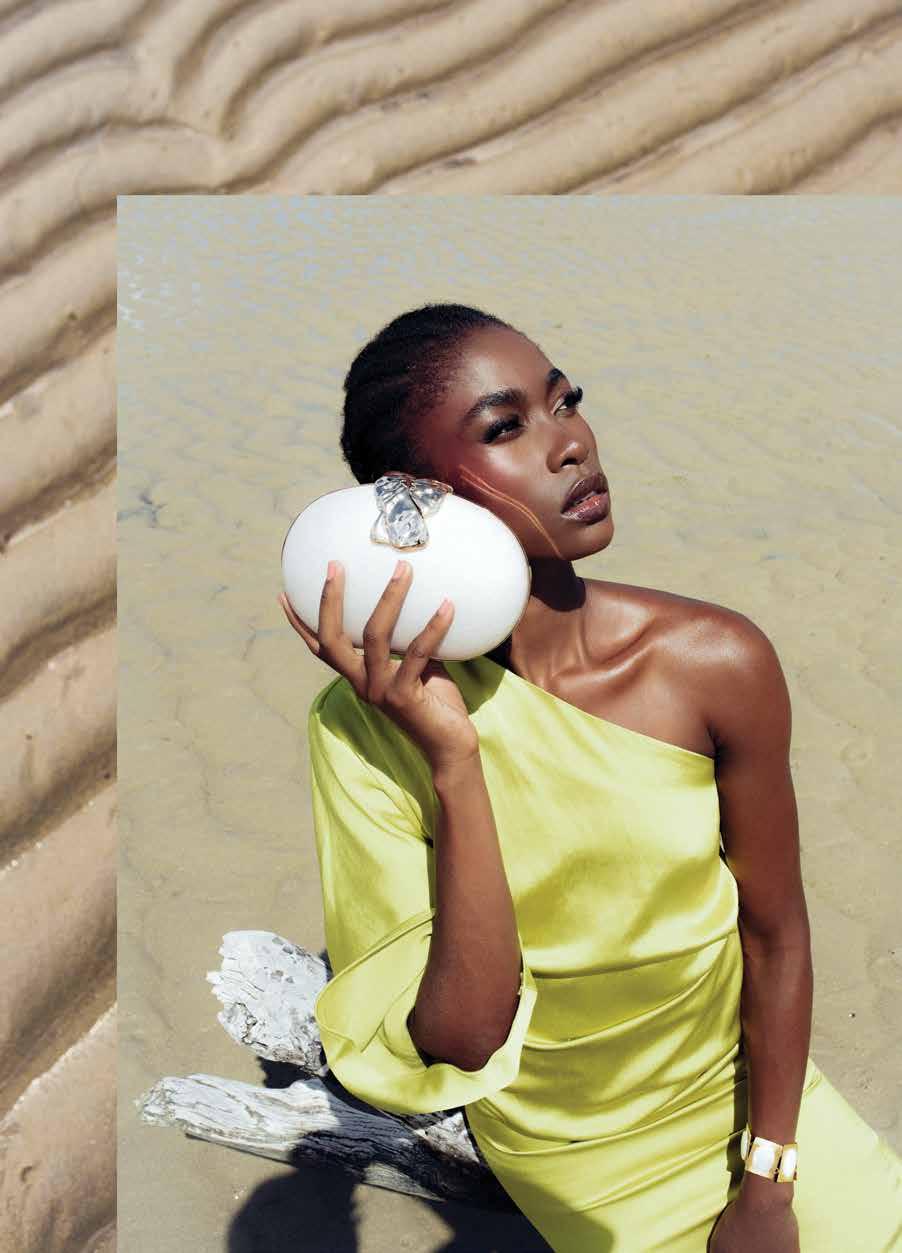
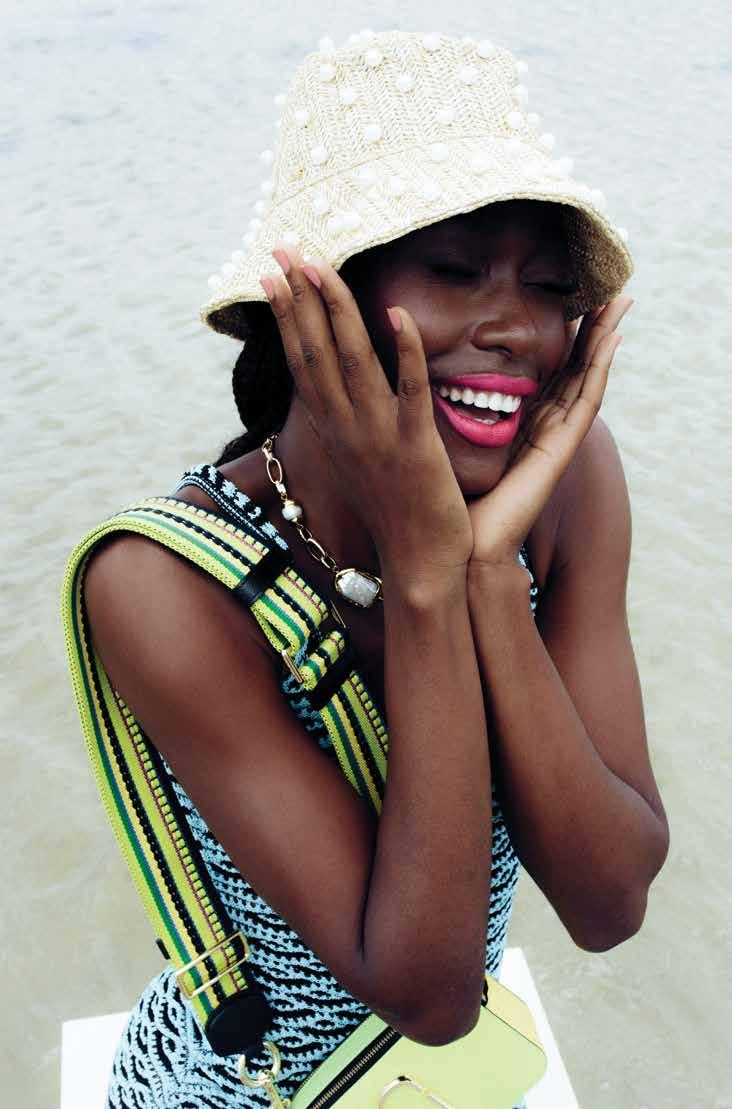 Giorgio Armani scalloped crochet maxi dress, Lele Sadoughi pearly crochet raffia bucket hat, Marc Jacobs Snapchat colorblock camera crossbody bag, and Stephen Dweck necklace, all from Neiman Marcus.
Giorgio Armani scalloped crochet maxi dress, Lele Sadoughi pearly crochet raffia bucket hat, Marc Jacobs Snapchat colorblock camera crossbody bag, and Stephen Dweck necklace, all from Neiman Marcus.

On previous spread, satin effect asymmetric dress in lime green from Zara, clutch from Cult
Neiman Marcus
Ala Moana Center
1450 Ala Moana Blvd.
Vest and pants from Zara, sandals from Raye, Fiorina earrings from Shashi, ring by Amber Sceats.
Gaia, earrings by Catherine Zoraida.


 Alexander McQueen blazer, puffin mini loop shoulder bag by Simon Miller, earrings by Shashi.
Alexander McQueen blazer, puffin mini loop shoulder bag by Simon Miller, earrings by Shashi.
 CeliaB Alvis embroidered tiered midi dress, earrings by Petit Moments.
CeliaB Alvis embroidered tiered midi dress, earrings by Petit Moments.
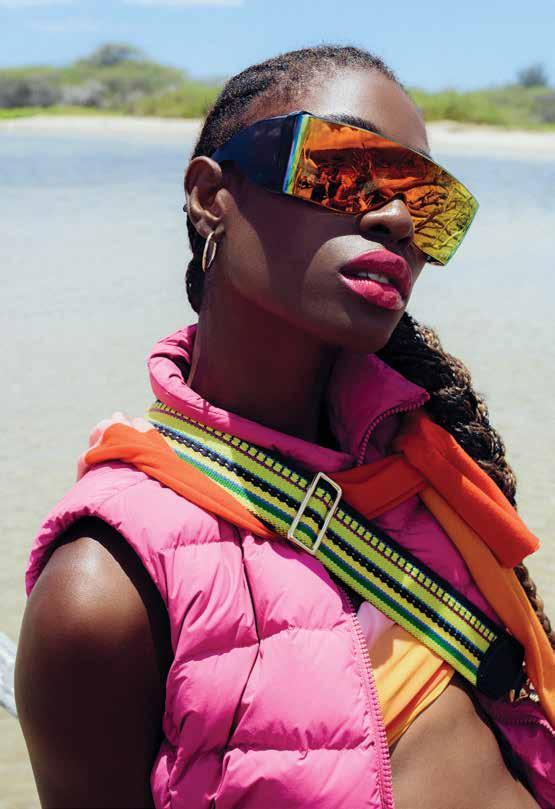 Moncler Ghany puffer vest, Akris Punto colorblock wool pullover, and Marc Jacobs Snapchat colorblock camera crossbody bag, all from Neiman Marcus. Sunglasses from CosmicEyewear, earrings by Petit Moments.
Moncler Ghany puffer vest, Akris Punto colorblock wool pullover, and Marc Jacobs Snapchat colorblock camera crossbody bag, all from Neiman Marcus. Sunglasses from CosmicEyewear, earrings by Petit Moments.
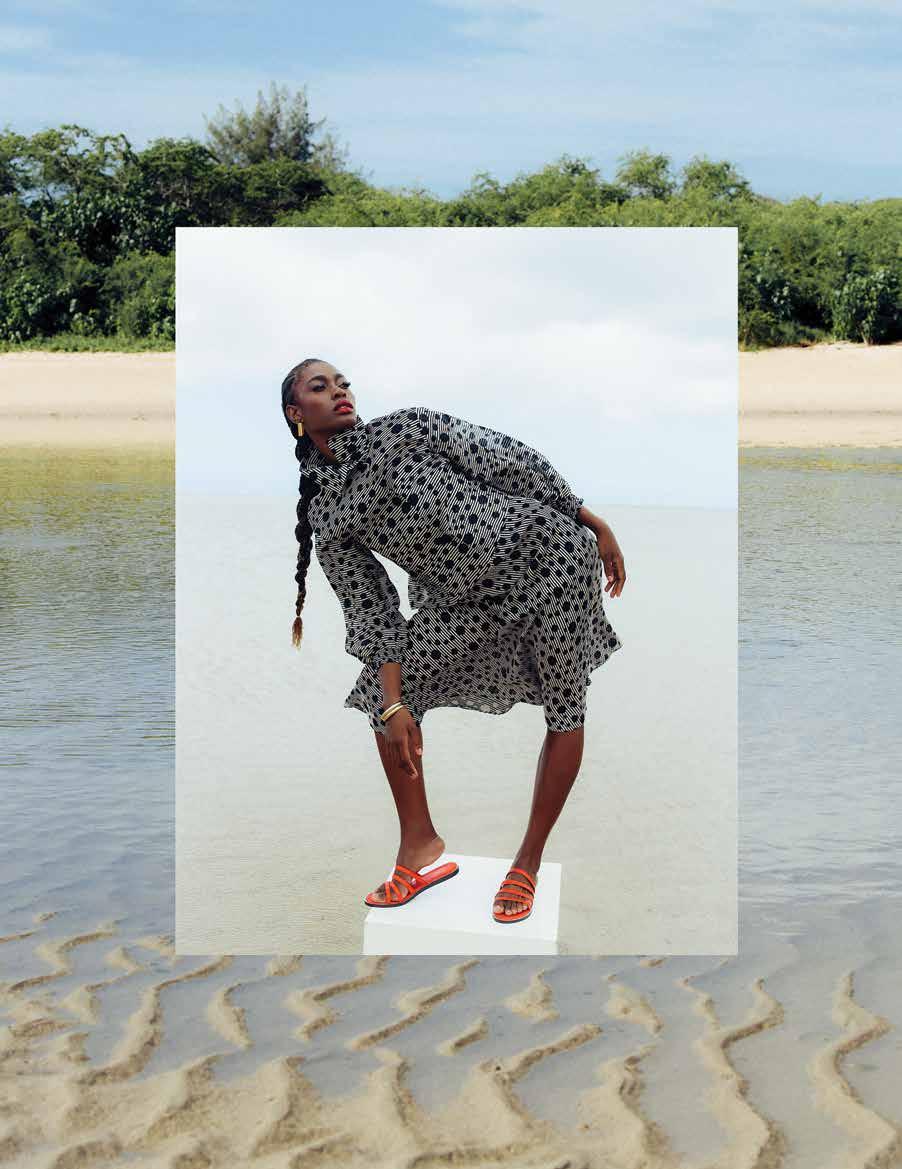 Akris Punto organdy jacquard dot midi dress and jacquard dot techno organdy jacket from Neiman Marcus, sandals by Massimo Dutti, rectangular hoop earrings from Lana Jewelry, bracelets by Mejuri.
Akris Punto organdy jacquard dot midi dress and jacquard dot techno organdy jacket from Neiman Marcus, sandals by Massimo Dutti, rectangular hoop earrings from Lana Jewelry, bracelets by Mejuri.
Travel
ES CA PES
experiences both
エスケープ PALM E
faraway and familiar
79
E PALM
A Peruvian Provenance
by Tony Dunnell
Images by Mia Spingola
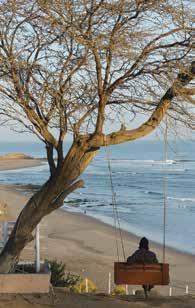
At left, wave watching in Máncora. At right, a fleet of reed watercrafts in Huanchaco.

80 PALM
文
写真
ペルー発 波乗りの起源
= トニー・ダネル
= ミア・スピンゴラ
ESCAPES Peru E
Text
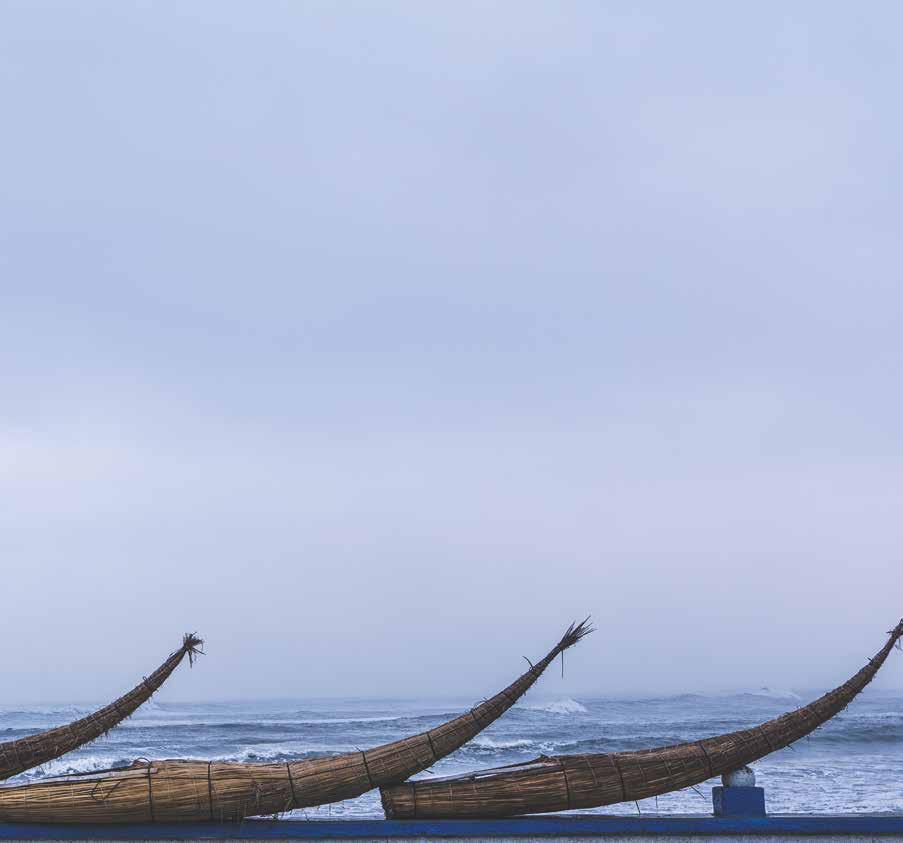
Hawai‘i may be the undisputed surfing capital of the world, but the sport has lesser-known roots on Peru’s northern coast, where fishermen have been riding waves for millennia.
ハワイが世界のサーフィンの中心地であることに議論の余地はありません が、じつはサーフィンには、あまり知られていないルーツもあったのです。ペ ルーの北海岸では、何千年も昔から漁師たちが波乗りをしていました。
Translation by Eri Toyama Lau 翻訳 = ラウ外山恵理
하와이는 논란의 여지가 없는 세계 서핑의 수도일 수도 있지만, 이 스포츠는 페루의 북쪽 해안에서 어부들이 수
천 년 동안 파도를 타고 있는 뿌리를 가지고 있다.

Standing on the malecón, Lima’s clifftop coastal path, it’s hard to know where to look. Beneath the flat, gray sky that typically covers the Peruvian capital, the world is a swirl of colors. People walk dogs of all shapes and sizes, young lovers lounge on manicured park lawns, cyclists and skateboarders slide by as paragliders hang on thermals forced up by the cliffs. Down below, Lima’s beaches, dotted with swimmers and sunbathers, curve along the coastline and disappear into the haze. Out to sea, fishing boats bring in their catch. And between the two, plying the waves, are the tiny shapes of surfers. Locals, mainly, but foreigners, too, some of whom will
リマの海岸をたどる崖の上の遊歩道〈マレソン〉に立つと、見どころが多くて困 ってしまう。ペルーの首都リマではおなじみの、平べったい灰色の空の下には 色彩があふれている。かたちも大きさもさまざまな犬を散歩する人々。手入れ の行き届いた公園の芝生でのんびり寝そべる若い恋人たち。自転車に乗った 人やスケートボーダーが通り過ぎ、パラグライダーは崖が生み出す上昇気流に 乗って舞い上がる。見下ろせば、海水浴や日光浴を楽しむ人々が散らばるビー チがうねうねした海岸線に沿って、霞がかった景色の果てに消えるまで点々と 続く。沖に目を向けると、漁から戻ってきた船が見える。船と浜辺の中間あたり に、波のはざまを行ったり来たりする豆粒のようなサーファーたち。多くは地元
PALM 82
E
ESCAPES Peru
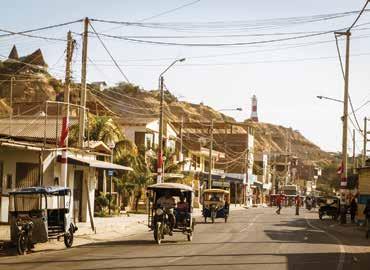

 Scenes from the surf towns of Lobitos, Huanchaco, and Máncora, also pictured on opposite page.
Scenes from the surf towns of Lobitos, Huanchaco, and Máncora, also pictured on opposite page.
have traveled to Peru specifically for the surf. It is, after all, one of the world’s greatest surfing destinations.
Lima, Peru’s vast metropolitan capital, was founded in 1535 by the Spanish conquistador Francisco Pizarro. The site was chosen because of the bay, where a port was built to ship the riches of the New World—including Inca gold—back to the Old. Once the country’s modern boundaries were drawn, Lima found itself at the midpoint of Peru’s 1,600-mile desert coastline. The capital is the gateway into Peru, and most international tourists fly in to Lima before heading to the southern half of the country, to popular destinations such as Nazca, Arequipa, Lake Titicaca, and Peru’s crowning jewel, Machu Picchu (via Cusco).
Surfers, meanwhile, often head in the other direction. Lima itself has quality surf spots, including the point break at La Herradura, the impressive swell at Punta Rocas, and some of the biggest waves in South America at Pico Alto. Beyond Lima, however, there’s the draw of the less-frequented north coast, a surfer’s paradise that boasts adventure, endless beaches, the world’s longest wave, and—perhaps—a history of wave riding that predates surfing’s more commonly accepted origins in Polynesia.
Trujillo and Moche territory
Dust kicks up around the bus as it leaves Lima between adobe shanty towns that cover the arid hills on the outskirts of the city. The Pan-American Highway, which stretches across the entire western flank of South America, heads north through the desert. It’s nine hours from Lima to Trujillo by bus, which isn’t so bad—the buses in Peru are good, with air-con and reclining seats. You can fly, of course, if you don’t mind missing the stark beauty of the coastal desert scenery.
Trujillo, the largest city in the northern half of the country, is located in the fertile Moche Valley. The area was home to the Moche culture from about 100 AD to 800 AD, a civilization later succeeded by the Chimú, who were conquered by the Inca Empire in the 1470s. Both the Moche and Chimú were masters of hydraulic engineering, and their irrigation systems helped them thrive along the parched north coast of Peru. They left many remarkable archaeological sites, most notably the huge truncated pyramids of Huaca del Sol and Huaca de la Luna, and the later Chimú site of Chan Chan—a vast, windblown, and haunting place that was once the largest adobe city in the ancient world.
のサーファーだが、外国から訪れたサーファーたちもいる。サーフィンが目的で ペルーを訪れる人だっているのだ。何はともあれ、ペルーが世界有数のサーフ ィンのメッカであることは間違いない。
広大なペルーの首都リマは1535年、スペインから来たコンキスタドー ル(征服者)、フランシスコ・ピサロによって拓かれた街だ。港を築くのに適した 湾があるこの地を選んだピサロは、インカのゴールドを含め、新世界の豊かな 富を旧世界へと運び出した。近代に入って国境が今のように定まると、リマは ペルーの約2600キロにおよぶ海岸線のほぼ中間地点に位置することとなっ た。外国からの観光客の多くは、まずペルーの玄関リマに到着し、そこからナス カ、アレキパ、チチカカ湖をはじめ、クスコ経由でペルーの至宝マチュピチュな ど人気の観光スポットがあるペルー南部へと向かう。
だが、サーファーの多くは反対の方角を目指す。ポイントブレイクで有名 なラ・エラドゥーラや、プンタ・ロカスのパワフルなうねり、南米大陸屈指の大 波が訪れるピコ・アルトなど、リマにも上質なサーフスポットはたくさんある。し かし、その先にある、訪れる人も少ない北海岸もまた負けず劣らず魅力的なの だ。世界でいちばん長い波をはじめ、冒険心をそそるビーチが果てしなく続く サーファーズ・パラダイス。そしてそこは、おそらく、一般的にサーフィン発祥の 地とみなされているポリネシアよりずっと以前に波乗りの歴史がはじまった地 でもあるのだ。
トルヒーヨ、モチェ近辺
バスは土ぼこりを巻き上げながら、リマ郊外の乾燥した丘を埋め尽くす アドビ煉瓦の町並みをあとにした。南米大陸の西海岸を縦断するパン=アメリ カン・ハイウェイは、砂漠を北へと向かっている。リマからトルヒーヨまではバス で9時間の旅だが、けっして悪いものではない。冷暖房が完備し、シートも倒せ るバスの旅は快適だ。海岸沿いに続く砂漠の荒涼とした美しさを見逃してもか まわないと言うなら、もちろん飛行機での移動も可能だ。 ペルー北部最大の都市トルヒーヨは肥沃なモチェ谷に位置している。紀 元100年から800年にかけてモチェ文化が栄えた一帯だ。モチェ文化のあと は、1470年代にインカ帝国に征服されるまでチムー文化が栄えた。モチェ人 もチムー人も高度な水力利用文化を持ち、灌漑設備を活用して乾燥したペル ー北海岸で繁栄した。数々の遺跡が残っているが、なかでも有名なのは頭部を 切り詰めたかたちをした巨大なピラミッド〈太陽のワカ〉と〈月のワカ〉、そして、 チムー文化期の、輝ける太陽を意味する〈チャン・チャン〉だ。風にさらされる広 大なこの遺跡は、アドビ煉瓦でつくられた古代最大の都市だった。
84 PALM
ESCAPES Peru
E
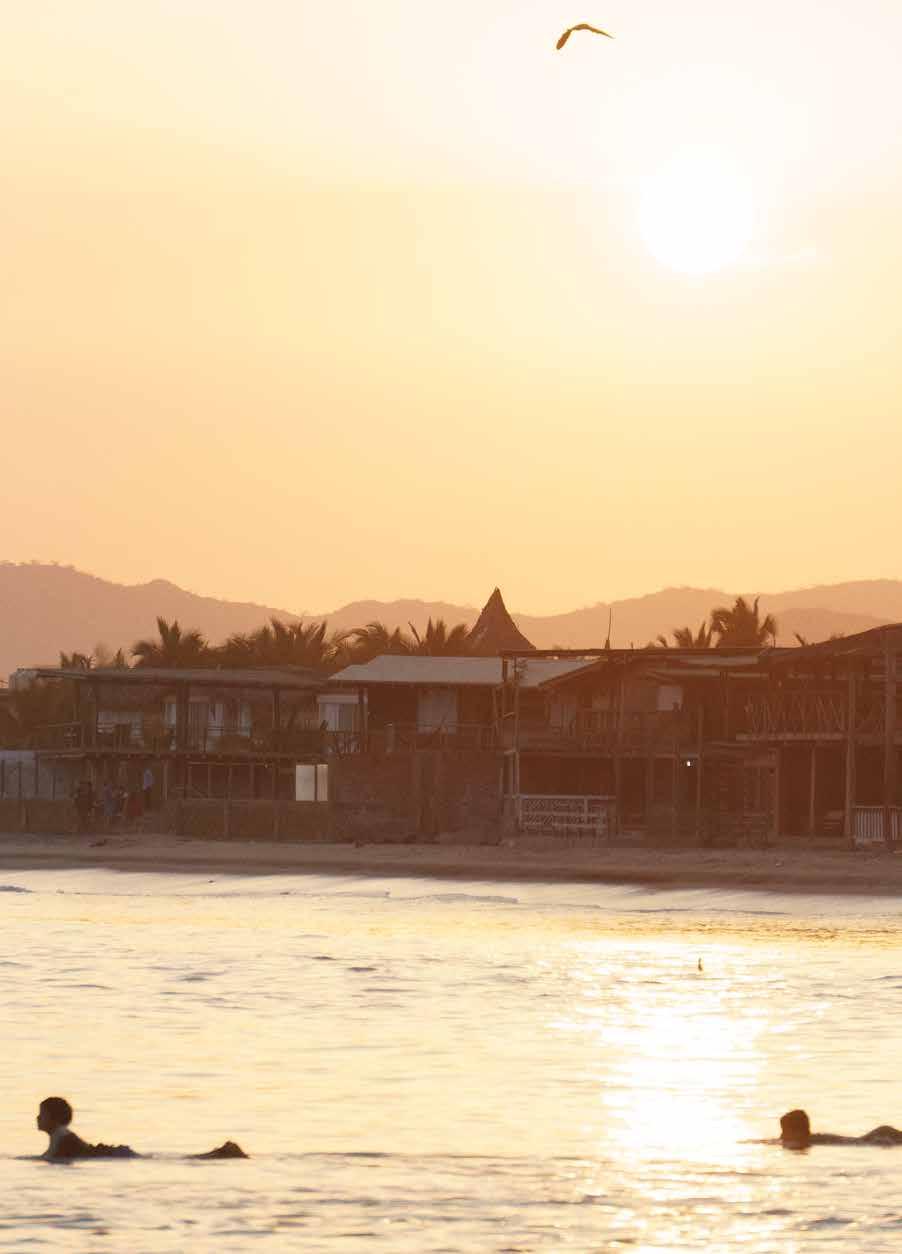
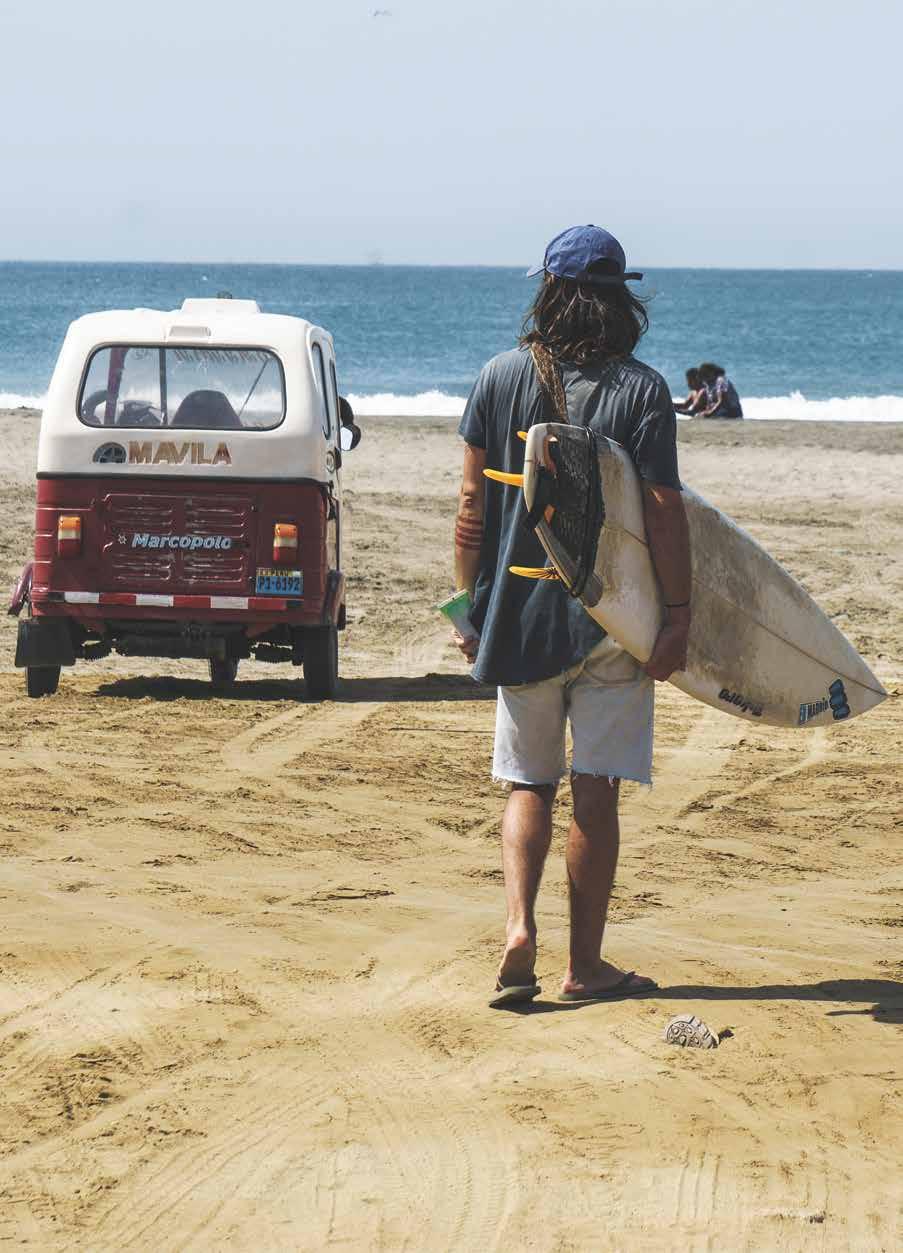

For surfers, the coastline near Trujillo offers many great waves, but two locations stand out from the rest. Take a local bus up the coast past Chan Chan and you’ll soon arrive at Huanchaco, a relaxed seaside resort town where locals and tourists mingle at seafront restaurants, eating arguably the best ceviche in Peru. Along the beach, the ribs of a giant, desiccated leviathan appear to be sticking up from the sand. These, in fact, are rows of caballitos de totora, locally made reed watercraft used by fishermen along the north coast of Peru for millennia. According to some historians, caballitos de totora (“little reed horses”) are the world’s first known surfing vessels, a theory supported by characteristically naturalistic Moche ceramics—often in the form of spouted vases—depicting fishermen riding their craft in various positions. Then, as now, fishermen paddled out on their 12-foot-long caballitos. They hauled in their catch and then surfed their craft back to land, either standing, kneeling, or sitting. Whether this bears any connection to the rise of modern surfing is open to debate—but, along with Huanchaco’s excellent local surf breaks, it’s the reason why the town is a designated World Surfing Reserve.
Forty or so miles up the coast from Trujillo is the tiny fishing village of Puerto Malabrigo, unofficially known as Puerto Chicama. Here begins the longest lefthand wave in the world. The Moche likely surfed here two millennia ago, but the wider world only became aware of Chicama in the 1960s, when Chuck Shipman, a surfer from Hawai‘i, spotted the 2.5-mile wave from the air and immediately reported it to his surfing friends in Lima. Divided into five sections, surfers normally have to catch multiple waves to make it the entire distance. But on a good day, a perfect wave at Chicama can last for four minutes.
Máncora and Cabo Blanco
Traffic rumbles along the Pan-American Highway as it pushes further north into the Piura region of Peru, just a few degrees south of the equator and not far from the border with Ecuador. The highway runs right through one of the region’s most popular destinations among backpackers and surfers: the beach resort town of Máncora. Máncora is a party town and a popular surf spot. So popular, in fact, that the long, easy left point can become overcrowded during the summer, both with experienced locals and novices from Máncora’s handful of surf schools.
トルヒーヨ一帯にもサーファー垂涎の波は数多いが、なかでも傑出して いるサーフスポットがふたつある。市バスに乗って〈チャン・チャン〉遺跡を通り 過ぎ、まもなくのんびりした海辺のリゾートタウン、ワンチャコに到着する。海辺 のレストランでは地元の人も観光客も入り混じり、文句なしにペルーでいちば んのセビーチェを堪能している。砂浜に巨大なクジラの干からびた胸骨のよう なものが突き出ているが、じつはこれは〈カバジート・デ・トトラ〉と呼ばれる葦 の船で、何千年も前からペルーの北海岸の漁師たちに利用されてきたものだ。
歴史研究家によれば、小さな葦の馬を意味する〈カバジート・デ・トトラ〉 は世界で最初の波に乗る船で、注ぎ口つきの壺が代表的なモチェ独特の素朴 な陶器にもさまざまなポジションで波に乗る漁師の図が描かれている。漁師た ちは今も全長約4メートルのカバジートをあやつり海に漕ぎ出していく。そして
釣った魚を船に積み、ときには立ったまま、ときには膝を立て、ときには座った まま波に乗って浜に戻るのだ。それが現代のサーフィンとどう結びつくのかは 議論が続いているが、極上のサーフブレイクがある点からしても、ワンチャコが 世界レベルのサーフィンの保護区であることは間違いない。 トルヒーヨから北に約65キロ進むと、プエルト・マラブリゴという小さな 漁村がある。プエルト・チカマの名でも知られている村だ。世界最長のレフトの 波はここからはじまる。モチェ人は2000年前からここで波乗りをしていたと考 えられているが、世界がチカマの存在に気づくのは1960年代に入ってからの ことだ。ハワイからやってきたサーファー、チャック・シップマンが飛行機のなか から約4キロにわたってブレイクする波の存在に気づき、即座にリマにいるサー フィン仲間に伝えたという。5つのセクションに分かれたそのブレイクを最初か ら最後まで制覇するには、通常いくつかの波を乗り継がなければならない。だ
が、コンディションのいい日は4分以上にわたってパーフェイクなチカマの波を 楽しめるのだ。
マンコラとカボ・ブランコ
パン=アメリカン・ハイウェイをさらに北へ進み、バスはペルーのピウラ 地方に入る。赤道から緯度にしてほんの数度南に下がった、エクアドルとの国 境に近い一帯だ。ハイウェイは、バックパッカーやサーファーを惹きつけるビー チリゾートの町マンコラをまっすぐに突き抜ける。人気のサーフスポット、マン コラはパーティタウンとしても知られている。あまりにも人気が高いので、長く 乗りやすいレフトのポイントには、マンコラの波を知り尽くしたローカルサーフ ァーからサーフスクールでサーフィンを習ったばかりの初心者まで押し寄せ、 夏のあいだは大混雑してしまう。
マンコラのサーフポイントが激混みだったとしても、ピウラやトゥンベス
88 PALM
ESCAPES Peru E
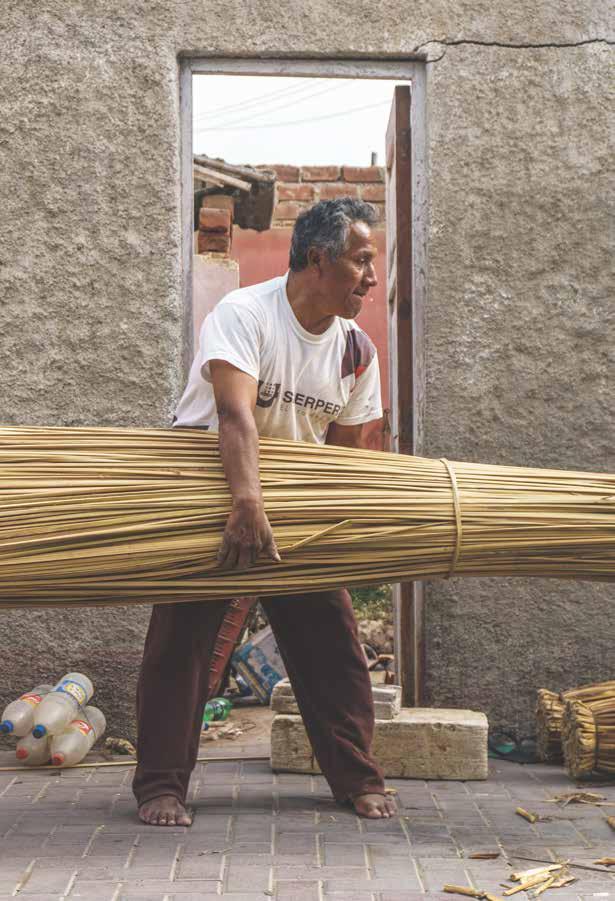 A Huanchaco fisherman crafts a caballito de totora (“little reed horse”), a traditional Peruvian watercraft thought to be the world’s first surfing vessel.
A Huanchaco fisherman crafts a caballito de totora (“little reed horse”), a traditional Peruvian watercraft thought to be the world’s first surfing vessel.
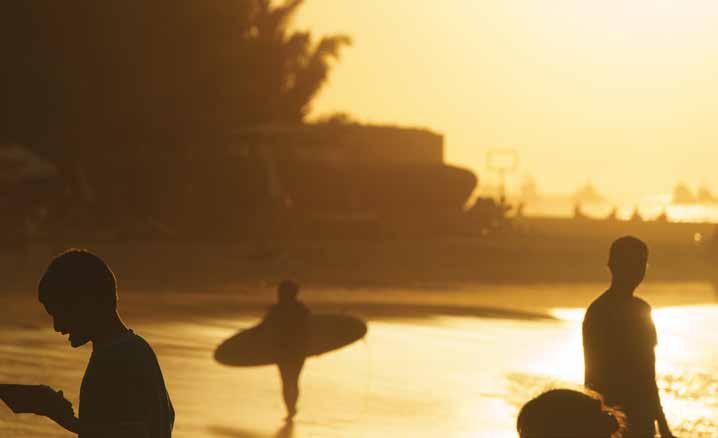
Peru’s northern coast is a magnet for surfers seeking world-class waves.
If the waves are too crowded in Máncora, numerous alternatives dot the coasts of Piura and Tumbes, including Los Organos, Punta Sal, Panic Point, and Lobitos. Then there’s Cabo Blanco, about 20 miles southwest of Máncora. In the 1950s and ’60s, this previously sleepy fishing village became the place to be for big-game fishing. Hemingway stayed for more than a month at the once-famous Cabo Blanco Fishing Club, which also hosted Gregory Peck, John Wayne, Spencer Tracy, Marilyn Monroe, and more. Back then, the reputation of Cabo Blanco was enhanced by a worldrecord catch: a 1,560-pound marlin caught in 1953, which remains the largest marlin ever landed on rod and reel.
Today, Cabo Blanco sits in quiet, faded glory. The fishing is still good, but the village no longer attracts the jet set. But it does attract surfers. Cabo Blanco is home to the “Peruvian Pipeline,” a wave that inspires a level of fanaticism that draws in surfers from across the globe. Sometimes compared to Hawai‘i’s Banzai Pipeline, it’s a heavy, fast left-hand barrel that ranks among the best waves in South America. On the downside, it doesn’t break often—but when it does, surfers flock to Cabo Blanco for a chance to ride one of Peru’s most epic waves.
の海岸には、ロス・オルガノスやプンタ・サル、パニック・ポイント、ロビトス など、サーフスポットはいくらでもある。マンコラから約32キロ南西に向か えば、そこはカボ・ブランコ。1950〜60年代にかけて、ひなびたただの漁 村だったカボ・ブランコは大がかりなゲームフィッシングのロケーションと して一躍脚光を浴びる。ヘミングウェイもひと月以上滞在したかの有名な〈 カボ・ブランコ・フィッシング・クラブ〉は、グレゴリー・ペック、ジョン・ウェイ ン、スペンサー・トレイシー、マリリン・モンローも宿泊者名簿に名を連ねて いる。1953年、世界記録である約708キログラムのカジキが釣り上げら れ、カボ・ブランコの名はさらに世界に広まった。釣り竿で釣り上げられた 最大の魚として、いまだにこの記録は破られていない。 現在のカボ・ブランコは過去の栄光に包まれ、静かにたたずんでい る。ゲームフィッシングは今も盛んだが、昔のようにきら星のような有名人 が集う場所ではない。だが、サーファーはここに惹きつけられる。カボ・ブラ ンコの“ペルー版パイプライン”と呼ばれる波を目指し、世界各地から熱狂 的なファンが訪れるのだ。ハワイのバンザイ・パイプラインにもなぞらえるこ の波は、パワフルでスピード感のあるレフトハンダーのバレルで、南米屈指 の波とされる。めったにブレイクしないのが玉に瑕だが、カボ・ブランコの波 がひとたびブレイクすれば、ペルー最高のエピックな波に乗る瞬間を夢見 てサーファーたちが押し寄せるのだ。
90 PALM
ESCAPES Peru E

Mother Nature
Text by Anna Harmon
文 = アナ・ハーモン
by Zen Moriya
写真 = ゼン・モリヤ
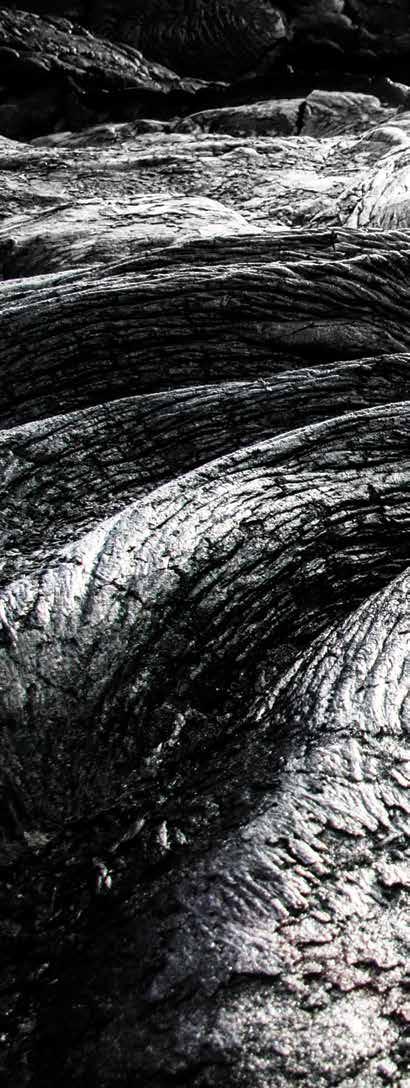
92 E PALM
創造する母たち
ESCAPES Puna
Images

A writer reflects on birth in the district of Puna, where a volcanic eruption forever altered the lay of the land.
火山の噴火が永遠に地形を変えたプナ 地区で、生命の誕生に思いを馳せます。
Looking at a map tracing the eruption in Puna in 2018, I see my body. The land has a wound cutting thinly across it, a dotted line of 24 fissures from which lava rose from underground and flowed along the island’s slopes. In 2021, I delivered my daughter via cesarean section; drawn across my own body is a long, delicate scar where my torso was opened and my child was removed from my womb. Just like that day when a new life came into my world, new land was created over the months those fissures opened and lava met the ocean on the eastern side of Hawai‘i Island, where the Hawaiian goddess Pele resides at Kīlauea, a shield volcano with a summit caldera and two active rift zones.
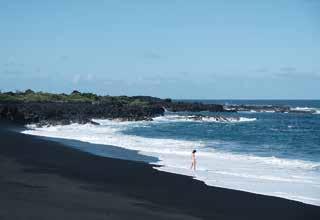
But the lava didn’t erupt from the center of the volcano like the most archetypal of births. Instead, a backup in the system of Pu‘u Ō‘ō crater, which emerged from a fissure 35 years ago in the east rift zone and had been erupting continuously for 35 years, caused the summit caldera to partially collapse. The earth shook as the lava drained out and then erupted forth from a new fissure in Leilani Estates. Another fissure opened, and then another, following the underground rift. By the time the eruption subsided, lava fields had covered 13.7 square miles. Black sand beaches are still forming as bits of lava wash ashore, and ferns are beginning to grow in the cracks of lava flow that buried land, roads, and homes. Steam still grows dense
2018年のプナ地区の噴火をたどる地図は、わた し自身の体のようだ。24の割れ目噴出口をたどる 線は、大地が薄く切り裂かれた傷跡。地中から噴き 出した溶岩は、そこから地面の傾斜に沿って流れ た。2021年、帝王切開で娘を出産したわたしの体 にも、繊細な長い傷跡が刻まれた。体が切り開か れ、子宮から子供が取り上げられた証だ。わたしの 世界に新しい生命が登場したあの日のように、噴 出口が開き、溶岩がハワイ島東の海と出会い、何ヶ 月もかけて新しい大地が生まれた。ハワイ島キラウ エア火山には女神ペレが住んでいる。楯状火山で あるキラウエアは山頂にカルデラを抱き、今もふた つの噴火帯で活動が続いている。
今回の溶岩流は、典型的な大地の誕生のよ うに火山の中心から噴き出したわけではない。35 年前に東の噴火帯に出現し、以来35年間継続的 に噴火している“プウ・オオ”火口で詰まりが生じ、 山頂のカルデラの一部が陥没した。そして、大地 を揺るがせてカルデラから下がった溶岩が、レイ ラニ・エステイツの新しい噴出口から噴き出した のだ。地中の亀裂に沿って次々に割れ目噴出口が 現れ、噴火が収まるころには13.7平方マイル(約 10,000坪)の大地が溶岩におおわれていた。そし て、溶岩のかけらが浜辺に流れ着いて黒砂のビー チがいくつか出現し、大地と道路と家屋をのみ込 んだ溶岩の隙間からはシダが育ちはじめている。 雨が降ると固まった渦巻き模様の溶岩から湯気 が立ちのぼるのは、まだ完全に冷えきっていない からだ。
わたしが初めてプナ地区を訪れたのは 2013年。キラウエアの溶岩はまださかんに流れて
Translation by Eri Toyama Lau
翻訳 = ラウ外山恵理
94
한
인해 땅의 지형이 영원히 바뀌었던 푸나 지역의 탄생에 대해 성찰하고 있다.
작가가 화산 폭발로
E ESCAPES Puna
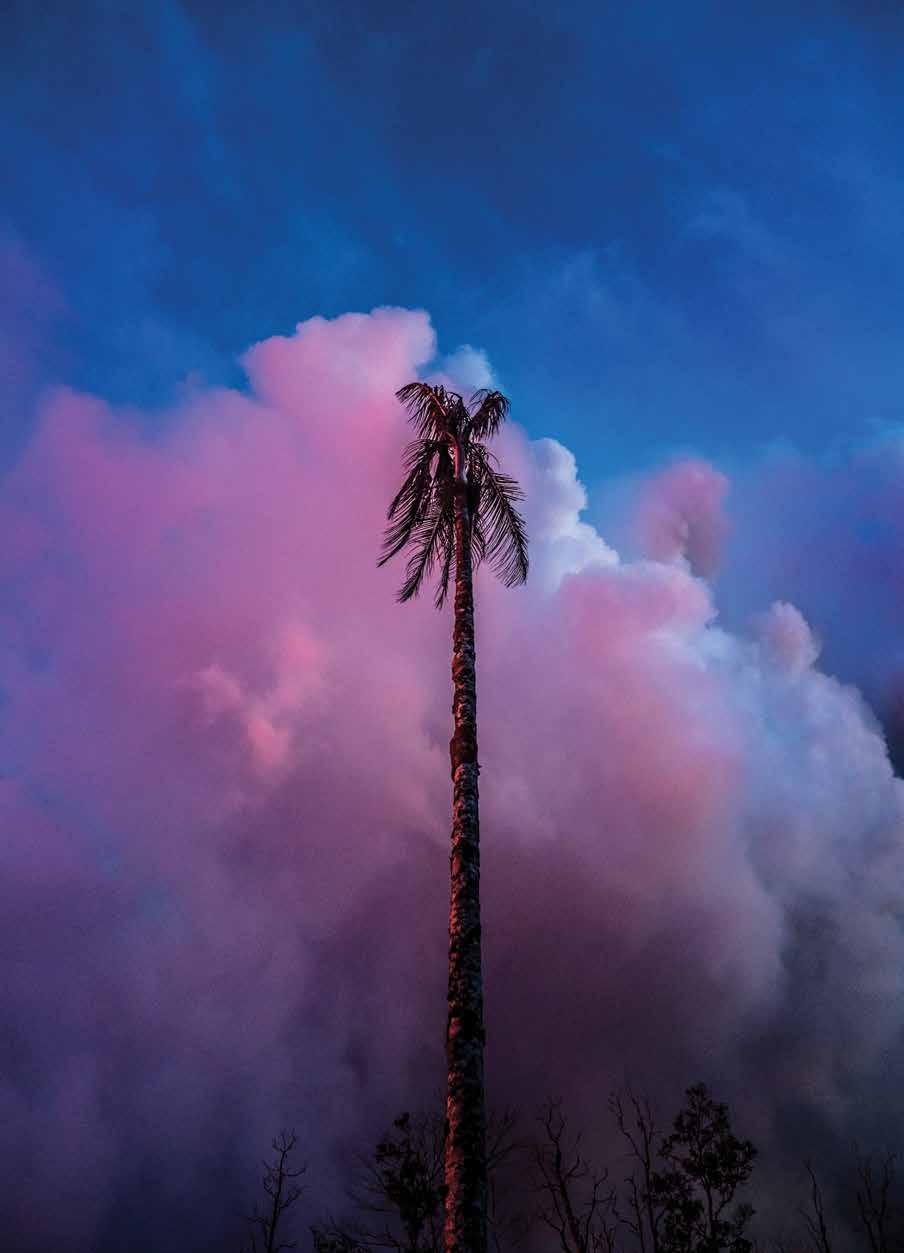
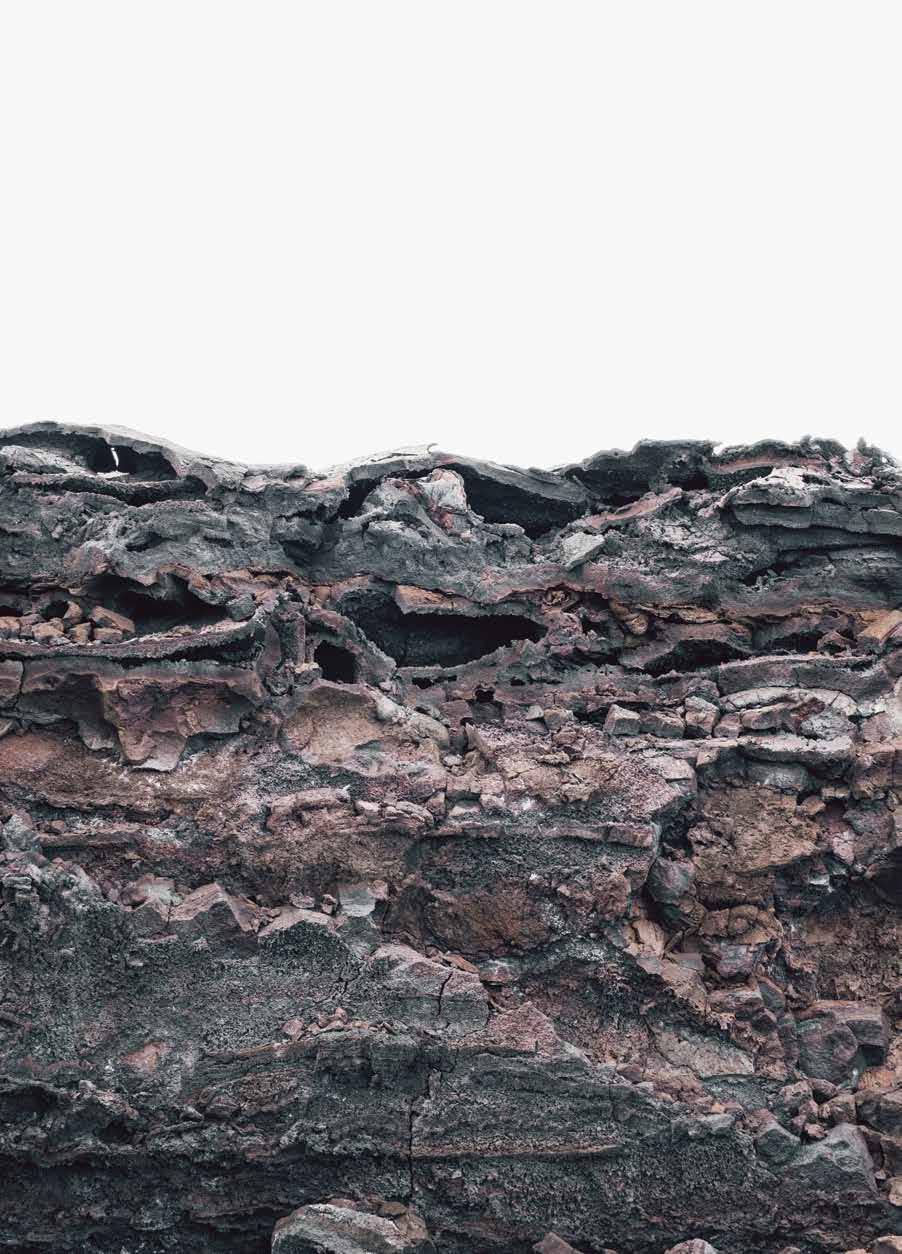
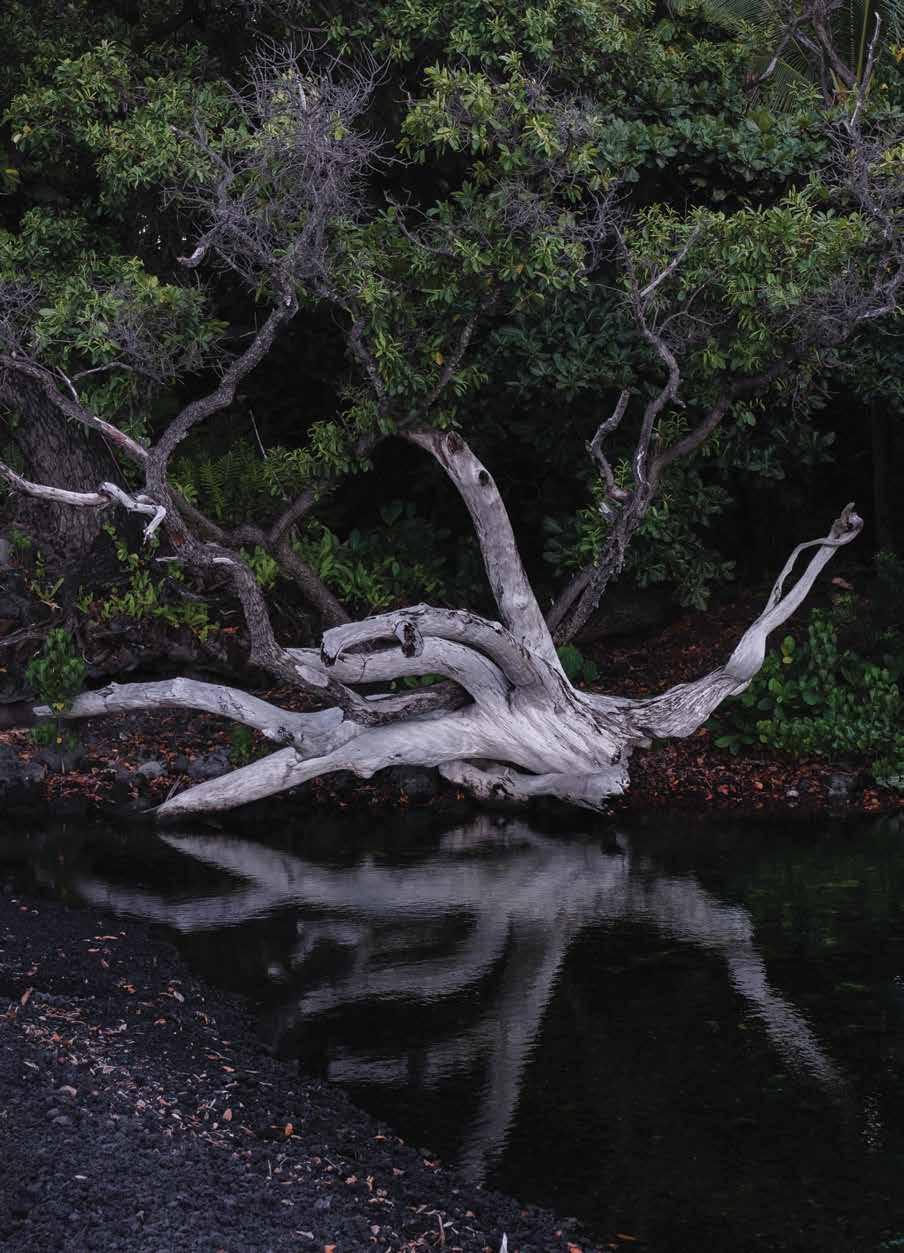
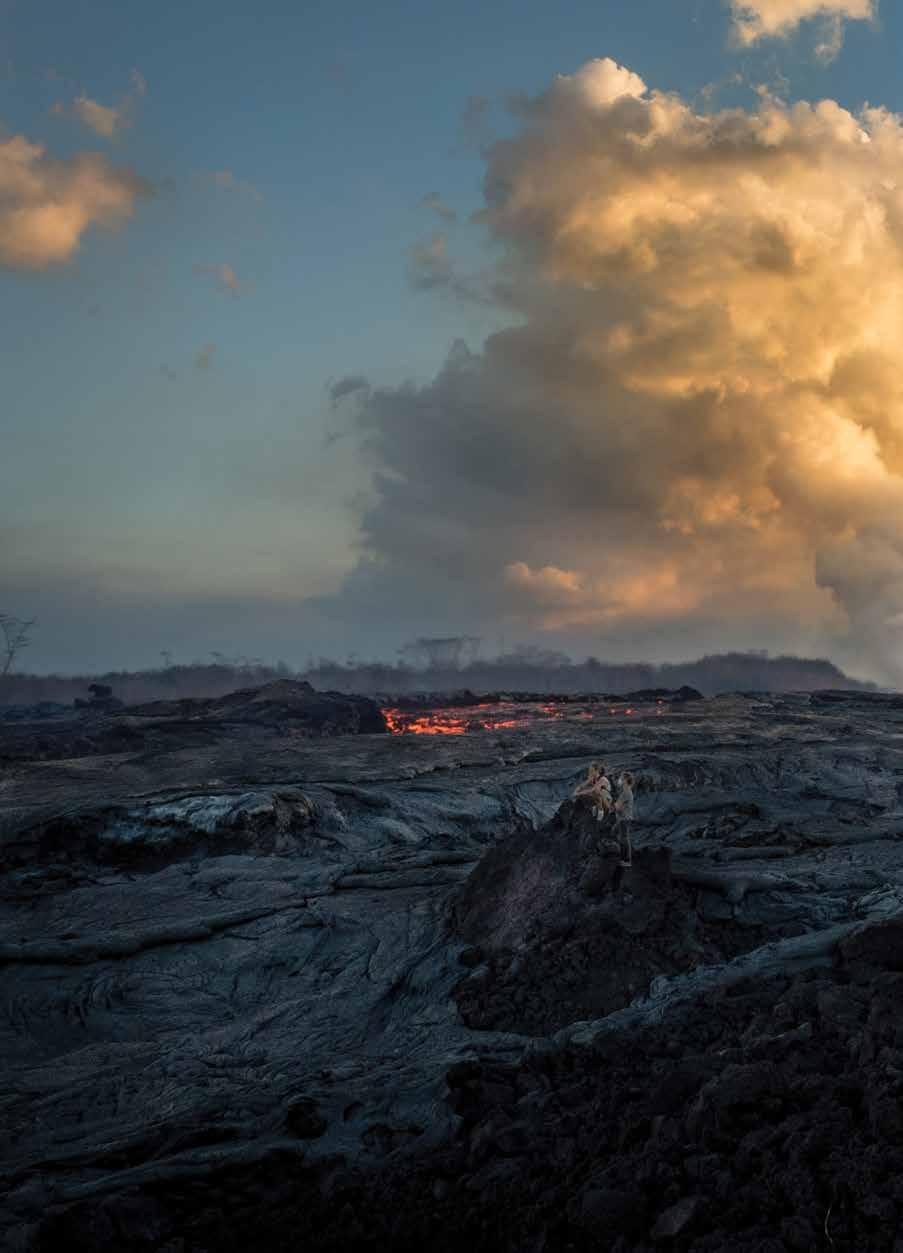
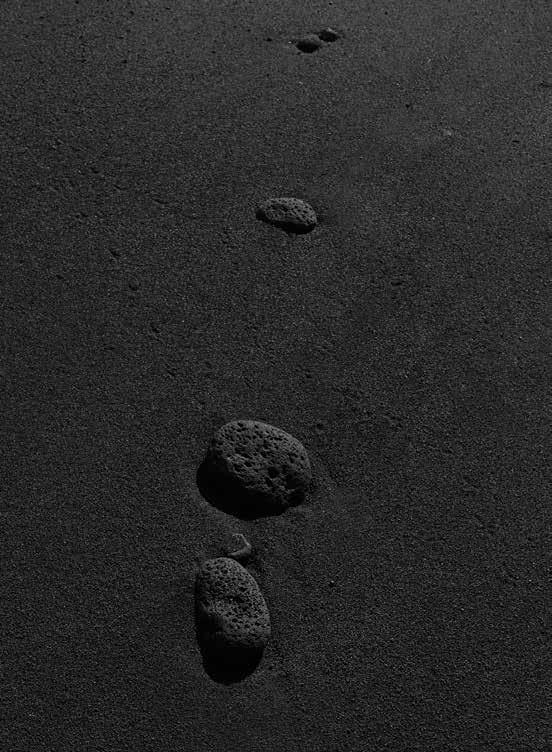
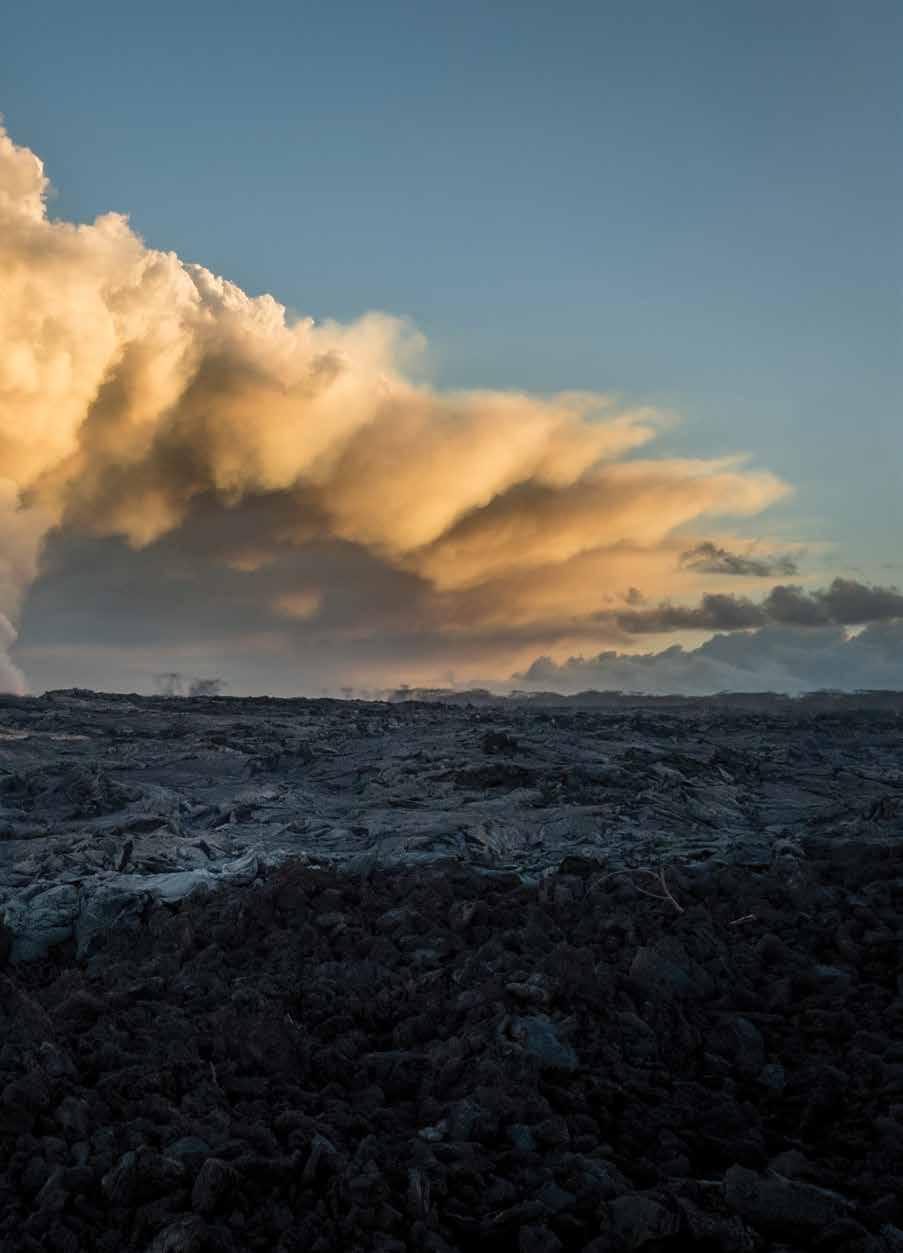
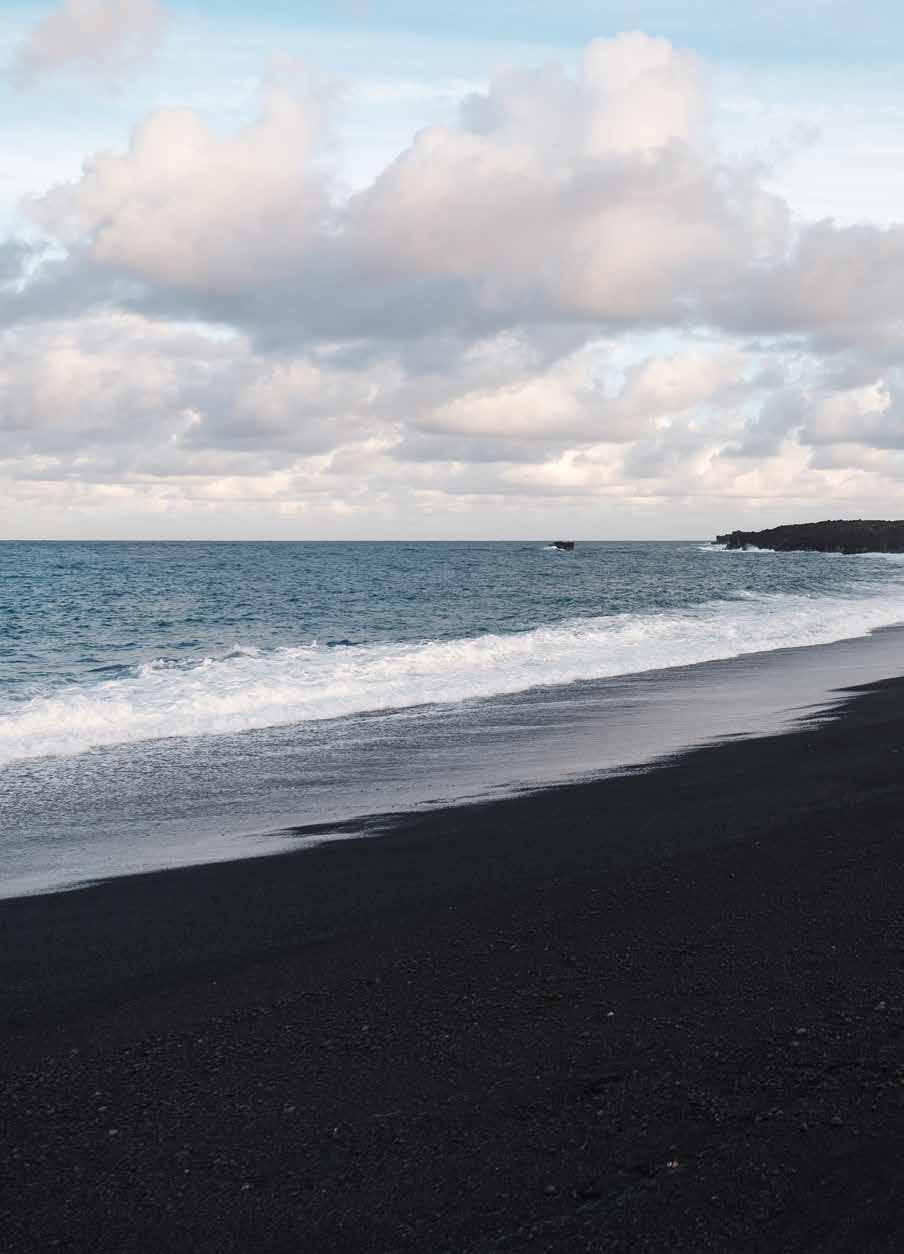
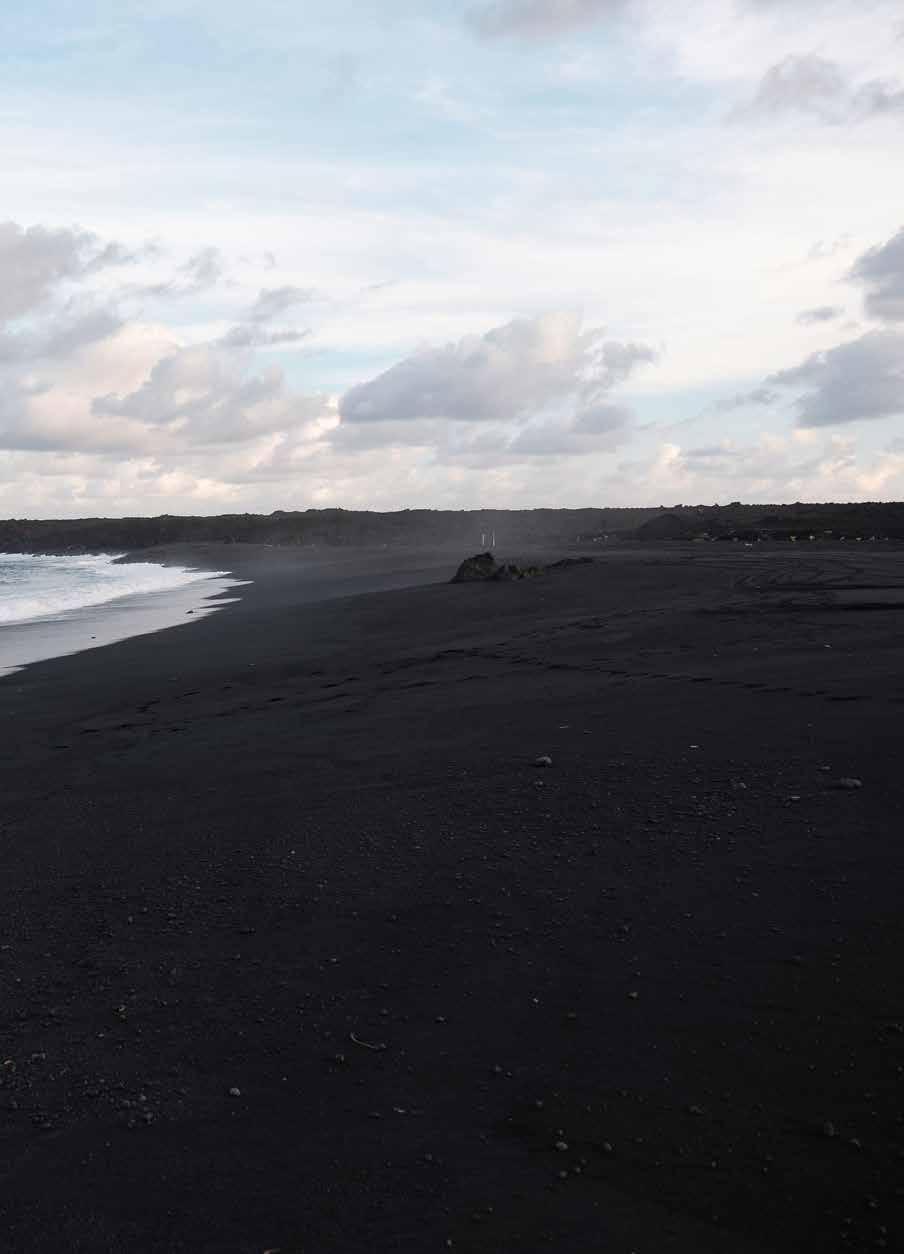
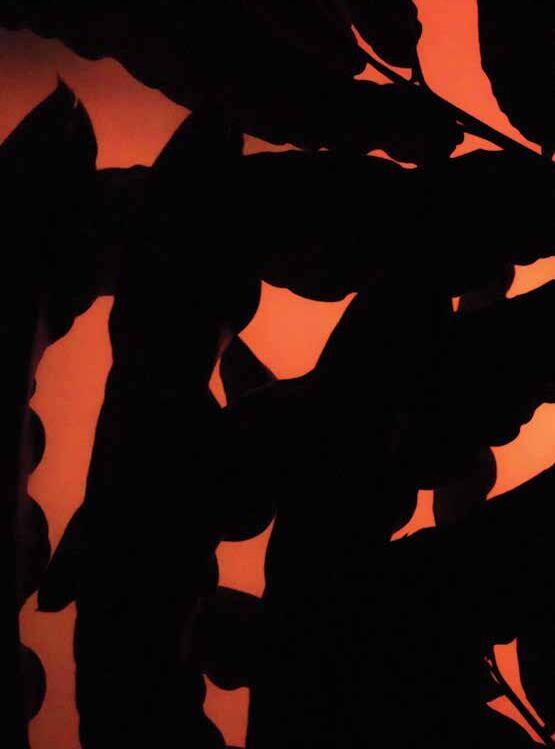
over whorls of hardened lava when it rains, because it is still cooling.
I first visited Puna in 2013 at a time when Kīlauea was actively flowing. On a walking tour that started in Kalapana, our guides led us across plains of lava field that in 1990 to 1991 consumed nearly all of the town, where their families were from. Eventually we reached molten lava that rolled down the slope, and from afar we saw lava entering the ocean at the bottom of a steep cliff, steam rising up where it met the sea.
When you become a new parent, your vision narrows to the size of a newborn. Look how tiny their hands are, watch the way they look at your face. As they grow, your vision expands to their range of movement. Now that they can crawl across the sand, you see a whole swath of beach.
In some ways, visiting Puna for the first time after the 2018 eruption felt like navigating the world with a newborn. My vision narrowed to signs of the flow, and my hearing was tuned to stories of that brief period. On the road from Kalapana to Pohoiki Bay, the lush treeline of the Malama Kī forest reserve suddenly dropped away to hardened lava and sky, then back to dense forest, then back to lava. The road looked quickly cleared and repaved in the places where lava reached the sea.
When the 2018 eruption started, I was living in Arizona. Like the rest of the nation, I followed the news from afar as lava overwhelmed more than 700 dwellings in Kapoho Beach Lots, Vacationland, Leilani Estates, and Lanipuna Gardens and created 875 acres of new coastal land. Now, I realized, I could only visit Kapoho tide pools and Ahalanui hot springs in memory, as both were buried on Pele’s way to the sea. Highway 137 no longer reaches Kapoho from Pohoiki Bay, and where the road south from Pāhoa used to meet a four-way intersection locals called “Four Corners,” lava has rendered it just one road with a right angle. Past Four Corners, where land meets sea miles away, there is a new black sand beach, one of a few that were formed in the wake of the eruption.
Highway 137 from Kalapana is now the only way to
いた。カラパナから出発する徒歩ツアーでは、ガイドに案内されて1990年から 1991年に流れた溶岩の原野を歩いた。ガイドの家族が住んでいた町のほぼ 全域をのみ込んだ原野だ。やがてわたしたちは斜面を下る溶岩流にたどり着 いた。そして、溶岩流が切り立った崖の下の海へと落ちていき、もうもうと蒸気 が上がるのを遠くから眺めた。
親になると、視野が新生児と同じくらいの大きさになる。娘の手の小ささ や、娘がわたしの顔を見る表情といったことしか見えなくなるのだ。娘が少し 成長すると、娘が動く範囲に合わせて視野も広がり、娘が砂の上をはいはいで きるようになった今、ようやくビーチ全体が見渡せるようになった。
2018年の噴火後初めてプナ地区を訪れたわたしは、ある意味で新生児 と一緒に新しい世界を探索しているような気分だった。視線は溶岩が流れた 跡に吸い寄せられ、溶岩が流れていた短い時間に起こった物語に耳を傾ける。 カラパナからポホイキ湾に向かう道すがらの景色は、生い茂ったマラマ・キの 保護林だったかと思えば、突然、固くなった溶岩と空の景色に変わり、また緑 濃い森が現れたかと思うと、また溶岩原にとって変わる。溶岩が海に到達した 地点はすでに整備され、道路はきれいに舗装されていた。 2018年の噴火がはじまったとき、わたしはアリゾナに住んでいた。カポ ノ・ビーチ・ロッツ、バケーションランド、レイラニ・エステイツ、ラニプナ・ガーデ ンズの700戸以上の住宅をのみ込んだ溶岩が、875エーカー(約100万坪)に およぶ新たな海岸沿いの土地を生み出すのを、全米の人々と同様に遠くから 見守った。そして今、実感する。カポホのタイドプールも、アハナルイの温泉も、 ペレが海へ向かった道の下に埋もれてしまい、もはや記憶のなかで訪れること しかできないのだ。ハイウェイ137はもはやポホイキ湾とカポホを結んではい ない。パホアの南から続く道が地元の人たちが“フォー・コーナーズ”と呼んだ 四つ角につながっていた場所は、もはや右に曲がる道一本しか残っていないの だ。だが、フォー・コーナーズの何マイルか先の海には、新しい黒砂のビーチが 生まれていた。噴火のあとに生まれた新しいビーチのひとつだ。 現在アイザック・ヘイル・ビーチ・パークとしても知られるポホイキ湾へは カラパナ方面からハイウェイ137で行くしかない。2018年の噴火前のポホイ キ湾は、地元のサーファーたちが集まるサーフスポットであり、プナでは珍しく
102 PALM ESCAPES Puna E
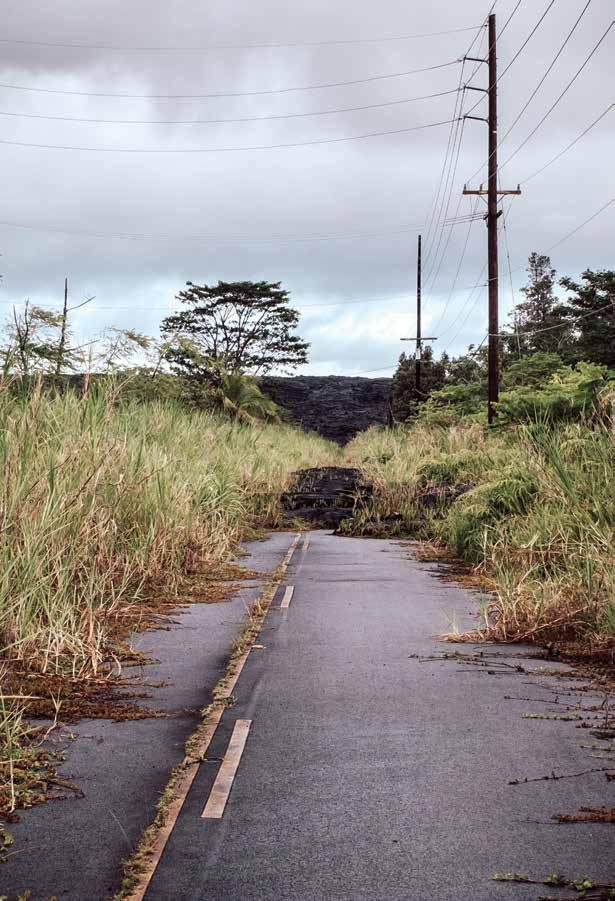 Lava flows from the 2018 eruption in the Puna district of Hawai’i Island buried the road that once connected Highway 132 to Pohoiki Bay.
Lava flows from the 2018 eruption in the Puna district of Hawai’i Island buried the road that once connected Highway 132 to Pohoiki Bay.
reach Pohoiki Bay, also known as Isaac Hale Beach Park. Before the 2018 eruption, Pohoiki Bay was a destination for local surfers and the rare place in Puna where the ocean could be accessed by boat. When I arrived, I found a parking lot backed by towering black lava, which stopped right before the bay. The bay itself, initially spared, has since filled with volcanic bits, and now the boat ramp leads down into a thermal pool separated from the ocean by a fresh expanse of black sand beach. The waves were also changed by the volcanic influx, erasing the breaks from the surface of the sea.
As I stood on the beach, I watched a father walk over the sand and rocks with two teenage children. They were buffeted by a warm wind as he pointed out where he had surfed, before things changed.
“I don’t know what dad’s tripping about,” I overheard his son say. “I see a wave.”
“Where?” the daughter asked.
“Where the waves used to be,” the son said.
My daily life looked very different before the birth of my child. One day, I imagine, my before and after will merge, her arrival instead marking a shift in my terrain. Yet what adults think of as “after” is the only time our keiki (children) know; they breathe life into transformed spaces as we recall the topography of the past.
As mo‘olelo (legend) and the landscape reveal, the 2018 eruption was far from the region’s first. Along Highway 137, black-topped cliffs hold tide pools where families set up tents and children play in the water. Looking at a satellite image of Hawai‘i Island from above, you will find the easternmost tip shaded gray from the 1960 eruption behind Kapoho town and a faded dark swath like a birthmark running north of Leilani Estates, where lava flowed in 1840 and streams up to two miles wide entered the sea.
For Amy Ka‘awaloa, who was born and raised in Kalapana and evacuated twice before losing her home at age 16 to the 1990 eruption, there are days when she looks at old pictures and is overwhelmed with grief. “There is still new meaning that can be created from this new place that Pele has created,” she says in a video interview posted on the Hawai‘i County Facebook page Kīlauea Eruption Recovery. “But the feeling and emotions will still be there.”
Birth cannot be separated from loss. My child’s middle name is the first name of my grandmother, who passed away a year before my daughter was born. My uncle died months after my daughter’s birth, surrounded by his own children and siblings. As we raise children, one life gives way to another, and elders become ancestors.
ボートで海に出られる場所だった。たどり着いたわたしが見たのは、そびえ立 つ黒い溶岩に囲まれた駐車場。黒い溶岩の壁は、湾のすぐ手前で切れている。 湾そのものは溶岩流をまぬがれたものの噴出物で埋まってしまい、ボートラン プは新たに広がった黒砂のビーチで海から切り離された温水の潮だまりにつ ながる格好となっている。溶岩の流入によって地形も変わり、波もブレイクしな くなってしまった。
ビーチに立つわたしの横で、ひとりの父親がティーンエイジの子供ふた りと岩や砂を踏みしめて散歩していた。温かい風に吹かれながら、地形が変わ る前に自分がサーフィンしたポイントを子供たちに示している。
「父さんは大げさに何を言ってるのかな」息子の言葉が耳に飛び込んで きた。「波ならあるじゃないか」
「どこに?」娘のほうがきき返した。
「昔、波があったと言っているところに」息子は答えていた。
娘が生まれる前のわたしの生活は、今とはだいぶ違っていた。もしかした ら、娘の誕生はわたしという地形を変えたわけではなくて、娘が生まれる前と 後のわたしの世界がひとつになる日がやがて来るのかもしれない。だが、ケイキ (子供)は、大人が“子供が生まれた後”とみなす世界しか知らない。過去の地 形を思い浮かべるわたしたちの前で、彼らは新しい世界に生命を吹き込んで いる。
モオレロ(伝説)と地形が示すとおり、2018年の噴火はこの地区が初め て体験した噴火ではない。ハイウェイ137の黒い岬沿いには、家族連れがテン トを張って子供たちを遊ばせる潮だまりがたくさんある。ハワイ島の衛星写真 を見ると、島の最東端が1960年のカポホ裏の噴火で灰色に翳り、1840年に 溶岩流が2マイルの広さで海に注ぎ込んだレイラニ・エステイツ北部には痣の ように薄くひとはけの影があるのがわかる。
カラパナで生まれ育ち、4回の避難を経験した後、16歳だった1990年 に家を失ったエイミー・カアワロアさん。古い写真を見ながら悲しみに押しつ ぶされそうになる日もあるそうだ。「女神ペレが創り出した新しい大地に、新た な意味を見出す日も来るかもしれません」ハワイ郡がフェイスブック上で運営 する“キラウエア・エラプション・リカバリー(キラウエア噴火からの復興)”のペ ージにアップロードされたビデオインタビューのなかで、エイミーさんは語って いる。「でも、悲しいと思う気持ちは今もそこにあるんです」 誕生は喪失と切り離せない。わたしの娘のミドルネームは、娘が生まれ る1年前に他界したわたしの祖母のファーストネームだ。娘が誕生して数カ月 後に、今度はわたしの伯父が子供たちや兄弟に囲まれてこの世を去った。人は 子供を育て、命を引き継ぐ。年老いたものたちは、やがて先祖となる。
104 PALM
ESCAPES Puna E

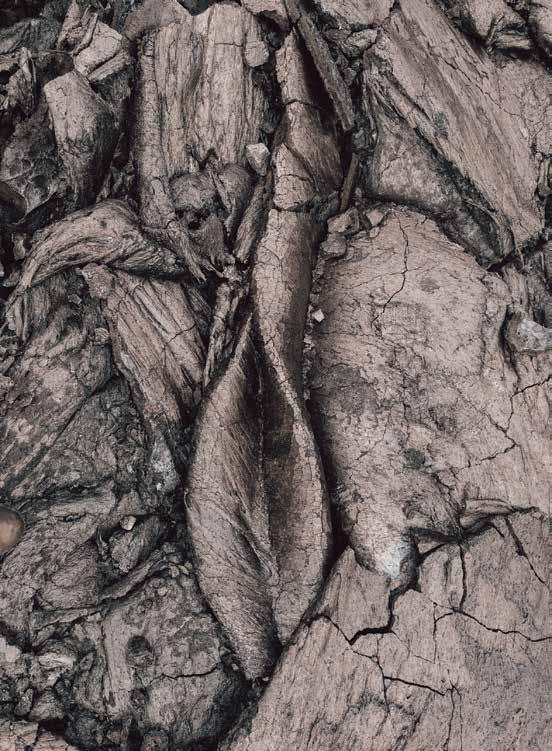
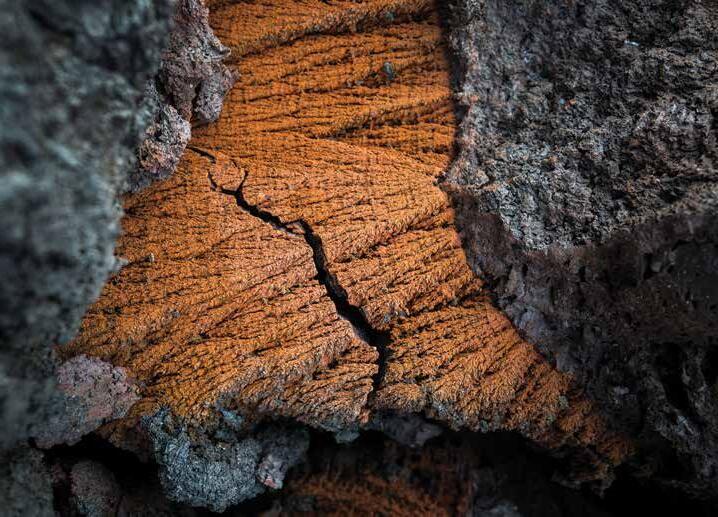
In mo‘olelo, Puna is said to be the land where the sun rises, where the day begins. It is fragrant with hala and rich with ‘ōhia. It is fertile farm land. It is warm green and resilient blue and deep black. Here, Pele’s ways have birthed new land on Hawai‘i Island and buried the hard work and homes of its residents, who are intimately aware of her inclination to flow freely. In birth, I too was consumed by nature’s power of creation. Now, my daughter and I flow through the world together, looking to see what she will make of it all.
モオレロでは、プナは太陽が昇る場所、一日がはじまる場所とされ ている。ハラの香りに満ち、オヒアの花が咲き乱れる肥沃な農地。ぬくもり のある緑色と力強い青、そして深い黒に囲まれた場所。ペレの通る道はそ こに住む人々の苦労も彼らの家ものみ込んで、ハワイの新しい大地を産み 出していく。人々は、自由気ままに好きなところへ流れるペレの性格をよく 理解している。出産のとき、わたしもまた自然がもたらす創造の力に包まれ た。そして今、娘とともに世界を歩きながら、娘がそこから何を見出すのか を楽しみに見守っている。
106 PALM
E ESCAPES Puna

Culinary delights and
PALM 食 F PALM
FA RE
delectable hidden gems
109
F PALM

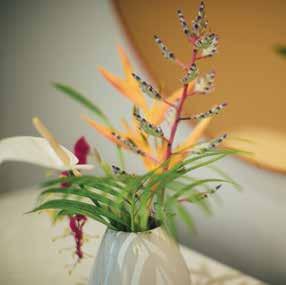
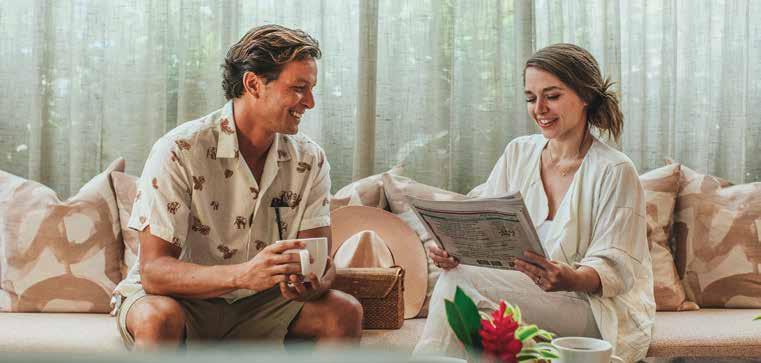
An Intimate Oceanside Escape
If you’re a Honolulu local looking for a little R&R, or for a chic spot to send visitors with an appetite for adventure, Hotel Renew serves as an enjoyable jumping-off point to recharge and experience all the wonders of O‘ahu. Just a block from Waikiki Beach, the charming seaside hotel is mid-century meets modern tropical, with a lot more to offer than breathtaking views of the Pacific Ocean.
PALM

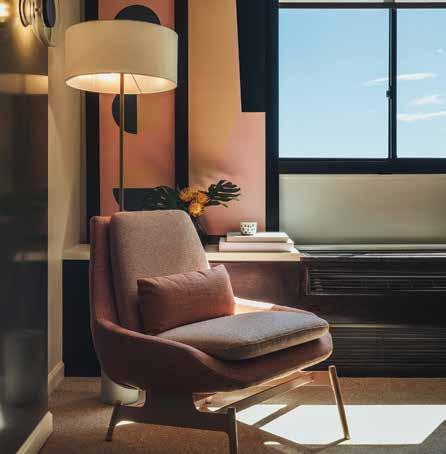


Why Renew?
Hotel Renew gives go-getter guests easy access to the island’s well-known and off-the-beaten-path places. From this centrally located sanctuary, you can hit the surf, sand, and shops of Waikiki, cruise the indie coffee shops and specialty boutiques of neighboring Kaimuki, or scout for murals in the nearby arts district of Kaka‘ako. Then return and recharge with an array of hotel offerings, including in-room Illy espresso and coffee machines, free access to workout gear, and complimentary yoga in the park every Saturday morning.
hotelrenew.com
808.687.7700 | 129 Paoakalani Avenue, Honolulu, HI 96815
Mid-century modern details are infused with tropical flair at this charming seaside hotel located half a
PALM
block from Waikīkī Beach.
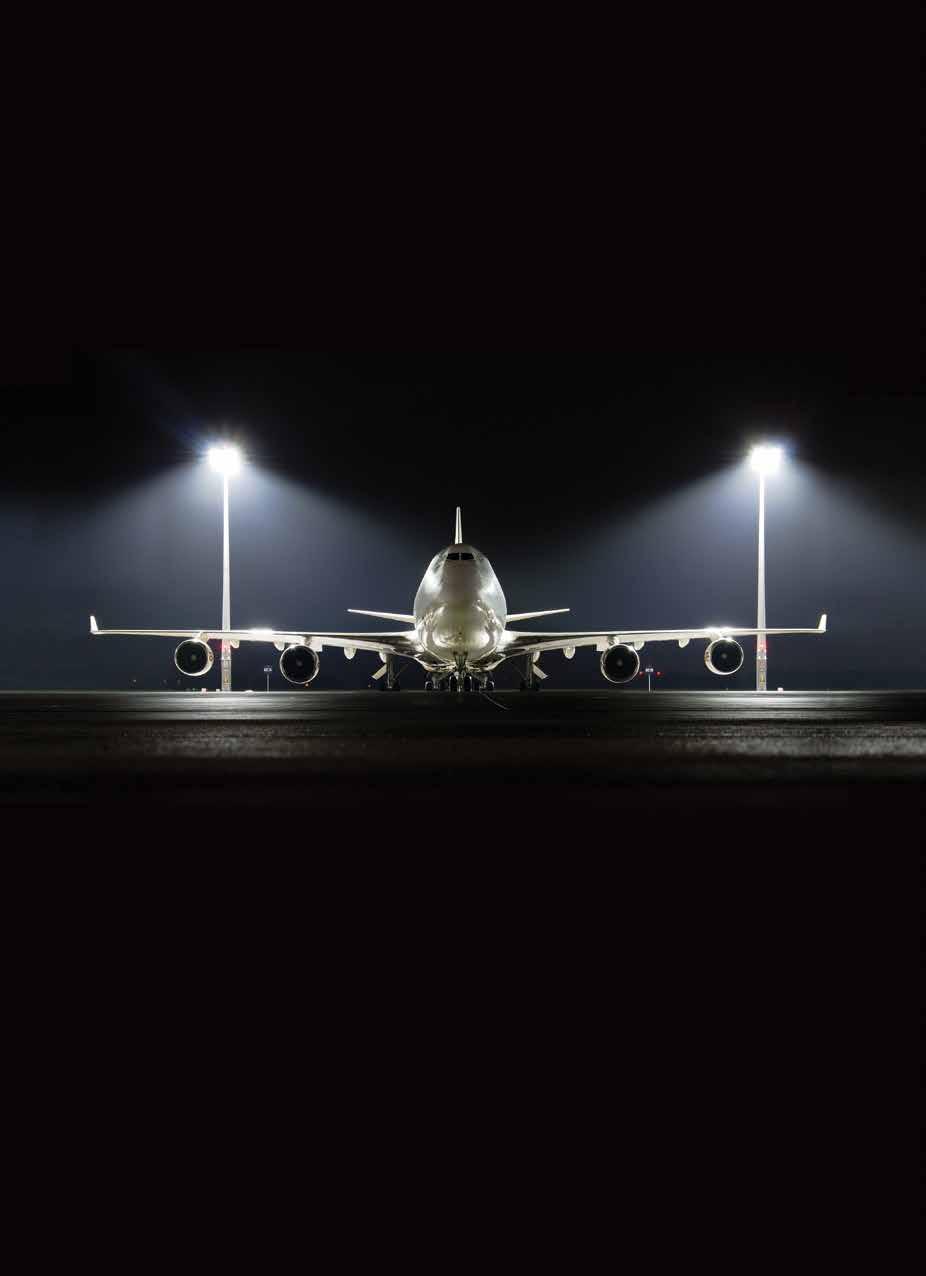
Boeing 747-400 Nose Loader service and Ad Hoc charters on demand. Connecting LAX and HNL For more information, a free quote or to book online visit pacificaircargo.com or call 808.427.1235 AIR FREIGHT SPECIALISTS EXCEEDING ALL EXPECTATIONS daily with daily connections to Neighbor Islands and weekly service to Pago Pago and Guam.
Shave Vice
At
this truffle-centric dining concept, guests
can indulge in the fanciest of fungi.
トリュフを中心とする新しいコンセプトの ダイニングシーンで、きのこの最高峰を堪 能してみませんか。
When Tokyo-based tech
exec and bon vivant
Text by Lesa Griffith
Images courtesy of Margotto Hawai‘i
= マーゴット・ハワイ提供

Kazutomo “Robert” Hori couldn’t find the right balance of luxe ingredients and relaxed atmosphere that he looked for in a restaurant, he created his own. The result was Margotto e Baciare, opened in 2014 in Tokyo’s Roppongi district. Now he is branching out to places that he loves. In June 2022, he opened his first outpost—Margotto Hawai‘i, where truffle hunters go to indulge in the fanciest of fungi.
While Margotto sounds Italian, it is actually a play on “marugoto,” a Japanese word meaning “the whole thing.” Referencing its properties as an aphrodisiac, Hori encourages diners to “eat the whole truffle and kiss your date,” he says, chuckling.
Hori is a “carpe diem” type of guy. When he isn’t surfing on O‘ahu, he’s running trail races in Chamonix, France. He has competed in the grueling 156-mile Marathon des Sables through the Saharan sands of Morocco. But he is no ascetic living on massaged kale.
The concept for Margotto was born in Hori’s home. He was taking clients to restaurants five days a week and realized there were few places he loved enough to want to eat at weekly. So he entertained at home, buying and preparing one of his favorite ingredients—truffles—and pairing them with selections from his wine cellar.
“I was a terrible cook, but my friends were still enjoying it,” Hori
東京を中心に活躍するテクノロジー界の立役者 でありボンヴィヴァン(美食家)の堀主知(かずと も)・ロバートさん。高級な食材と、くつろいだ雰囲 気。その両方を絶妙のバランスで楽しめる店が見 つからなくて、ある日、自分でつくってしまった人 だ。2014年、東京六本木にオープンした〈マルゴ ット・エ・バッチャーレ〉がその店。そして今、堀さ んは大好きな場所にも進出をはじめ、2022年6 月に支店第一号である〈マルゴット・ハワイ〉を開 店した。極上のトリュフを心ゆくまで堪能できるレ ストランだ。
“マルゴット”といえばイタリア語のようにも 聞こえるが、じつは”まるごと”の言葉遊び。トリュフ には媚薬としての効用もある。店を訪れる人々に は”トリュフをまるごと食べて、恋人に口づけを”と 勧めている。堀さんはいたずらっぽく笑いながら教 えてくれた。
“カルペ・ディエム(今この瞬間を楽しむ)”の 精神をそのまま体現する堀さん。オアフ島でサーフ ィンをしていないときは、フランスのシャモニーのレ ースで山道を走っている。モロッコのサハラ砂漠を 横断する約250キロの過酷な〈サハラマラソン〉の 出場経験もあるが、塩揉みしたケールのみで生き るストイックなタイプではない。
〈マルゴット〉のコンセプトは自宅で生まれ たそうだ。週に5日は接待で外食しながら、毎週訪 れたいと思うほどお気に入りの店はほとんどない ことに気づいた堀さん。そこで、お客を自宅に招き、 大好物の食材のひとつ、トリュフを使った料理と、 自宅のワインセラーから選んだワインをペアリング して楽しんでもらうことにした。
트러플 중심의 이 다이닝
Translation by Eri Toyama Lau 翻訳 = ラウ外山恵理
114
컨셉에서, 고객들은 가장 화려한 버섯들에 빠져들 수 있다. F FARE Promotional
削る媚薬 文 = レサ・グリフィス 写真



Due to their rarity, short shelf life, and distinctive flavor and aroma, truffles are a delicacy that rivals caviar.
laughs. To up the ante, he engaged Tokyo’s top chefs to make truffle magic. One of those chefs was Hiroyuki Kanda, whose eponymous restaurant has earned three Michelin stars since 2008, when the guide began awarding the ratings in Japan.
Kanda encouraged Hori to open a restaurant, and the entrepreneur agreed to take him up on the challenge—if Kanda could deliver him a stellar chef. Enter Kenta Kayama, whose resume includes Kanda and L’Atelier de Joël Robuchon, and who now serves as executive chef of Margotto Group. Working with longtime Margotto e Baciare chef Yohei Yagishita, who relocated from Tokyo to assume the position of executive chef at Margotto Hawai‘i, Kayama delivers that successful marriage of French and Japanese cuisines, with a shot of Italian. Think haute cuisine with dashi.
The best truffles give off a potent aroma that affects your brain—it is made up of chemicals that mimic mammals’ pheromones. Add to that their rarity (they are difficult to farm and hard to find in the wild due to climate change) and short shelf life (once dug out of the ground, they are at their best for just four days, when they start losing their heady scent), and you have a delicacy to rival caviar.
The most prized truffles come from France and Italy in winter, so in summer, truffles from the Southern Hemisphere—Australia and even Chile and South Africa—fill the seasonal gap. They are best enjoyed when shaved fresh atop simple dishes—classic European truffle pairings include egg (like an omelet in France) and pasta (like cacio e pepe in Italy). Margotto sticks to that tradition, with signature dishes such as a round of toasted Japanese milk bread topped with a rich orange yolk and surrounded by a port reduction, and housemade linguine tossed with butter and Parmesan, both blanketed in truffle shavings.
Margotto Hawai‘i offers a chef’s tasting menu of 10 courses for $100, with the option to upgrade to Wagyu beef and add additional courses such as beluga caviar. After selecting a menu, diners then choose a type and amount of truffle to be shaved atop select dishes at an additional cost, since the price of truffles, like gold, changes with the market. A server brings a box of the fungi for examination and recommends 20 grams per person for the full truffle experience. (A gram is equivalent to the mass of a dollar bill.) Hori estimates that black truffles will be $3.75 per gram this winter, and white truffles will go for $10 per gram. Prices tend to be
「僕自身の料理の腕はさっぱりなんですが、けっこう喜んでもらえたんで すよ」堀さんは愉快そうに笑う。そこでレベルアップをはかるため、東京屈指の トップシェフを起用してトリュフマジックを披露してもらうことにした。そんなシ ェフのひとりが神田裕行さん。みずからの名前を冠した〈日本料理 かんだ〉 は、ミシュランが日本での格付けをはじめた2008年からずっと三つ星の栄誉 に輝き続けている。
神田さんは堀さんにレストランの開店を勧め、起業家である堀さんも、神 田さんが一流のシェフを紹介してくれるならという条件で応じた。そして登場 したのが、加山賢太さんだ。〈かんだ〉をはじめ、〈ラトリエ・ドゥ・ジョエル・ロブ ション〉などで修行を積んだ加山さんは今、東京の〈マルゴット・エ・バッチャー
レ〉で何年も活躍し、〈マルゴット・ハワイ〉のエグゼクティブ・シェフに就任した 柳下陽平さんとともに、イタリアンの要素もちょっぴり取り入れながら、フレン チと日本料理をみごとに融合させた料理を提供している。“出汁”を使ったオー トキュイジーヌといったところだろうか。
極上のトリュフは、哺乳類のフェロモンに近い化学物質からなる濃厚な 香りを放ち、食べる人を魅了する。さらに、その希少性(トリュフの栽培はむずか しく、昨今の気候変動により、野生のトリュフも見つけにくくなっている)と日持 ちの短さ(地中から掘り起こされてからの賞味期限は4日。4日を過ぎると人を 酔わせる芳醇な香りが失われていく)をかんがみれば、キャビアに匹敵する珍 味なのだ。
冬場のフランスとイタリア産のものが最高とされ、夏のあいだは南半球 のオーストラリアやチリ、南アフリカ産などのトリュフで代用される。いちばんの 食べ方は、シンプルな料理に削ったトリュフをかける食べ方。ヨーロッパでは伝 統的に、フランスのオムレツをはじめとする卵料理、イタリアのカッチョエペペ のようなパスタ料理とともに食されてきた。〈マルゴット〉でもそうした伝統的な 食し方にこだわり、目玉焼きトースト(丸い日本のミルクブレッドにオレンジ色 の濃厚な卵黄をのせ、ポートワインのソースをからめたもの)や、バターとパル メザンチーズをからめた自家製リングイネに削りたてのトリュフをかけたパスタ などが看板メニューとなっている。
〈マルゴット・ハワイ〉では、10品からなるシェフのおまかせコースが $100で楽しめる。オプションでビーフを和牛にしたり、ベルーガキャビアのコ ースを加えることも可。コースを選んだら、別料金でそれぞれの料理にどのタイ プのトリュフをどれだけかけるかを決める。トリュフの値段はゴールドと同じく 市場価格によって変動する。サーバーがテーブルに運んでくる箱のなかから吟 味して選んだトリュフの魅力を最大限に堪能するためには、ひとり20グラムが お勧めとのこと。1グラムといっても、値段はけっして安くはない。
116 PALM
F FARE Promotional

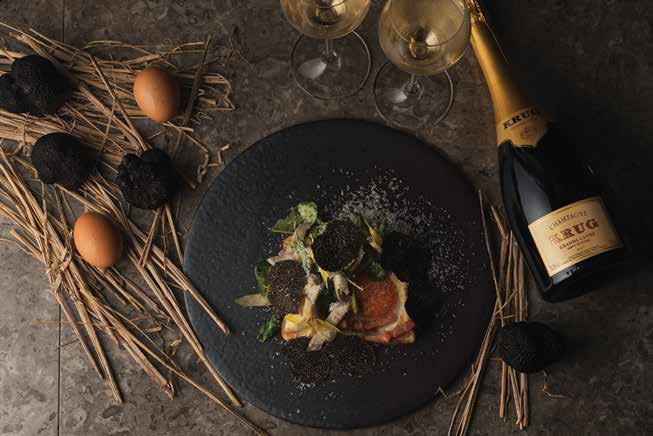
The concept for Margotto was born in owner Robert Hori’s home, where he would serve truffle dishes paired with selections from his wine cellar.
higher at the beginning of the season.
The wine list is chock full of Bordeaux and Burgundy stars, along with rare French, Italian, and Spanish wines of limited production. As Hawai‘i’s only Krug ambassador restaurant, Margotto serves the house’s full line of Champagnes.
Hori designed the clean, contemporary space himself and says he likes guests to feel like they are at a friend’s house—relaxed but not too relaxed. It’s a concept encapsulated in one of the menu’s signatures, the humble Japanese egg-and-rice bowl known as tamago kake gohan, or TKG, made with premium Akitakomachi rice, OK Farms eggs from Waimānalo, and a house-made shoyu that is a blend of 10 imported shoyus and dashi, all topped with truffles. Familiar made fabulous.
堀さんによれば、黒トリュフの冬の値段は1グラム3.75ドル前後。白トリ ュフは1グラム10ドル近くになる。シーズン到来の時期は値段も上がるとのこ と。ワインリストにはボルドーやブルゴーニュ産のトップワインがずらりと並び、 さらにフランス、イタリア、スペインのめずらしいワインも取りそろっている。〈マ ルゴット〉ハワイで唯一のクリュッグのアンバサダー・レストランでもあり、クリュ ッグのシャンパンのフルセレクションも用意されている。
堀さん自身がデザインしたモダンで清潔感あふれる空間。訪れる人に は、友人の家を訪れたように感じてほしいそうだ。くつろいではいるけれど、く つろぎすぎない空間。その願いは〈マルゴット〉の看板メニューのひとつである 素朴な“卵かけごはん”、またの名を“TKG”に要約されている。最高級のあきた こまちにワイマナロの〈OK農場〉の卵、日本から輸入した10種の醤油と出汁を 合わせた自家製醤油だれ、それにトリュフをかけた卵かけごはん。おなじみの 一品だからこそ、よりいっそう味わい深く感じられるはずだ。
PALM
118
FARE Promotional F
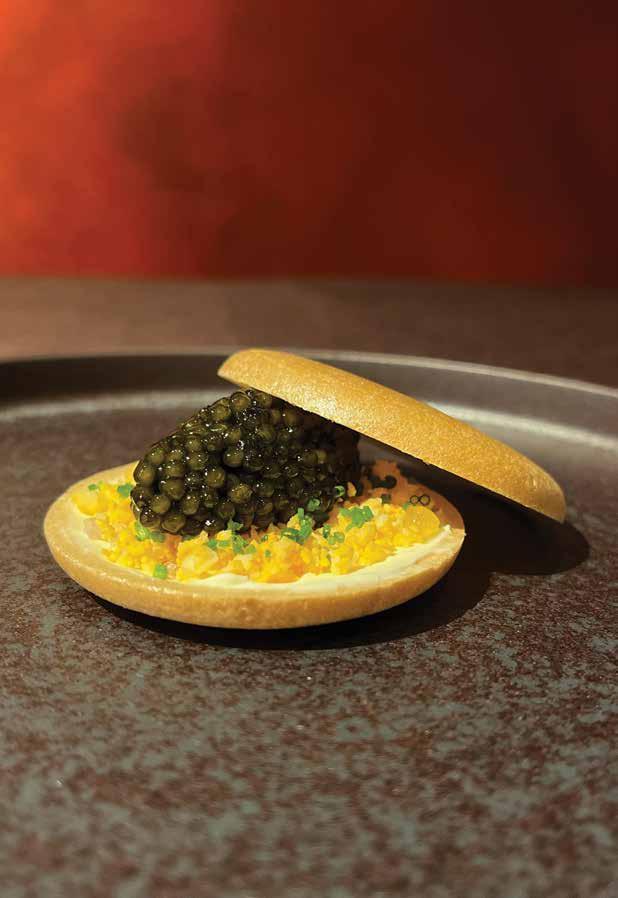 Margotto Hawai‘i delivers a successful marriage of French and Japanese cuisines, with a shot of Italian. Think haute cuisine with dashi.
Margotto Hawai‘i delivers a successful marriage of French and Japanese cuisines, with a shot of Italian. Think haute cuisine with dashi.
Thicker than Water
With a mission that goes beyond sustainably sourced bottled water, Hilo’s Waiākea Water is dedicated to nourishing healthy communities at home and beyond.
Text by Jason Walter
by Brittney Baker, Ivana Cook, and Matty Leong
Founded in 2012 in Hilo, Hawai‘i, as the first triplebottom-line bottled water company of its kind, Waiākea is committed to putting people and the planet before profit. Waiākea’s naturally alkaline water is collected from a privately owned deep well connected to the Kea‘au aquifer, a continuously replenishing source filtered through the porous volcanic rock of Mauna Loa on Hawai‘i Island, the largest active volcano on the planet.
A certified carbon-neutral company, Waiākea was the first in the U.S. market to offer 100 percent post-consumer recycled plastic bottles and has since taken a step further by debuting a bottle made of what the company refers to as OceanPlast.® For each OceanPlast® bottle purchased, Waiākea collects the equivalent of up to five plastic water bottles collected within 30 miles of a beach, oceanbound waterway, or coastal city. Waiākea’s OceanPlast® bottles have the lowest carbon footprint of any single-use beverage packaging on the market, the majority of which are made from virgin plastic. In recent years, Waiākea has introduced new products to give consumers additional sustainable options to fit their lifestyle, including water packaged in a refillable aluminum bottle launched in partnership with local pro surfer Coco Ho and a spouted box for bulk transport and consumption.
Along with its work in sustainability, Waiākea is dedicated to giving back. For each case of water sold, the company donates a month’s worth of clean water to rural communities in Malawi, Africa. Waiākea has provided more than 6 billion liters of clean water through its partnership with the nonprofit Pump Aid, an organization dedicated to ending water poverty in disadvantaged communities in the region.
Through its Kōkua Initiative, Waiākea also supports the most vulnerable in the Hawaiian Islands. Each month,
the company holds a food drive in Hilo to benefit The Food Basket, Hawai‘i Foodbank, and a rotating nonprofit organization to raise awareness and collect donations of food, goods, and essential items. To date, Waiākea has worked with more than 80 nonprofit organizations throughout the islands, and the brand also partners with Meals on Wheels and the American Red Cross.
At home and beyond Hawai‘i’s shores, the brand and its ‘ohana (family) of athletes and ambassadors champion a variety of charitable causes. From fundraising for philanthropic efforts in collaboration with Hilo natives Kolten Wong of the Milwaukee Brewers and artist Aaron Kai, to partnering with NBA superstar Klay Thompson and his charity, the Thompson Family Foundation, along with MLB All-Star Aaron Judge and his All Rise Foundation, Waiākea is leading with aloha to help others around the world and to ensure a better future for the next generation.
PALM
120 F FARE Promotional
Images


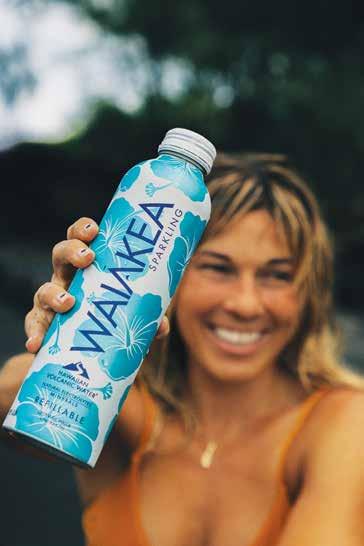
Sustainably sourced, sustainably packaged, and certified carbon neutral,
Water is committed to putting people and the planet before profit.
Waiākea
Serenity in Spades
Tranquil moments abound at this Gold Coast retreat at the edge of Waikīkī.
Text by Lindsey Kesel Images courtesy of Lotus Honolulu

Tucked between Waikīkī and Diamond Head, Lotus Honolulu is an elegant and thoughtfully designed boutique hotel that comes with creative touches and a curious twist on classic French cuisine. For travelers seeking a unique and unforgettable Hawai‘i experience, or locals craving a quiet spot for staycation, this AAA Three Diamond escape has something for everyone—upscale island-chic décor, rooms with a view of Hawai‘i’s famed Gold Coast or majestic Diamond Head crater, a treasure trove of amenities designed to pamper, and incredible dining experiences curated by a world-class chef.
Soak in moments of tranquility, dive into the excitement of Waikīkī Beach, or do a little of both; Lotus Honolulu is a perfectly packaged mix of relaxation and adventure. Slightly removed from the hustle and bustle of Hawai‘i’s most popular destination, the inviting property is just steps away from Kaimana Beach—a more intimate sun-and-sand setting on the east end of Waikīkī Beach—and unexpected extras make guests feel like VIPs: Unlimited parking, 24/7 Wi-Fi access throughout the hotel, nightly wine tastings, Saturday morning yoga, fitness equipment, and in-room espresso are all free of charge.
PALM
122 F FARE Promotional

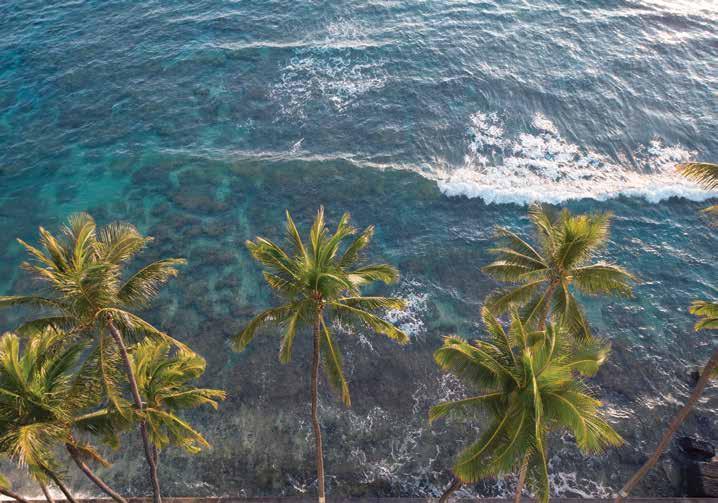
Visitors planning to head up to the North Shore or traverse other parts of the island can tap into Lotus Honolulu’s stress-free car rental service though the Hui app. Accessible right from the property and with just a few clicks, guests can get behind the wheel of an insured vehicle for an hour or a full day. For a greener way to see the South Shore, hop on one of the hotel’s beachcruiser bikes and pedal around the expansive Kapi‘olani Park, or cruise along the Ala Wai Canal promenade on your way to Ala Moana Beach Park, the half-mile-long beach on the west end of Waikīkī.
After a full day of exploring, fuel your body and spirit at the award-winning dining oasis on Lotus Honolulu’s second floor, TBD…by Vikram Garg—a place where culture, cuisine, and conversation are curated and plated to perfection. The restaurant debuted in 2019 as a pop-up experience and quickly amassed a following. Famous for his ingenuity in Michelin-starred kitchens around the world, Chef Garg delights TBD patrons with reimagined French dishes and creative combinations of seasonal, local, and sustainable ingredients.
Guests of Lotus Honolulu are given exclusive access to Table V at TBD, where Chef Garg custom curates the evening’s menu for a private seating of four to 10 guests and prepares five or more courses inspired by his globespanning career. This incomparable escapade with a world-renowned taste master is limited to one group per evening, so be sure to reserve in advance.
124 PALM
FARE Promotional F
Located just steps from Kaimana Beach, Lotus Honolulu is an oasis on Hawai‘i’s famed Gold Coast.
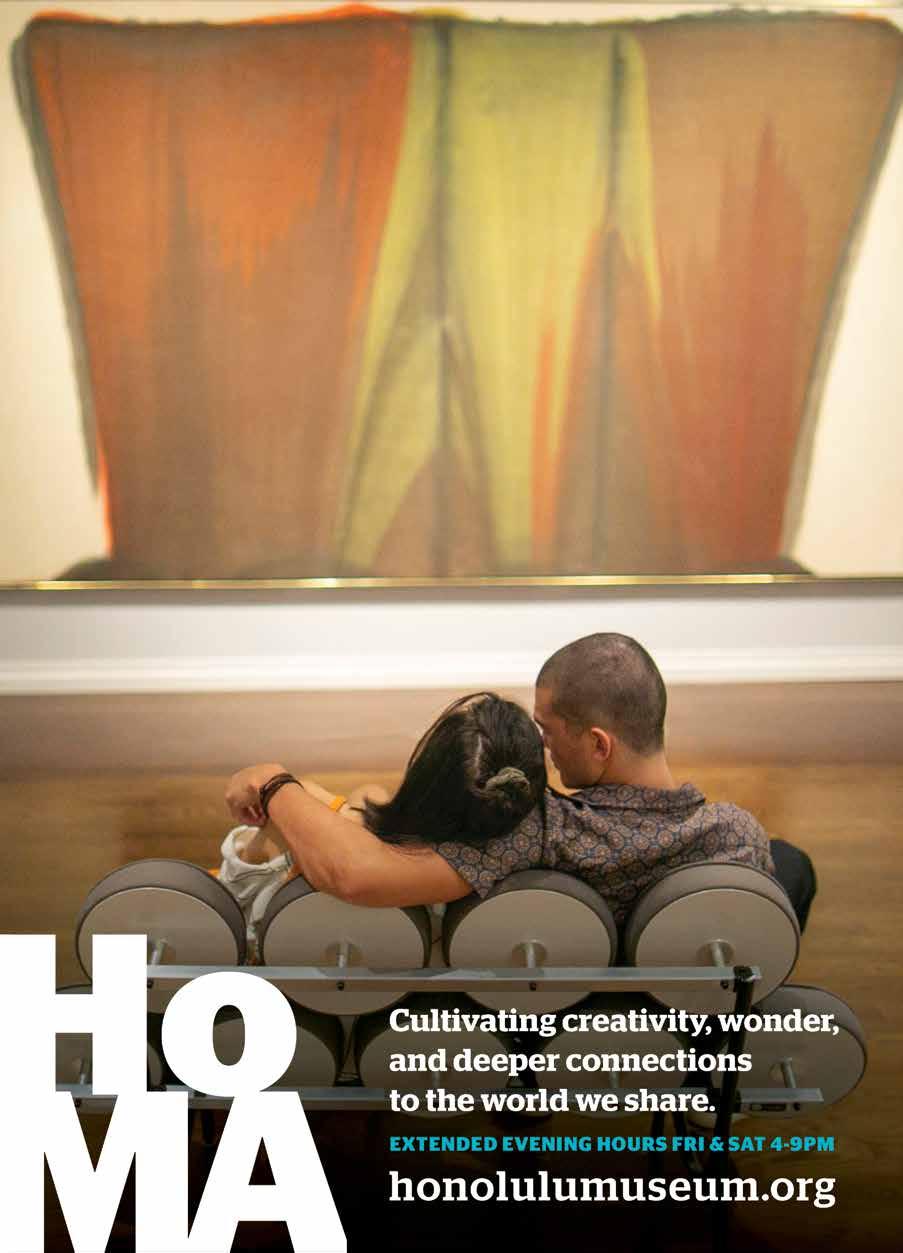

Introducing Ālia
A sustainably designed luxury high-rise, Alia is perfect for individuals and families seeking an exceptional home close to vibrant Ala Moana Center and Kaka‘ako. A diverse selection of one-, two-, and three-bedroom residences are equipped with floor-to-ceiling windows, private lanai, and incomparable views of Diamond Head, downtown Honolulu, and the Ko‘olau Mountains. Relaxed, natural interiors and gathering spaces are adorned with curated art and furnishings, and verdant landscaping, an expansive lawn, and communal open-air environments bring the outside in. An abundance of thoughtful amenities unmatched on O‘ahu make it effortless to lead a modern, active, and social lifestyle. When life happens where you live, you know you’re in the right place.


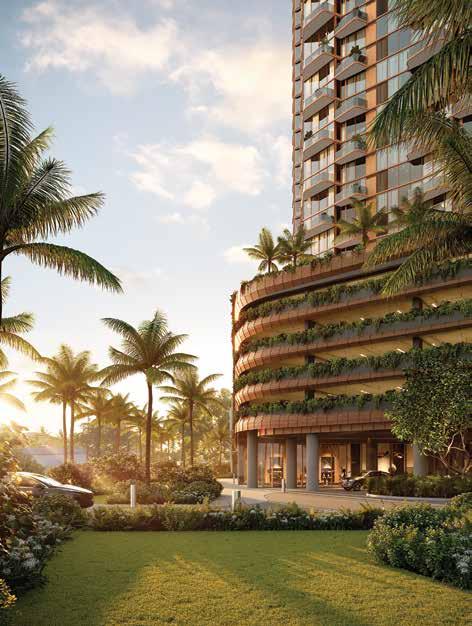
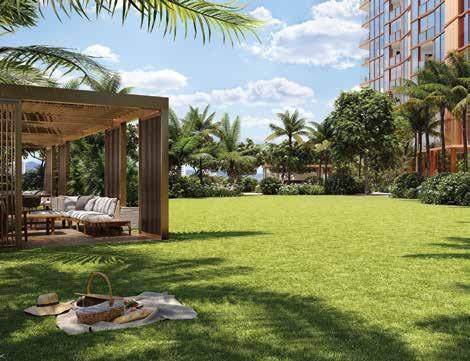
Coming Soon All the possibilities of a private residence and social community. alia888alamoana.com/palm
Renderings by Steelblue
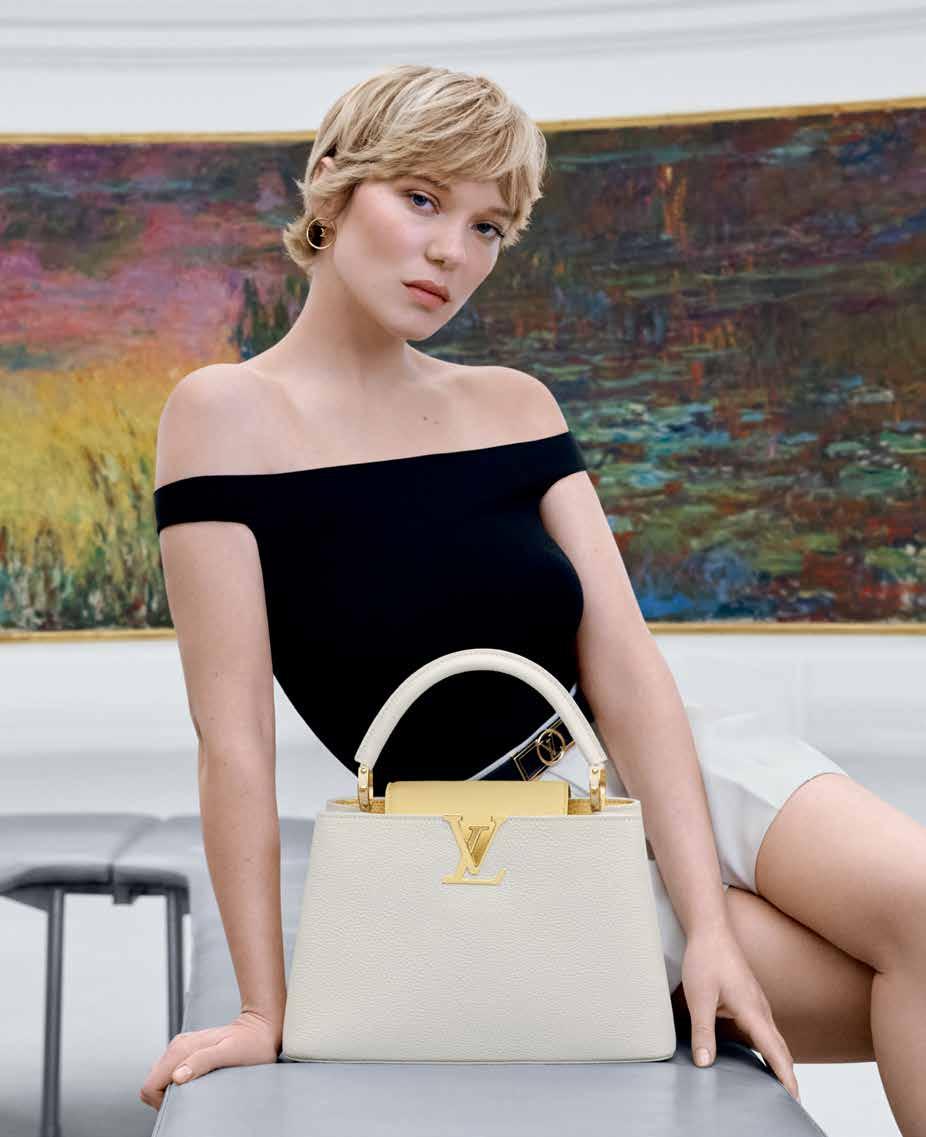










































 Clockwise from top right, individual works from the series Suiseki (2016), Void Stones (2019), and Islands (2019).
Clockwise from top right, individual works from the series Suiseki (2016), Void Stones (2019), and Islands (2019).


























 Giorgio Armani scalloped crochet maxi dress, Lele Sadoughi pearly crochet raffia bucket hat, Marc Jacobs Snapchat colorblock camera crossbody bag, and Stephen Dweck necklace, all from Neiman Marcus.
Giorgio Armani scalloped crochet maxi dress, Lele Sadoughi pearly crochet raffia bucket hat, Marc Jacobs Snapchat colorblock camera crossbody bag, and Stephen Dweck necklace, all from Neiman Marcus.



 Alexander McQueen blazer, puffin mini loop shoulder bag by Simon Miller, earrings by Shashi.
Alexander McQueen blazer, puffin mini loop shoulder bag by Simon Miller, earrings by Shashi.
 CeliaB Alvis embroidered tiered midi dress, earrings by Petit Moments.
CeliaB Alvis embroidered tiered midi dress, earrings by Petit Moments.
 Moncler Ghany puffer vest, Akris Punto colorblock wool pullover, and Marc Jacobs Snapchat colorblock camera crossbody bag, all from Neiman Marcus. Sunglasses from CosmicEyewear, earrings by Petit Moments.
Moncler Ghany puffer vest, Akris Punto colorblock wool pullover, and Marc Jacobs Snapchat colorblock camera crossbody bag, all from Neiman Marcus. Sunglasses from CosmicEyewear, earrings by Petit Moments.
 Akris Punto organdy jacquard dot midi dress and jacquard dot techno organdy jacket from Neiman Marcus, sandals by Massimo Dutti, rectangular hoop earrings from Lana Jewelry, bracelets by Mejuri.
Akris Punto organdy jacquard dot midi dress and jacquard dot techno organdy jacket from Neiman Marcus, sandals by Massimo Dutti, rectangular hoop earrings from Lana Jewelry, bracelets by Mejuri.






 Scenes from the surf towns of Lobitos, Huanchaco, and Máncora, also pictured on opposite page.
Scenes from the surf towns of Lobitos, Huanchaco, and Máncora, also pictured on opposite page.



 A Huanchaco fisherman crafts a caballito de totora (“little reed horse”), a traditional Peruvian watercraft thought to be the world’s first surfing vessel.
A Huanchaco fisherman crafts a caballito de totora (“little reed horse”), a traditional Peruvian watercraft thought to be the world’s first surfing vessel.














 Lava flows from the 2018 eruption in the Puna district of Hawai’i Island buried the road that once connected Highway 132 to Pohoiki Bay.
Lava flows from the 2018 eruption in the Puna district of Hawai’i Island buried the road that once connected Highway 132 to Pohoiki Bay.


















 Margotto Hawai‘i delivers a successful marriage of French and Japanese cuisines, with a shot of Italian. Think haute cuisine with dashi.
Margotto Hawai‘i delivers a successful marriage of French and Japanese cuisines, with a shot of Italian. Think haute cuisine with dashi.












